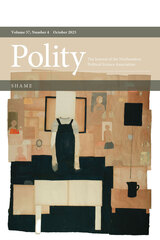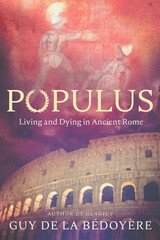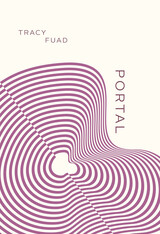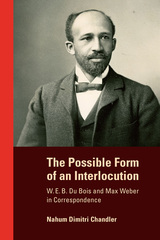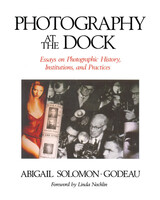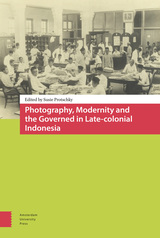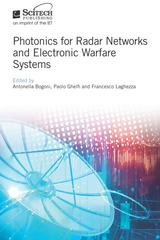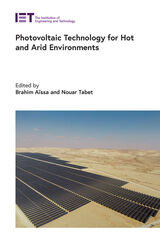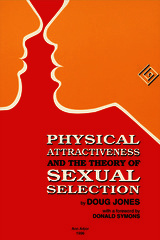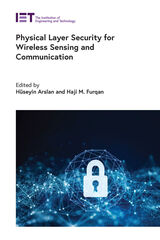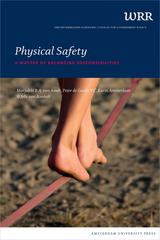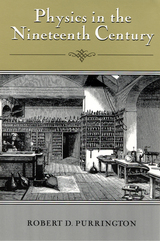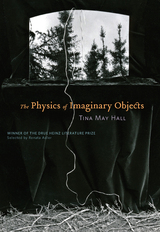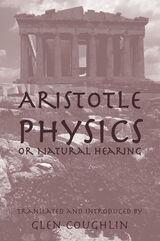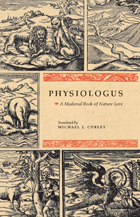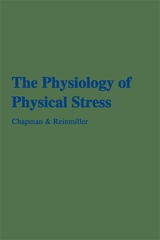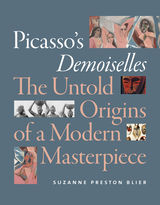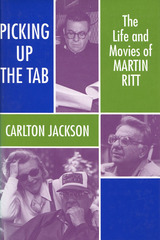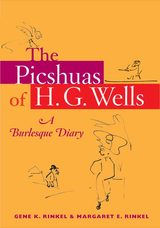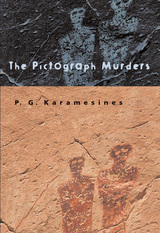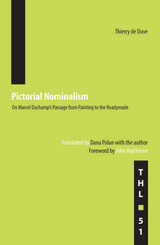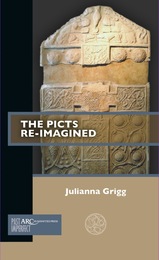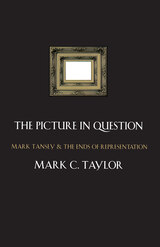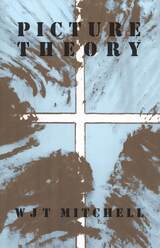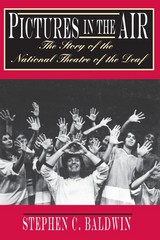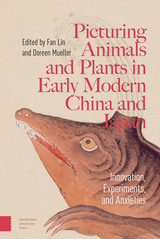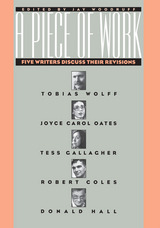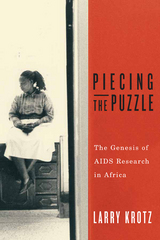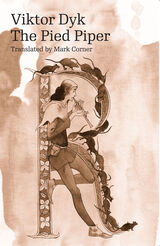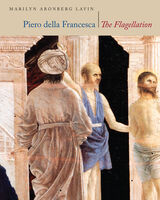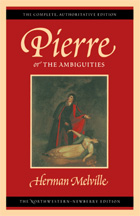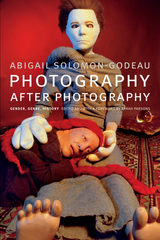 Photography after Photography: Gender, Genre, History
Abigail Solomon-Godeau
Duke University Press, 2017 Presenting two decades of work by Abigail Solomon-Godeau, Photography after Photography is an inquiry into the circuits of power that shape photographic practice, criticism, and historiography. As the boundaries that separate photography from other forms of artistic production are increasingly fluid, Solomon-Godeau, a pioneering feminist and politically engaged critic, argues that the relationships between photography, culture, gender, and power demand renewed attention. In her analyses of the photographic production of Cindy Sherman, Robert Mapplethorpe, Susan Meiselas, Francesca Woodman, and others, Solomon-Godeau refigures the disciplinary object of photography by considering these practices through an examination of the determinations of genre and gender as these shape the relations between photographers, their images, and their viewers. Among her subjects are the 2006 Abu Ghraib prison photographs and the Cold War-era exhibition The Family of Man, insofar as these illustrate photography's embeddedness in social relations, viewing relations, and ideological formations.
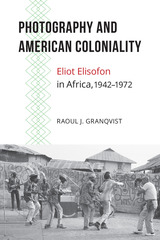 Photography and American Coloniality: Eliot Elisofon in Africa, 1942–1972
Raoul J. Granqvist
Michigan State University Press, 2017 This book is the first to question both why and how the colonialist mythologies represented by the work of photographer Eliot Elisofon persist. It documents and discusses a heterogeneous practice of American coloniality of power as it explores Elisofon’s career as war photographer-correspondent and staff photographer for LIFE, filmmaker, author, artist, and collector of “primitive art” and sculpture. It focuses on three areas: Elisofon’s narcissism, voyeurism, and sexism; his involvement in the homogenizing of Western social orders and colonial legacies; and his enthused mission of “sending home” a mass of still-life photographs, annexed African artifacts, and assumed vintage knowledge. The book does not challenge his artistic merit or his fascinating personality; what it does question is his production and imagining of “difference.” As the text travels from World War II to colonialism, postcolonialism, and the Cold War, from Casablanca to Leopoldville (Kinshasa), it proves to be a necessarily strenuous and provocative trip.
 Photography and Landscape
Rod Giblett and Juha Tolonen
Intellect Books, 2012 With a focus on the settler societies of the United States and Australia, Photography and Landscape is a new critical account of landscape photography created through a unique collaboration between a photography writer and a landscape photographer. Beginning with the frontier days of the American West, the subsequent century-long popularity of landscape photography is exemplified by images from Carleton Watkins to Ansel Adams, the New Topographics to Richard Misrach, all of whose works are considered here. Along with discussions of other contemporary photographers, this extensively illustrated volume demonstrates the influence of settler societies on landscape photography, in which skilled photographers captured the fascination with and the appeal of the land and its expanse. The latest installment in Intellect’s Critical Photography series, Photography and Landscape is a visually striking introduction to one of the most important modes of photography.
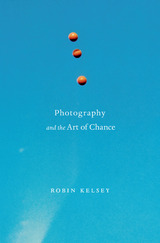 Photography and the Art of Chance
Robin Kelsey
Harvard University Press, 2015 Photography has a unique relationship to chance. Anyone who has wielded a camera has taken a picture ruined by an ill-timed blink or enhanced by an unexpected gesture or expression. Although this proneness to chance may amuse the casual photographer, Robin Kelsey points out that historically it has been a mixed blessing for those seeking to make photographic art. On the one hand, it has weakened the bond between maker and picture, calling into question what a photograph can be said to say. On the other hand, it has given photography an extraordinary capacity to represent the unpredictable dynamism of modern life. By delving into these matters, Photography and the Art of Chance transforms our understanding of photography and the work of some of its most brilliant practitioners.
The effort to make photographic art has involved a call and response across generations. From the introduction of photography in 1839 to the end of the analog era, practitioners such as William Henry Fox Talbot, Julia Margaret Cameron, Alfred Stieglitz, Frederick Sommer, and John Baldessari built upon and critiqued one another’s work in their struggle to reconcile aesthetic aspiration and mechanical process. The root problem was the technology’s indifference, its insistence on giving a bucket the same attention as a bishop and capturing whatever wandered before the lens. Could such an automatic mechanism accommodate imagination? Could it make art? Photography and the Art of Chance reveals how daring innovators expanded the aesthetic limits of photography to create art for a modern world.
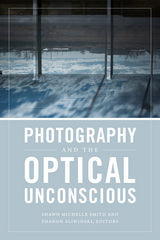 Photography and the Optical Unconscious
Shawn Michelle Smith and Sharon Sliwinski, editors
Duke University Press, 2017 Photography is one of the principal filters through which we engage the world. The contributors to this volume focus on Walter Benjamin's concept of the optical unconscious to investigate how photography has shaped history, modernity, perception, lived experience, politics, race, and human agency. In essays that range from examinations of Benjamin's and Sigmund Freud's writings to the work of Kara Walker and Roland Barthes's famous Winter Garden photograph, the contributors explore what photography can teach us about the nature of the unconscious. They attend to side perceptions, develop latent images, discover things hidden in plain sight, focus on the disavowed, and perceive the slow. Of particular note are the ways race and colonialism have informed photography from its beginning. The volume also contains photographic portfolios by Zoe Leonard, Kelly Wood, and Kristan Horton, whose work speaks to the optical unconscious while demonstrating how photographs communicate on their own terms. The essays and portfolios in Photography and the Optical Unconscious create a collective and sustained assessment of Benjamin's influential concept, opening up new avenues for thinking about photography and the human psyche.
Contributors. Mary Bergstein, Jonathan Fardy, Kristan Horton, Terri Kapsalis, Sarah Kofman, Elisabeth Lebovici, Zoe Leonard, Gabrielle Moser, Mignon Nixon, Thy Phu, Mark Reinhardt, Shawn Michelle Smith, Sharon Sliwinski, Laura Wexler, Kelly Wood, Andrés Mario Zervigón
 Photography and Work
Kevin Coleman, Daniel James, and Jayeeta Sharma, special issue editors
Duke University Press, 2018 What makes photographs different from other kinds of documents that historians use to explain what happened in the past? What can photographic images do that other documents cannot? Can photography accurately depict labor? Contributors to this issue examine these questions with both fine art photography and visual archives of many kinds: state, corporate, family, trade union, ethnographic, photojournalistic, and environmental. They investigate the ways that photography has been central to both the expropriation and exploitation of labor and the potential of photography to enable new and radical approaches to historicizing the study of working peoples and labor. Articles showcase methodologically generative research that builds upon the recent boom in theoretical work in the fields of visual cultural studies and photography to reinvigorate historical studies of work.
Contributors: Siobhan Angus, Ian Bourland, Oliver Coates, Kevin Coleman, Clare Corbould, Adrian De Leon, Rick Halpern, Daniel James, Tong Lam, Walter Benn Michaels, Jessica Stites Mor, Carol Quirke, Jayeeta Sharma, Erica Toffoli, Daniel Zamora
 Photography, Cinema, Memory: The Crystal Image of Time
Damian Sutton
University of Minnesota Press, 2009 A philosophical investigation into the differing sensations of time in cinema and photography Cinema and photography are both intimately associated with time—cinema with time in passing, the photograph with the lost moment. In Photography, Cinema, Memory, Damian Sutton explores time in both media to present a radical new understanding of the photographic image as always coming into being. Drawing on Gilles Deleuze’s concept of the crystal image to move beyond the tropes of immobility, stasis, and death, Sutton’s analysis reveals the open-endedness of time expressed in the photograph, either as a potential for an abundant future or as a depth of meandering remembrance. He presents an innovative taxonomy of time in the photograph, considering particular representations of time in the work of Nan Goldin, Eugène Atget, Andy Warhol, and others. He contrasts this taxonomy with representations of time in cinema since 1895, offering fresh readings of the films of the Lumière brothers and Mitchell & Kenyon, as well as more recent works, including Eternal Sunshine of the Spotless Mind, Amélie, and A Matter of Life and Death. Throughout this work, Sutton connects and grounds cinema and photography as starting points to comprehend how we come to terms, ultimately, with time itself as pure, immanent change.
Photography from the Turin Shroud to the Turing Machine
Yanai Toister
Intellect Books, 2020 This book introduces two conceptual models of photography: the Turin Shroud and the universal Turing machine. The Turin Shroud inspires a discussion on photography’s frequently acclaimed “ontological privilege,” which has conditioned an understanding of photography as a sui generis breed of images wherein pictorial representation is coextensive with human vision. This is then contrasted with a discussion on the universal Turing machine, which integrates photography into a framework of media philosophy and algorithmic art. Here, photography becomes more than just the present-day sum of its depiction traditions, devices, and dissemination networks. Rather, it is archetypical of multiple systems of abstraction and classification, and various other symbolic processes of transformation.
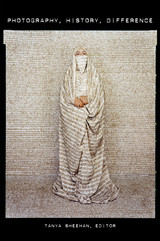 Photography, History, Difference
Edited by Tanya Sheehan
Dartmouth College Press, 2014 Over the past decade, historical studies of photography have embraced a variety of cultural and disciplinary approaches to the medium, while shedding light on non-Western, vernacular, and “other” photographic practices outside the Euro-American canon. Photography, History, Difference brings together an international group of scholars to reflect on contemporary efforts to take a different approach to photography and its histories. What are the benefits and challenges of writing a consolidated, global history of photography? How do they compare with those of producing more circumscribed regional or thematic histories? In what ways does the recent emphasis on geographic and national specificity encourage or exclude attention to other forms of difference, such as race, class, gender, and sexuality? Do studies of “other” photographies ultimately necessitate the adoption of nontraditional methodologies, or are there contexts in which such differentiation can be intellectually unproductive and politically suspect? The contributors to the volume explore these and other questions through historical case studies; interpretive surveys of recent historiography, criticism, and museum practices; and creative proposals to rethink the connections between photography, history, and difference. A thought-provoking collection of essays that represents new ways of thinking about photography and its histories. It will appeal to a broad readership among those interested in art history, visual culture, media studies, and social history.
Photography, Modernity and the Governed in Late-colonial Indonesia
Edited by Susie Protschky
Amsterdam University Press, 2015 The essays in this volume examine, from a historical perspective, how contested notions of modernity, civilization, and being governed were envisioned through photography in early twentieth-century Indonesia, a period when the Dutch colonial regime was implementing a liberal reform program known as the Ethical Policy. The contributors reveal how the camera evoked diverse, often contradictory modes of envisioning an ethically governed colony, one in which the very concepts of modernity and civilization were subject to dispute.
Photography, Narrative, Time: Imaging our Forensic Imagination
Greg Battye
Intellect Books, 2014 Providing a wide-ranging account of the narrative properties of photographs, Greg Battye focuses on the storytelling power of a single image, rather than the sequence. Drawing on ideas from painting, drawing, film, video, and multimedia, he applies contemporary research and theories drawn from cognitive science and psychology to the analysis of photographs. Using genuine forensic photographs of crime scenes and accidents, the book mines human drama and historical and sociological authenticity to argue for the centrality of the perception and representation of time in photographic narrativity.
 The Photography of Gustave Le Gray
Eugenia Parry Janis
University of Chicago Press, 1987 Gustave Le Gray (1820-1882) was one of the most technically accomplished and aesthetically enlightened of the early "artist-photographers." Trained as a painter of portraits and landscapes, Le Gray was attracted in the 1840s to the artistic potential of photographic processes. As a photographer he evolved and refined much of photography's primary aesthetic theory. By 1855 he had influenced, if not taught, every important photographer in France.
Drawing on entirely new material Eugenia Parry Janis fully analyzes the life and work of Le Gray and demonstrates the originality of his artistic achievement in the context of discoveries about his personal and professional history. Janis, approaching the photographs of Le Gray with the methods and sensibilities of an art historian, reveals telling connections between Le Gray's choices of subject matter and formal means of presentation and the existing pictorial practice of other media such as painting. This same approach makes her sensitive to Le Gray's departures from such traditional practice, and she skillfully illustrates how he evolved from student painter into master photographer. In doing so she gives us a glimpse of the way in which Le Gray's manipulation of the photographic process was always informed by his pictorial needs and by his developing style.
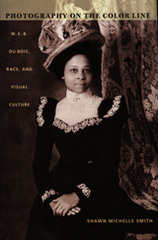 Photography on the Color Line: W. E. B. Du Bois, Race, and Visual Culture
Shawn Michelle Smith
Duke University Press, 2004 Through a rich interpretation of the remarkable photographs W. E. B. Du Bois compiled for the American Negro Exhibit at the 1900 Paris Exposition, Shawn Michelle Smith reveals the visual dimension of the color line that Du Bois famously called “the problem of the twentieth century.” Du Bois’s prize-winning exhibit consisted of three albums together containing 363 black-and-white photographs, mostly of middle-class African Americans from Atlanta and other parts of Georgia. Smith provides an extensive analysis of the images, the antiracist message Du Bois conveyed by collecting and displaying them, and their connection to his critical thought. She contends that Du Bois was an early visual theorist of race and racism and demonstrates how such an understanding makes the important concepts he developed—including double consciousness, the color line, the Veil, and second sight—available to visual culture and African American studies scholars in powerful new ways. Smith reads Du Bois’s photographs in relation to other turn-of-the-century images such as scientific typologies, criminal mugshots, racist caricatures, and lynching photographs. By juxtaposing these images with reproductions from Du Bois’s exhibition archive, Smith shows how Du Bois deliberately challenged racist representations of African Americans. Emphasizing the importance of comparing multiple visual archives, Photography on the Color Line reinvigorates understandings of the stakes of representation and the fundamental connections between race and visual culture in the United States.
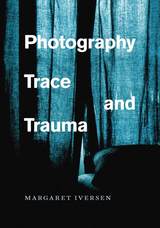 Photography, Trace, and Trauma
Margaret Iversen
University of Chicago Press, 2017 Photography is often associated with the psychic effects of trauma: the automatic nature of the process, wide-open camera lens, and light-sensitive film record chance details unnoticed by the photographer—similar to what happens when a traumatic event bypasses consciousness and lodges deeply in the unconscious mind. Photography, Trace, and Trauma takes a groundbreaking look at photographic art and works in other media that explore this important analogy.
Examining photography and film, molds, rubbings, and more, Margaret Iversen considers how these artistic processes can be understood as presenting or simulating a residue, trace, or “index” of a traumatic event. These approaches, which involve close physical contact or the short-circuiting of artistic agency, are favored by artists who wish to convey the disorienting effect and elusive character of trauma. Informing the work of a number of contemporary artists—including Tacita Dean, Jasper Johns, Mary Kelly, Gabriel Orozco, and Gerhard Richter—the concept of the trace is shown to be vital for any account of the aesthetics of trauma; it has left an indelible mark on the history of photography and art as a whole.
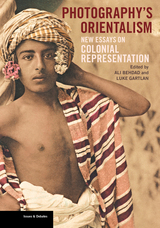 Photography's Orientalism: New Essays on Colonial Representation
Ali Behdad
J. Paul Getty Trust, The, 2013 The Middle East played a critical role in the development of photography as a new technology and an art form. Likewise, photography was instrumental in cultivating and maintaining Europe’s distinctively Orientalist vision of the Middle East. As new advances enhanced the versatility of the medium, nineteenth-century photographers were able to mass-produce images to incite and satisfy the demands of the region’s burgeoning tourist industry and the appetites of armchair travelers in Europe. In this way, the evolution of modern photography fueled an interest in visual contact with the rest of the world.
Photography’s Orientalism offers the first in-depth cultural study of the works of European and non- European photographers active in the Middle East and India, focusing on the relationship between photographic, literary, and historical representations of this region and beyond. The essays explore the relationship between art and politics by considering the connection between the European presence there and aesthetic representations produced by traveling and resident photographers, thereby contributing to how the history of photography is understood.
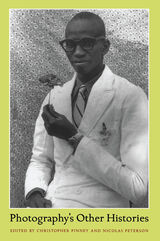 Photography's Other Histories
Christopher Pinney and Nicolas Peterson, eds.
Duke University Press, 2003 Moving the critical debate about photography away from its current Euro-American center of gravity, Photography’s Other Histories breaks with the notion that photographic history is best seen as the explosion of a Western technology advanced by the work of singular individuals. This collection presents a radically different account, describing photography as a globally disseminated and locally appropriated medium. Essays firmly grounded in photographic practice—in the actual making of pictures—suggest the extraordinary diversity of nonwestern photography. Richly illustrated with over 100 images, Photography’s Other Histories explores from a variety of regional, cultural, and historical perspectives the role of photography in raising historical consciousness. It includes two first-person pieces by indigenous Australians and one by a Seminole/Muskogee/Dine' artist. Some of the essays analyze representations of colonial subjects—from the limited ways Westerners have depicted Navajos to Japanese photos recording the occupation of Manchuria to the changing "contract" between Aboriginal subjects and photographers. Other essays highlight the visionary quality of much popular photography. Case studies centered in early-twentieth-century Peru and contemporary India, Kenya, and Nigeria chronicle the diverse practices that have flourished in postcolonial societies. Photography’s Other Histories recasts popular photography around the world, as not simply reproducing culture but creating it.
Contributors. Michael Aird, Heike Behrend, Jo-Anne Driessens, James Faris, Morris Low, Nicolas Peterson, Christopher Pinney, Roslyn Poignant, Deborah Poole, Stephen Sprague, Hulleah Tsinhnahjinnie, Christopher Wright
Photonic Integrated Circuits: Integration platforms, building blocks and design rules
Guillermo Carpintero
The Institution of Engineering and Technology, 2019 A photonic integrated circuit (PIC) can be seen as a 'light-based' analogue of an electronic circuit (i.e. where functionality occurs by manipulation of light rather than electrical current). Much research has gone into this area and this well-organised book sheds light on the technology behind PICs and the capabilities of the various platforms available. It provides an engineering approach to photonic integration technologies from the fundamental concepts, through to assembly issues and the integration strategies to combine different components in a single chip.
Photonics for Radar Networks and Electronic Warfare Systems
Antonella Bogoni
The Institution of Engineering and Technology, 2019 Microwave photonics is an emerging interdisciplinary area that investigates the deep interactions between microwaves and light waves for efficient generation, distribution, processing, control, and sensing of microwave, millimeter-wave, and terahertz signals. This book outlines the potential for microwave photonics in radar and electronic warfare systems, covering basic concepts and functions, comparing performance with conventional systems, describing its impact on digital signal processing, and exploring integration issues.
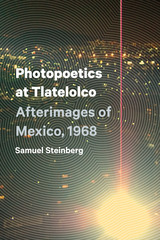 Photopoetics at Tlatelolco: Afterimages of Mexico, 1968
By Samuel Steinberg
University of Texas Press, 2016 In the months leading up to the 1968 Olympic games in Mexico City, students took to the streets, calling for greater democratization and decrying crackdowns on political resistance by the ruling PRI party. During a mass meeting held at the Plaza of the Three Cultures in the Tlatelolco neighborhood, paramilitary forces opened fire on the gathering. The death toll from the massacre remains a contested number, ranging from an official count in the dozens to estimates in the hundreds by journalists and scholars. Rereading the legacy of this tragedy through diverse artistic-political interventions across the decades, Photopoetics at Tlatelolco explores the state’s dual repression—both the massacre’s crushing effects on the movement and the manipulation of cultural discourse and political thought in the aftermath. Examining artifacts ranging from documentary photography and testimony to poetry, essays, chronicles, cinema, literary texts, video, and performance, Samuel Steinberg considers the broad photographic and photopoetic nature of modern witnessing as well as the specific elements of light (gunfire, flares, camera flashes) that ultimately defined the massacre. Steinberg also demonstrates the ways in which the labels of “massacre” and “sacrifice” inform contemporary perceptions of the state’s blatant and violent repression of unrest. With implications for similar processes throughout the rest of Latin America from the 1960s to the present day, Photopoetics at Tlatelolco provides a powerful new model for understanding the intersection of political history and cultural memory.
Photovoltaic Technology for Hot and Arid Environments
Brahim Aïssa
The Institution of Engineering and Technology, 2023 The need to reduce greenhouse gas emissions and dependency on fossil fuels necessitates accelerated deployment of renewable energy, such as photovoltaics (PV). Regions with high insolation in the "Sun Belt" covering north Africa and the middle east, as well as in Australia, parts of Latin America, and elsewhere offer tremendous potential for PV, including for green hydrogen production. However, these regions are characterized by a hot climate and a dusty environment, both causing reduction of PV panel performance by 25% or more. The development of solar cells with enhanced resistance to thermal degradation and the reduction of panel soiling have therefore been subjects of intense study.
Phyla of Joy
Karen An-hwei Lee
Tupelo Press, 2012 “Karen An-hwei Lee’s third book is a beautiful and sustained meditation on the impermanence of humanity’s essential components: memory, spirituality, emotion, thought….Contemplative and linguistically sophisticated,Phyla of Joy is simply exquisite —‘ink and stanza / flow like wind on grass.’” — Rigoberto González
There’s an undeniable audacity in a poet using the word “joy” in our beleaguered world. In her new book, Karen An-hwei Lee combines scientific precision and an appetite for far-flung vocabularies with a fascination for the sources of rapturous emotion.
In poems that roam from the intimacy of prayer to the art of brewing tea, from bamboo-related famine to quasars, the globe’s minor seas, and the nuptial flight of ants, Phyla of Joy reaches toward ecstasy.
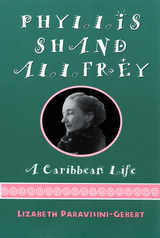 Phyllis Shand Allfrey: A Caribbean Life
Paravisini-Gebert, Lizabeth
Rutgers University Press, 1996 Phyllis Shand Allfrey is the first biography of one of the Caribbean's most intriguing writers and politicians. Allfrey (1908-1986) is best known as the author of The Orchid House, a fictionalized account of her early life that was turned into a highly acclaimed film for British television. Born to a prominent family of formerly wealthy sugar planters in Dominica, Allfrey followed an unexpected path: a rising novelist (who is often paired with Jean Rhys in critical discussion) and Fabian socialist in England and the United States, she returned to Dominica to organize the peasantry and estate workers into the island's first political party. Ostracized by the white elite into which she was born, she led the Dominica Labour party to power and became the West Indian Federation's only woman (and only white) minister, only to find herself expelled from the party when the rise of black nationalism made it expedient. The biography recreates Allfrey's life as it unfolds against the background of twentieth-century Caribbean political and literary history, from the decline of the planter class through the rise of party politics and the efforts to join the anglophone West Indies into a federation, to the troubled sixties and seventies, decades marked by racial violence and the emergence of the former British territories from colonial control. This volume includes five autobiographical stories that have long been out of print.
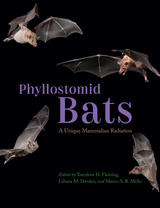 Phyllostomid Bats: A Unique Mammalian Radiation
Edited by Theodore H. Fleming, Liliana M. Dávalos, and Marco A. R. Mello
University of Chicago Press, 2020 With more than two hundred species distributed from California through Texas and across most of mainland Mexico, Central and South America, and islands in the Caribbean Sea, the Phyllostomidae bat family (American leaf-nosed bats) is one of the world’s most diverse mammalian families. From an insectivorous ancestor, species living today, over about 30 million years, have evolved a hyper-diverse range of diets, from blood or small vertebrates, to consuming nectar, pollen, and fruit. Phyllostomid plant-visiting species are responsible for pollinating more than five hundred species of neotropical shrubs, trees, vines, and epiphytes—many of which are economically and ecologically important—and they also disperse the seeds of at least another five hundred plant species. Fruit-eating and seed-dispersing members of this family thus play a crucial role in the regeneration of neotropical forests, and the fruit eaters are among the most abundant mammals in these habitats.
Coauthored by leading experts in the field and synthesizing the latest advances in molecular biology and ecological methods, Phyllostomid Bats is the first overview in more than forty years of the evolution of the many morphological, behavioral, physiological, and ecological adaptations in this family. Featuring abundant illustrations as well as details on the current conservation status of phyllostomid species, it is both a comprehensive reference for these ecologically vital creatures and a fascinating exploration of the evolutionary process of adaptive radiation.
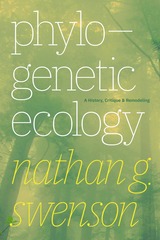 Phylogenetic Ecology: A History, Critique, and Remodeling
Nathan G. Swenson
University of Chicago Press, 2019 Over the past decade, ecologists have increasingly embraced phylogenetics, the study of evolutionary relationships among species. As a result, they have come to discover the field’s power to illuminate present ecological patterns and processes. Ecologists are now investigating whether phylogenetic diversity is a better measure of ecosystem health than more traditional metrics like species diversity, whether it can predict the future structure and function of communities and ecosystems, and whether conservationists might prioritize it when formulating conservation plans.
In Phylogenetic Ecology, Nathan G. Swenson synthesizes this nascent field’s major conceptual, methodological, and empirical developments to provide students and practicing ecologists with a foundational overview. Along the way, he highlights those realms of phylogenetic ecology that will likely increase in relevance—such as the burgeoning subfield of phylogenomics—and shows how ecologists might lean on these new perspectives to inform their research programs.
 A Phylogenetic Fantasy: Overview of the Transference Neuroses
Sigmund Freud
Harvard University Press, 1987 This volume heralds the appearance, for the first time in many years, of a totally new document by Sigmund Freud. It is the draft of a lost metapsychological paper, one of twelve essays written during World War I at the peak of the master's powers. Freud intended to publish all twelve in book form, under the title Preliminaries to a Metapsychology, and thereby set out the theoretical foundations of psychoanalysis. Scholars have long lamented the disappearance without a trace of seven of these important essays.
Only in 1983 did Ilse Grubrich-Simitis happen upon this draft, in Freud's handwriting, in an old trunk containing papers and documents of his Hungarian collaborator Sándor Ferenczi. With the help of a brief letter Freud had written on the back of the last page, she soon realized that the manuscript she had found was the draft of the final paper in the series. That draft is published here in facsimile, together with a transcription in German of the facsimile and the English translation.
In the first part of the draft, which is written in a kind of shorthand, Freud contrasts the three classic transference neuroses: anxiety hysteria, conversion hysteria, and obsessional neurosis. In the second part, which is written in complete sentences, Freud undertakes a daringly speculative "phylogenetic fantasy" He explores whether the debilitating illnesses of the neurotic and the psychotic today might have originated long ago as adaptive responses of the entire species to threatening environmental changes or to traumatic events in the prehistory of mankind.
In the draft "Fantasy" Freud modifies and expands the line of reasoning he began in Totem and Taboo (1912-13) after an intensely productive exchange with Ferenczi about Lamarckian concepts, making this recovered draft of major significance to students not only of psychoanalysis but also of the social sciences, humanities, and natural sciences.
Ilse Grubrich-Simitis has contributed a detailed essay, setting the overview in the context of Freud's life, his work, and his historical and scientific prominence. She quotes from relevant letters of Freud and Ferenczi, some published here for the first time.
Phylogenetic Systematics
Willi Hennig
University of Illinois Press, 1966 Phylogenetic Systematics, first published in 1966, marks a turning point in the history of systematic biology. Willi Hennig's influential synthetic work, arguing for the primacy of the phylogenetic system as the general reference system in biology, generated significant controversy and opened possibilities for evolutionary biology that are still being explored.
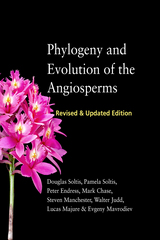 Phylogeny and Evolution of the Angiosperms: Revised and Updated Edition
Douglas Soltis, Pamela Soltis, Peter Endress, Mark Chase, Steven Manchester, Walter Judd, Lucas Majure, and Evgeny Mavrodiev
University of Chicago Press, 2018 Although they are relative latecomers on the evolutionary scene, having emerged only 135‒170 million years ago, angiosperms—or flowering plants—are the most diverse and species-rich group of seed-producing land plants, comprising more than 15,000 genera and over 350,000 species. Not only are they a model group for studying the patterns and processes of evolutionary diversification, they also play major roles in our economy, diet, and courtship rituals, producing our fruits, legumes, and grains, not to mention the flowers in our Valentine’s bouquets. They are also crucial ecologically, dominating most terrestrial and some aquatic landscapes.
This fully revised edition of Phylogeny and Evolution of the Angiosperms provides an up-to-date, comprehensive overview of the evolution of and relationships among these vital plants. Incorporating molecular phylogenetics with morphological, chemical, developmental, and paleobotanical data, as well as presenting a more detailed account of early angiosperm fossils and important fossil information for each evolutionary branch of the angiosperms, the new edition integrates fossil evidence into a robust phylogenetic framework. Featuring a wealth of new color images, this highly synthetic work further reevaluates long-held evolutionary hypotheses related to flowering plants and will be an essential reference for botanists, plant systematists, and evolutionary biologists alike.
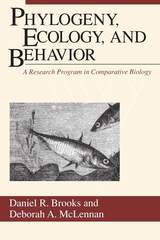 Phylogeny, Ecology, and Behavior: A Research Program in Comparative Biology
Daniel R. Brooks and Deborah A. McLennan
University of Chicago Press, 1991 "The merits of this work are many. A rigorous integration of phylogenetic hypotheses into studies of adaptation, adaptive radiation, and coevolution is absolutely necessary and can change dramatically our collective 'gestalt' about much in evolutionary biology. The authors advance and illustrate this thesis beautifully. The writing is often lucid, the examples are plentiful and diverse, and the juxtaposition of examples from different biological systems argues forcefully for the validity of the thesis. Many new insights are offered here, and the work is usually accessible to both the practiced phylogeneticist and the naive ecologist."—Joseph Travis, Florida State University
"[Phylogeny, Ecology, and Behavior] presents its arguments forcefully and cogently, with ample . . .support. Brooks and McLennan conclude as they began, with the comment that evolution is a result, not a process, and that it is the result of an interaction of a variety of processes, environmental and historical. Evolutionary explanations must consider all these components, else they are incomplete. As Darwin's explanations of descent with modification integrated genealogical and ecological information, so must workers now incorporate historical and nonhistorical, and biological and nonbiological, processes in their evolutionary perspective."—Marvalee H. Wake, Bioscience
"This book is well-written and thought-provoking, and should be read by those of us who do not routinely turn to phylogenetic analysis when investigating adaptation, evolutionary ecology and co-evolution."—Mark R. MacNair, Journal of Natural History
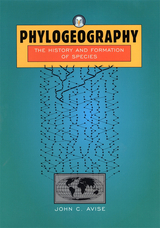 Phylogeography: The History and Formation of Species
John C. Avise
Harvard University Press, 2000 Phylogeography is a discipline concerned with various relationships between gene genealogies—phylogenetics—and geography. The word “phylogeography” was coined in 1987, and since then the scientific literature has reflected an exploding interest in the topic. Yet, to date, no book-length treatment of this emerging field has appeared. Phylogeography: The History and Formation of Species fills that gap.
The study of phylogeography grew out of the observation that mitochondrial DNA lineages in natural populations often display distinct geographic orientations. In recent years, the field has expanded to include assessments of nuclear as well as cytoplasmic genomes and the relationships among gene trees, population demography, and organismal history, often formalized as coalescent theory. Phylogeography has connections to molecular evolutionary genetics, natural history, population biology, paleontology, historical geography, and speciation analysis.
Phylogeography captures the conceptual and empirical richness of the field, and also the sense of genuine innovation that phylogeographic perspectives have brought to evolutionary studies. This book will be essential reading for graduate students and professionals in evolutionary biology and ecology as well as for anyone interested in the emergence of this new and integrative discipline.
Physical and Biophysical Foundations of Pharmacy Practice: Issues in Drug Delivery
Gordon L. Flynn, Michael S. Roberts
Michigan Publishing, 2015 Focused on the physical and biological barriers and opportunities for drug delivery, this book, published in cooperation with the University of Michigan College of Pharmacy, is a peer-reviewed introductory physical pharmacy and biopharmaceutics text that comprehensively addresses the major issues in the field of Pharmacy Practice. It is a must for students wishing to understand the background and mechanics of dosage form technology.
 The Physical and the Digital City: Invisible Forces, Data and Manifestations
Edited by Silvio Carta
Intellect Books, 2024 An introduction to the physical and digital foundations of urban environment.
The Physical and the Digital City is a unique collection of projects wherein researchers and designers show how the theories of technology that underpin digital urban assemblages are applied in practical and spatial terms. The authors are experts in their respective fields who pursue cutting-edge solutions for city-making and consider the theoretical premise critically.
The book is designed to be a self-contained and interdisciplinary reference text to introduce students, designers, and scholars to the idea of urban application and its relation to the physical and the digital. Accessible to both urban planners and cultural theorists, the book will clarify the role of digital technologies within the city, along with its possible implications for people and communities. While the work is oriented to the academic and professional communities interested in architectural, urban, and digital design from different angles, it will appeal to anyone interested in how metropolises embrace digital technologies for more operational efficiency.
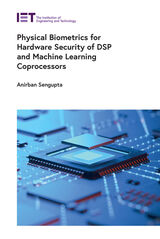 Physical Biometrics for Hardware Security of DSP and Machine Learning Coprocessors
Anirban Sengupta
The Institution of Engineering and Technology, 2023 Physical Biometrics for Hardware Security of DSP and Machine Learning Coprocessors presents state-of-the art explanations for detective control-based security and protection of digital signal processing (DSP) and machine learning coprocessors against hardware threats. Such threats include intellectual property (IP) abuse and misuse, for example, fraudulent claims of IP ownership and IP piracy. DSP coprocessors such as finite impulse response filters, image processing filters, discrete Fourier transform, and JPEG compression hardware are extensively utilized in several real-life applications. Further, machine learning coprocessors such as convolutional neural network (CNN) hardware IP cores play a vital role in several applications such as face recognition, medical imaging, autonomous driving, and biometric authentication, amongst others.
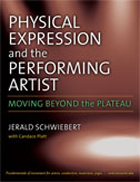 Physical Expression and the Performing Artist: Moving Beyond the Plateau
Jerald Schwiebert
University of Michigan Press, 2011 All performers know that "tuning up the body" is necessary to maximize performance. A person's mannerisms, habitual patterns of movement, and posture can block the capacity for expression, often without the performer even noticing. Physical Expression and the Performing Artist offers an organized approach to movement for actors, conductors, dancers, singers, musicians---for performers of any kind. Capturing the energy of the popular workshops presented by master movement teacher Jerald Schwiebert, the book draws from the wisdom of hatha yoga, tai chi, and Pilates as well as from the teachings of Stanislavski, Structural Integration (Rolfing), Alexander, Feldenkrais, and Laban to provide a fresh and accessible approach to movement. More than 300 anatomical drawings help readers pinpoint specific muscles, joints, and actions as they explore the capacity of the performer's physical instrument, the components of dynamic movement, and the anatomy of expression. The book's many detailed exercises bring awareness of habitual and inefficient movement and introduce the steps necessary for more efficient movement patterns in all parts of the body. This book will prove indispensable in movement courses and as a resource guide for professionals seeking to take their performances to the next level.
Physical Layer Security for 6G Networks
Trung Q. Duong
The Institution of Engineering and Technology, 2024 6G networks are expected to provide one-microsecond latency communication with a billion devices competing for resources 1000 times faster than current standards. Increases in network speed, heterogeneity, virtualization, better radio requirements and adaptive communications will place new demands on physical layer security. Moreover, IoT, blockchain, and artificial intelligence are enabling technologies that require rapid data rates, raising a significant burden on the network's physical layer, requiring that security must be attained at a fast pace, and that the network must be resilient to accommodate sudden changes to the configurations or the load.
Physical Layer Security for Wireless Sensing and Communication
Hüseyin Arslan
The Institution of Engineering and Technology, 2022 Wireless physical layer (PHY) security has attracted much attention due to the broadcast nature of the wireless medium and its inherent vulnerability to eavesdropping, jamming, and interference.
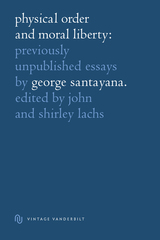 Physical Order and Moral Liberty: Previously Unpublished Essays of George Santayana
George Santayana
Vanderbilt University Press, 1969 This book is a collection of fifty-five essays and fragments by George Santayana, from the Santayana collections of the Columbia University Library and the Humanities Research Center at the University of Texas.
Although the essay included are largely philosophical in nature, none is narrowly technical. The general reader should be able to understand most of the pieces, as well as enjoy their literary quality and profit by the insights and wisdom they provide. The philosopher may draw courage from the speculative spirit of the essays and benefit by Santayana's steadfast vision and his sensitivity to distinctions.
For the serious student of Santayana's thought, this volume will prove indispensable. It contains sustained philosophical studies of causation (the only ones by Santayana anywhere), substantial elaborations of Santayana’s ideas on the relation of sensation to thought, and reflections on the nature of freedom and the spiritual life. In addition, Santayana develops here a new theory of “critical instants” and elaborates on his ideas of the nature of consciousness and its relations to time.
Sections on the philosophy of nature and the philosophy of mind are followed by groups of essays on ethics, the philosophy of politics, and the freedom of mind—in which, according to Santayana, the blessing of the good life consists. The book concludes with brief notes on Bergson, Democritus, and Leibniz and a longer essay on the thought of Vaihinger.
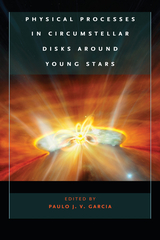 Physical Processes in Circumstellar Disks around Young Stars
Edited by Paulo J. V. Garcia
University of Chicago Press, 2011 Circumstellar disks are vast expanses of dust that form around new stars in the earliest stages of their birth. Predicted by astronomers as early as the eighteenth century, they weren’t observed until the late twentieth century, when interstellar imaging technology enabled us to see nascent stars hundreds of light years away. Since then, circumstellar disks have become an area of intense study among astrophysicists, largely because they are thought to be the forerunners of planetary systems like our own—the possible birthplaces of planets.
This volume brings together a team of leading experts to distill the most up-to-date knowledge of circumstellar disks into a clear introductory volume. Understanding circumstellar disks requires a broad range of scientific knowledge, including chemical processes, the properties of dust and gases, hydrodynamics and magnetohydrodynamics, radiation transfer, and stellar evolution—all of which are covered in this comprehensive work, which will be indispensable for graduate students, seasoned researchers, or even advanced undergrads setting out on the study of planetary evolution.
Physical Safety: A Matter of Balancing Responsibilities
The Scientific Council for Government Policy (WRR)
Amsterdam University Press, 2012 Ensuring the population’s physical safety is one of the core tasks of any government. In general, a government is typically held accountable for safe handling of hazardous substances, food safety, flood protection, controlling and preventing infectious diseases, as well as managing risks engendered by new technologies. In 2011, the Dutch Ministry of the Interior asked the Scientific Council for Government Policy to investigate the development of a generic risk policy in relation to physical safety. This work contains the Council’s survey and recommendations for good governance in the area of general public safety.
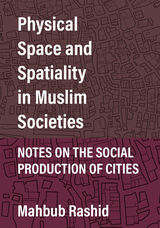 Physical Space and Spatiality in Muslim Societies: Notes on the Social Production of Cities
Mahbub Rashid
University of Michigan Press, 2021 Mahbub Rashid embarks on a fascinating journey through urban space in all of its physical and social aspects, using the theories of Foucault, Bourdieu, Lefebvre, and others to explore how consumer capitalism, colonialism, and power disparity consciously shape cities. Using two Muslim cities as case studies, Algiers (Ottoman/French) and Zanzibar (Ottoman/British), Rashid shows how Western perceptions can only view Muslim cities through the lens of colonization—a lens that distorts both physical and social space. Is it possible, he asks, to find a useable urban past in a timeline broken by colonization? He concludes that political economy may be less relevant in premodern cities, that local variation is central to the understanding of power, that cities engage more actively in social reproduction than in production, that the manipulation of space is the exercise of power, that all urban space is a conscious construct and is therefore not inevitable, and that consumer capitalism is taking over everyday life. Ultimately, we reconstruct a present from a fragmented past through local struggles against the homogenizing power of abstract space.
 Physician Communication with Patients: Research Findings and Challenges
Jon B. Christianson, PhD, Louise H. Warrick, DrPH, Michael Finch, PhD, and Wayne Jonas, MD
University of Michigan Press, 2012 We all have a good idea of how we want things to go when we visit a physician. We expect to be able to explain why we are there, and we hope the physician will listen and possibly ask questions that help us clarify our thoughts. Most of us hope that the physician will provide some expression of empathy, offer a clear, nontechnical assessment of our problem, and describe "next steps" in a way that is easy to understand. Ideally, we would like to be asked about our ability to follow treatment recommendations. Some experts say that these expectations are not only reasonable but even necessary if patients are to get the care they need. Yet there is a growing body of research that suggests the reality of physician communication with patients often falls short of this ideal in many respects. A careful analysis of the findings of this research can provide guidance to physician educators, health care administrators, and health policy makers interested in understanding the role that improved physician communication can play in improving quality of care and patient outcomes. Physician Communication with Patients summarizes findings from the academic literature pertaining to various aspects of this question, discussing those findings in the context of current pressures for change in the organization and delivery of medical services.
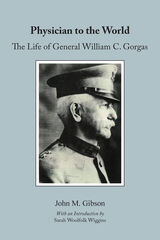 Physician to the World: The Life of General William C. Gorgas
John M. Gibson
University of Alabama Press, 1989 Physician to the World by John M. Gibson is a study of the career of William Crawford Gorgas, focusing primarily on the 22 years from the Spanish-American War until his death at the age of 65. The book details the medical community’s gradual acceptance of the mosquito theory as the cause for yellow fever epidemics and follows Gorgas as his initial skepticism gave way to belief while he participated in Walter Reed’s massive cleanup of Havana. From this success Gorgas moved to the Panama Canal Zone and a bureaucratic quagmire as he attempted to apply sanitary principles there to control yellow fever and malaria. As canal construction proceeded, assorted red-tape and critics repeatedly thwarted Gorgas’s efforts. His particular nemesis was the imperious engineer George Goethals, who ruled the construction project with an iron hand. Gorgas’s dogged persistence to make Panama healthy for both Americans and natives eventually succeeded, enabling the project to be completed with minimum loss of life. During World War I Gorgas became U.S. Surgeon General, and finally his reputation equaled his accomplishments. He traveled widely in Europe, South Africa, and South America on behalf of public health improvements and was about to begin another such journey when he died of complications from a stroke in London in 1920.
Physicians and Hospitals: The Great Partnership at the Crossroads
Duncan Yaggy and Patricia Hodgson, eds.
Duke University Press, 1985 Physicians and Hospitals addresses an issue of concern and one of fundamental importance to the American health care system. While the ranks of physicians continue to swell and hospitals continue to expand their facilities, federal, state, and local governments remain determined to control health care expenditures. As a result, checks on the supply of services and facilities have been implemented that strain the physician-hospital relationship, often placing physicians and hospital administrations in conflict. The implications for American health care are the subject of disagreement and vigorous debate.
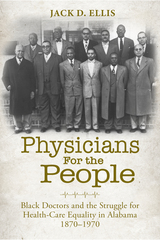 Physicians for the People: Black Doctors and the Struggle for Health-Care Equality in Alabama, 1870–1970
Jack D. Ellis with a foreword by Alan I Marcus
University of Alabama Press, 2025 Healing against the odds—Black doctors, bold resistance, and the fight for medical justice in Alabama. Physicians for the People chronicles the remarkable stories of 241 Black doctors who practiced medicine in Alabama during the Jim Crow era. Historian Jack D. Ellis reveals the ingenuity and resilience of these trailblazing doctors who defied segregation by establishing hospitals and clinics and providing vital healthcare to underserved Black communities. This meticulously researched work draws on archival sources, oral histories, and an unparalleled database to dismantle the myth of a monolithic medical system in the Jim Crow South. Jack D. Ellis argues that the post–Civil War lives of Black physicians, dentists, pharmacists, nurses, and midwives hold special significance, illuminating both the causes of health care disparities among African Americans and the reasons for their continued underrepresentation in the medical professions. Offering much of interest to students and scholars of Black history, medical history, and the civil rights movement, Physicians for the People exposes the deliberate exclusion faced by Black doctors within the white medical establishment and their ongoing fight for racial equality in medicine.
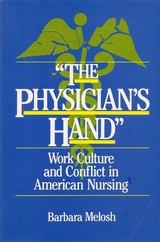 The Physician's Hand: Work Culture and Conflict in American Nursing
Barbara Melosh
Temple University Press, 1982 This book recasts nursing history and places it in the context of women’s history, labor history, medical history, and sociology. Removed from the limited framework of professionalization, nursing history can provide a fresh perspective on broader issues in social history. First, it offers an illuminating example of the ways in which gender informs work and, conversely. How work reproduces and transforms relationships of power and inequality. Second, the experience of nurses adds a new dimension to our understanding of work. More than a study of professionalization, nursing history is the story of women workers’ experience in a rationalizing service industry. Like other workers, nurses faced a fundamental reorganization of work that changed the content and experience of nursing. But unlike many others, they did not suffer a dilution of skill. The book also explores the shifting configurations of social relations on the job and their implications for nurses’ work. Third, nurses’ history provides a useful standpoint for analyzing the possibilities and limitations of women’s work. Finally, nursing history alerts us to the complexities of working women’s consciousness, countering the common notion of women’s passivity in the workplace. The Physician’s Hand traces nursing history from the twenties to the seventies. It begins just after World War I when the "trained nurse" had gained a secure place in medical care but not yet found a niche in the hospital. Most worked in private duty. Chapter 1 outlines the theoretical framework of professionalization. Chapter 2 examines the history and culture of hospital schools, and the following chapters focus on the changing structure and experience of nursing in its three major settings: private duty nursing, public health care, and hospital work. The conclusion weighs the competing traditions of professionalization and occupational culture in nurses’ history and their meaning for the current crisis in nursing.
 Physicians of the Future: Doctor-Influencers, Patient-Consumers, and the Business of Functional Medicine
Rosalynn A. Vega
University of Texas Press, 2024 The first scholarly exploration of the forums, practice, and economics of functional medicine. Physicians of the Future interrogates the hidden logics of inclusion and exclusion in functional medicine (FM), a holistic form of personalized medicine that targets chronic disease. Rosalynn Vega uncovers how, as “wounded healers,” some FM practitioners who are former chronic disease sufferers turn their illness narratives into a form of social capital, leveraging social media to relate to patients and build practices as “doctor-influencers.” Arguing that power and authority operate distinctly in FM when compared to conventional medicine, largely because FM services are paid for out of pocket by socioeconomically privileged “clients,” Vega studies how FM practitioners engage in entrepreneurship of their own while critiquing the profit motives of the existing healthcare system, pharmaceutical industry, and insurance industry. Using data culled from online support groups, conferences, docuseries, blogs, podcasts, YouTube, and TED Talks, as well as her own battles with chronic illness, Vega argues that FM practices prioritize the individual while inadvertently reinscribing inequities based on race and class. Ultimately, she opens avenues of possibility for FM interlocutors wrestling with their responsibility for making functional medicine accessible to all.
 Physicians, Peasants, and Modern Medicine: Imagining Rurality in Romania, 1860-1910
Constantin Barbulescu
Central European University Press, 2019 This monograph, a coherent and consistent historical narrative about Romania's modernization, focuses on one section of the country's elites of the late nineteenth century, namely the health professionals, and on the imagery they constructed as they interacted with the peasant and his world. Doctors ventured out of cities and became a familiar sight on dusty country roads in of Moldavia and Wallachia. Beyond a charitable impulse they did so thru patriotism as the rural world became ever more prominent within the national ideology. Furthermore, new health legislation required the district general practitioner (medicul de plasa) to visit the villages in his catchment area twice a month. Based on solid original research, the book describes rural conditions of the time and the efforts aiming to improve peasants' way of life with abundant quotes from doctors' public health reports and memoirs. The book sheds light on a variety of microscale realities of social life in the medical discourse on the peasant and the rural world in the mirror of medical discourse. Themes include general hygiene, clothing, dwellings, nutrition, drinking habits and healing practices of the peasantry, in the eye of medical specialists. Related official measures, laws, regulations, norms about public health are also discussed in the frame of wider modernizing processes.
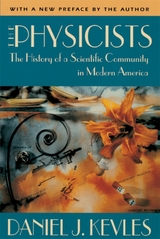 The Physicists: The History of a Scientific Community in Modern America, With a New Preface by the Author
Daniel J. Kevles
Harvard University Press, 1995 This magnificent account of the coming of age of physics in America has been heralded as the best introduction to the history of science in the United States. Unsurpassed in its breadth and literary style, Daniel J. Kevles’s account portrays the brilliant scientists who became a powerful force in bringing the world into a revolutionary new era. The book ranges widely as it links these exciting developments to the social, cultural, and political changes that occurred from the post–Civil War years to the present. Throughout, Kevles keeps his eye on the central question of how an avowedly elitist enterprise grew and prospered in a democratic culture.
In this new edition, the author has brought the story up-to-date by providing an extensive, authoritative, and colorful account of the Superconducting Super Collider, from its origins in the international competition and intellectual needs of high-energy particle physics, through its establishment as a multibillion-dollar project, to its termination, in 1993, as a result of angry opposition within the American physics community and Congress.
 The Physico-Chemical Properties of Plant Saps in Relation to Phytogeography: Data on Native Vegetation in its Natural Environment
J. Harris
University of Minnesota Press, 1934
The Physico-Chemical Properties of Plant Saps in Relation to Phytogeography was first published in 1934. Minnesota Archive Editions uses digital technology to make long-unavailable books once again accessible, and are published unaltered from the original University of Minnesota Press editions.This book includes data on native vegitation gathered by the noted botanist J. Arthur Harris in the eastern and western United States, the Hawaiian islands, and Jamaica over a period of 18 years. Included more than 12,000 series of determinations of freezing-point depression, specific electrical conductivity, chloride and sulphate content in grams per liter of sap, and occasional determinations of hydrogen ion concentration. A separate index to the data is included for use by those wishing to make ecological studies of plants in particular communities.
Physics and Technology of Heterojunction Devices
D. Vernon Morgan
The Institution of Engineering and Technology, 1991 Physics and Technology of Heterojunction Devices brings together the physics of engineering aspects of heterojunction semiconductor devices in one volume.
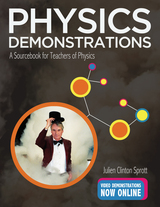 Physics Demonstrations: A Sourcebook for Teachers of Physics
Julien Clinton Sprott
University of Wisconsin Press, 2015 Wow! How? Few techniques are as effective at generating interest in science as dramatic demonstrations. This fully illustrated sourcebook describes eighty-five physics demonstrations suitable for performance both inside and outside classrooms. These demonstrations will fascinate and amaze while teaching the wonders and practical science of physics. Videos for the demonstrations are on our youtube. Dr. Sprott shares demonstrations tested over many years in his popular public lectures on “The Wonders of Physics,” which appeal to general audiences and to students from grade school to graduate school. Science teachers at all levels will find a wealth of detail showing how to present these demonstrations to students with flair. Science professionals will find indispensable information for creating educational and entertaining public programs. Organized to teach the six major areas of classical physics—motion, heat, sound, electricity, magnetism, and light— Physics Demonstrations includes: • a brief description of each demonstration • materials lists, with sources for common materials • preparation procedures • discussions of the physics principles demonstrated • potential safety hazards • references for further information.
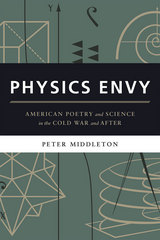 Physics Envy: American Poetry and Science in the Cold War and After
Peter Middleton
University of Chicago Press, 2015 At the close of the Second World War, modernist poets found themselves in an increasingly scientific world, where natural and social sciences claimed exclusive rights to knowledge of both matter and mind. Following the overthrow of the Newtonian worldview and the recent, shocking displays of the power of the atom, physics led the way, with other disciplines often turning to the methods and discoveries of physics for inspiration.
In Physics Envy, Peter Middleton examines the influence of science, particularly physics, on American poetry since World War II. He focuses on such diverse poets as Charles Olson, Muriel Rukeyser, Amiri Baraka, and Rae Armantrout, among others, revealing how the methods and language of contemporary natural and social sciences—and even the discourse of the leading popular science magazine Scientific American—shaped their work. The relationship, at times, extended in the other direction as well: leading physicists such as Robert Oppenheimer, Werner Heisenberg, and Erwin Schrödinger were interested in whether poetry might help them explain the strangeness of the new, quantum world. Physics Envy is a history of science and poetry that shows how ultimately each serves to illuminate the other in its quest for the true nature of things.
Physics in the Nineteenth Century
Purrington, Robert
Rutgers University Press, 1997 Putting physics into the historical context of the Industrial Revolution and the European nation-state, Purrington traces the main figures, including Faraday, Maxwell, Kelvin, and Helmholtz, as well as their interactions, experiments, discoveries, and debates. The success of nineteenth-century physics laid the foundation for quantum theory and relativity in the twentieth. Robert D. Purrington is a professor of physics at Tulane University and coauthor of Frame of the Universe.
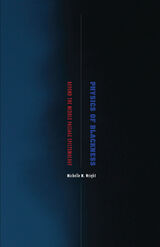 Physics of Blackness: Beyond the Middle Passage Epistemology
Michelle M. Wright
University of Minnesota Press, 2015 What does it mean to be Black? If Blackness is not biological in origin but socially and discursively constructed, does the meaning of Blackness change over time and space? In Physics of Blackness: Beyond the Middle Passage Epistemology, Michelle M. Wright argues that although we often explicitly define Blackness as a “what,” it in fact always operates as a “when” and a “where.” By putting lay discourses on spacetime from physics into conversation with works on identity from the African Diaspora, Physics of Blackness explores how Middle Passage epistemology subverts racist assumptions about Blackness, yet its linear structure inhibits the kind of inclusive epistemology of Blackness needed in the twenty-first century. Wright then engages with bodies frequently excluded from contemporary mainstream consideration: Black feminists, Black queers, recent Black African immigrants to the West, and Blacks whose histories may weave in and out of the Middle Passage epistemology but do not cohere to it. Physics of Blackness takes the reader on a journey both known and unfamiliar—from Isaac Newton’s laws of motion and gravity to the contemporary politics of diasporic Blackness in the academy, from James Baldwin’s postwar trope of the Eiffel Tower as the site for diasporic encounters to theoretical particle physics’ theory of multiverses and superpositioning, to the almost erased lives of Black African women during World War II. Accessible in its style, global in its perspective, and rigorous in its logic, Physics of Blackness will change the way you look at Blackness.
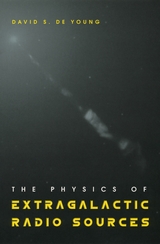 The Physics of Extragalactic Radio Sources
David S. De Young
University of Chicago Press, 2002 Extragalactic radio sources are among the most unusual and spectacular objects in the universe, with sizes in excess of millions of light years, radiated energies over ten times those of normal galaxies, and a unique morphology. They reveal some of the most dramatic physical events ever seen and provide essential clues to the basic evolutionary tracks followed by all galaxies and groups of galaxies.
In The Physics of Extragalactic Radio Sources, David De Young provides a clearly written overview of what is currently known about these objects. A unique feature of the book is De Young's emphasis on the physical processes associated with extragalactic radio sources: their evolution, their environment, and their use as probes to solve other astrophysical problems. He also makes extensive use of the large amount of data now available from observations at x-ray, optical, and radio wavelengths to illustrate his main points.
The Physics of Extragalactic Radio Sources will be a comprehensive introduction to the field for graduate students and a useful summary for astrophysicists.
The Physics of Imaginary Objects
Tina May Hall
University of Pittsburgh Press, 2010
Winner of the 2010 Drue Heinz Literature Prize
The Physics of Imaginary Objects, in fifteen stories and a novella, offers a very different kind of short fiction, blending story with verse to evoke fantasy, allegory, metaphor, love, body, mind, and nearly every sensory perception. Weaving in and out of the space that connects life and death in mysterious ways, these texts use carefully honed language that suggests a newfound spirituality.
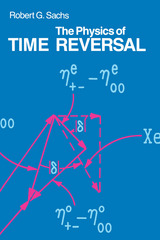 The Physics of Time Reversal
Robert G. Sachs
University of Chicago Press, 1987 The notion that fundamental equations governing the motions of physical systems are invariant under the time reversal transformation (T) has been an important, but often subliminal, element in the development of theoretical physics. It serves as a powerful and useful tool in analyzing the structure of matter at all scales, from gases and condensed matter to subnuclear physics and the quantum theory of fields. The assumption of invariance under T was called into question, however, by the 1964 discovery that a closely related assumption, that of CP invariance (where C is charge conjugation and P is space inversion), is violated in the decay of neutral K mesons.
In The Physics of Time Reversal, Robert G. Sachs comprehensively treats the role of the transformation T, both as a tool for analyzing the structure of matter and as a field of fundamental research relating to CP violation. For this purpose he reformulates the definitions of T, P, and C so as to avoid subliminal assumptions of invariance. He summarizes the standard phenomenology of CP violation in the K-meson system and addresses the question of the mysterious origin of CP violation. Using simple examples based on the standard quark model, Sachs summarizes and illustrates how these phenomenological methods can be extended to analysis of future experiments on heavy mesons. He notes that his reformulated approach to conventional quantum field theory leads to new questions about the meaning of the transformations in the context of recent theoretical developments such as non-Abelian gauge theories, and he suggests ways in which these questions may lead to new directions of research.
Physics Or Natural Hearing
Aristotle
St. Augustine's Press, 2005 The William of Moerbeke Translation Series, under the general editorship of Stuart D. Warner, is devoted to publishing translations of important works - ancient, medieval, and modern - regardless of the original language, in every area of scholarly endeavor, including philosophy, political science, theology, literature, history, economics, and law. The aim of the series is to bring the reader as close as possible to the letter and spirit of the original work. Each volume will contain a scholarly introduction and notes. We welcome all inquiries and suggestions. Physics, Or Natural Healing is the first volume of this series.
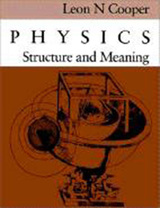 Physics: Structure and Meaning
Leon N. Cooper
Brandeis University Press, 1992 Physics explores the scientific view of the world as it has developed from the earliest theories of Aristotle, Euclid, and Newton to modern theories, such as Einstein’s relativity and quantum mechanics. The classic text’s chief distinction is its time-proven ability to overcome anxieties about science by arousing interest in imaginative ideas. Those curious about physics but lacking science and mathematics backgrounds will find well-told history and countless stimulating examples. The historical approach enables students to examine philosophical questions from many viewpoints and ot see how current theory evolved. Physics has been thoroughly tested and refined by several decades of classroom teaching. A new prologue covers the years since the original 1968 edition. Chapter source notes, review problems, questions and answers, and mathematical appendices are included for those wishing to pursue topics further. The material is supplemented with clear line drawings, illustrations, graphs, charts, and tables.
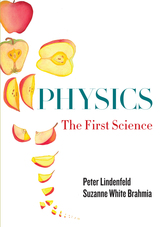 Physics: The First Science
Lindenfeld, Peter
Rutgers University Press, 2011
Today's physics textbooks have become encyclopedic, offering students dry discussions, rote formulas, and exercises with little relation to the real world. Physics: The First Science takes a different approach by offering uniquely accessible, student-friendly explanations, historical and philosophical perspectives and mathematics in easy-to-comprehend dialogue. It emphasizes the unity of physics and its place as the basis for all science. Examples and worked solutions are scattered throughout the narrative to help increase understanding. Students are tested and challenged at the end of each chapter with questions ranging from a guided-review designed to mirror the examples, to problems, reasoning skill building exercises that encourage students to analyze unfamiliar situations, and interactive simulations developed at the University of Colorado. With their experience instructing both students and teachers of physics for decades, Peter Lindenfeld and Suzanne White Brahmia have developed an algebra-based physics book with features to help readers see the physics in their lives. Students will welcome the engaging style, condensed format, and economical price.
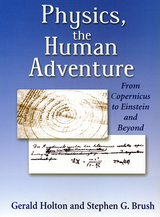 Physics, the Human Adventure: From Copernicus to Einstein and Beyond
Brush, Stephen G
Rutgers University Press, 2001 Winner of the 2001 Joseph Hazen Education Prize of the History of Science Society
Physics, the Human Adventure is the third edition of the classic text Introduction to Concepts and Theories in Physical Science. Authored by Gerald Holton, the text was a landmark in science education. It was the first modern textbook in physics (or in any other science) to make full and effective use of the history and philosophy of science in presenting for both the general and the science-oriented student an account of the nature of physical science. A second edition, prepared by Stephen G. Brush, brought the book up to date by increasing the coverage of topics in modern physics and by taking account of recent scholarly research in the history of science.
In the new book Physics, The Human Adventure, each of the chapters has been reworked to further clarify the physics concepts and to incorporate recent physical advances and research. The book shows the unifying power of science by bringing in connections to chemistry, astronomy, and geoscience. In short, the aid of the new edition is to teach good physics while presenting physical science as a human adventure that has become a major force in our civilization.
New chapters discuss theories of the origin of the solar system and the expanding universe; fission, fusion, and the Big Bang–Steady State Controversy; and thematic elements and styles in scientific thought. New topics include: • Theories of vision: does the eye send out rays or receive them? • Distances in the solar system • The prediction of the return of Halley’s comet and analysis of deviations from Kepler’s laws • Angular momentum conservation and Laplace’s nebular hypothesis • Relation between symmetries and conservation laws: Emmy Noether’s theorem • First estimates of atomic sizes • Consequences of the indistinguishability of elementary particles of the same kind • Applications of quantum mechanics to many-particle systems • Dirac’s prediction of anti-matter • The anthropic principle and other controversial issues on the frontiers of research
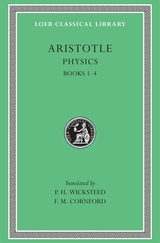 Physics, Volume I: Books 1–4
Aristotle
Harvard University Press Natural causes.
Aristotle, great Greek philosopher, researcher, reasoner, and writer, born at Stagirus in 384 BC, was the son of a physician. He studied under Plato at Athens and taught there (367–347); subsequently he spent three years at the court of a former pupil in Asia Minor. After some time at Mitylene, in 343–342 he was appointed by King Philip of Macedon to be tutor of his teen-aged son Alexander. After Philip’s death in 336, Aristotle became head of his own school (of “Peripatetics”), the Lyceum at Athens. Because of anti-Macedonian feeling there after Alexander’s death in 323, he withdrew to Chalcis in Euboea, where he died in 322.
Nearly all the works Aristotle prepared for publication are lost; the priceless ones extant are lecture-materials, notes, and memoranda (some are spurious). They can be categorized as follows:
I Practical: Nicomachean Ethics; Great Ethics (Magna Moralia); Eudemian Ethics; Politics; Economics (on the good of the family); On Virtues and Vices.
II Logical: Categories; Analytics (Prior and Posterior); Interpretation; Refutations used by Sophists; Topica.
III Physical: Twenty-six works (some suspect) including astronomy, generation and destruction, the senses, memory, sleep, dreams, life, facts about animals, etc.
IV Metaphysics: on being as being.
V Art: Rhetoric and Poetics.
VI Other works including the Constitution of Athens; more works also of doubtful authorship.
VII Fragments of various works such as dialogues on philosophy and literature; and of treatises on rhetoric, politics, and metaphysics.
The Loeb Classical Library® edition of Aristotle is in twenty-three volumes.
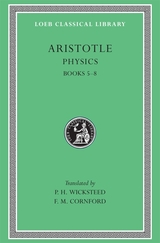 Physics, Volume II: Books 5–8
Aristotle
Harvard University Press Natural causes.
Aristotle, great Greek philosopher, researcher, reasoner, and writer, born at Stagirus in 384 BC, was the son of a physician. He studied under Plato at Athens and taught there (367–347); subsequently he spent three years at the court of a former pupil in Asia Minor. After some time at Mitylene, in 343–342 he was appointed by King Philip of Macedon to be tutor of his teen-aged son Alexander. After Philip’s death in 336, Aristotle became head of his own school (of “Peripatetics”), the Lyceum at Athens. Because of anti-Macedonian feeling there after Alexander’s death in 323, he withdrew to Chalcis in Euboea, where he died in 322.
Nearly all the works Aristotle prepared for publication are lost; the priceless ones extant are lecture-materials, notes, and memoranda (some are spurious). They can be categorized as follows:
I Practical: Nicomachean Ethics; Great Ethics (Magna Moralia); Eudemian Ethics; Politics; Economics (on the good of the family); On Virtues and Vices.
II Logical: Categories; Analytics (Prior and Posterior); Interpretation; Refutations used by Sophists; Topica.
III Physical: Twenty-six works (some suspect) including astronomy, generation and destruction, the senses, memory, sleep, dreams, life, facts about animals, etc.
IV Metaphysics: on being as being.
V Art: Rhetoric and Poetics.
VI Other works including the Constitution of Athens; more works also of doubtful authorship.
VII Fragments of various works such as dialogues on philosophy and literature; and of treatises on rhetoric, politics, and metaphysics.
The Loeb Classical Library® edition of Aristotle is in twenty-three volumes.
The Physiocratic Doctrine of Judicial Control
Mario Einaudi
Harvard University Press, 1973 Physiocratic economic views have hitherto gained much more attention than the political theories of this advanced set of economic thinkers in eighteenth century France. Mario Einaudi here discusses one element in their political thought, the doctrine of judicial review, an indispensable safeguard of the rights of individuals in a state. The fundamental importance of this doctrine at the center of our own constitutional system and the controversies concerning it, emphasize the need of a study which treats of these significant principles wherever they are found.
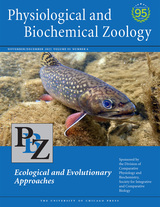 Physiological and Biochemical Zoology, volume 95 number 6 (November/December 2022)
The University of Chicago Press
University of Chicago Press Journals, 2022 This is volume 95 issue 6 of Physiological and Biochemical Zoology. Physiological and Biochemical Zoology: Ecological and Evolutionary Approaches primarily publishes original research in physiological ecology, ecophysiology, comparative physiology, and evolutionary physiology. Studies at all levels of biological organization from the molecular to the whole organism are welcome, and work that integrates across levels of organization is particularly encouraged. Studies that focus on behavior or morphology are welcome, so long as they include ties to physiology or biochemistry, in addition to having an ecological or evolutionary context. Subdisciplines of interest include nutrition and digestion, salt and water balance, epithelial and membrane transport, gas exchange and transport, acid-base balance, temperature adaptation, energetics, structure and function of macromolecules, chemical coordination and signal transduction, nitrogen metabolism and excretion, locomotion and muscle function, biomechanics, circulation, behavioral, comparative and mechanistic endocrinology, sensory physiology, neural coordination, and ecotoxicology ecoimmunology.
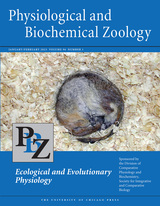 Physiological and Biochemical Zoology, volume 96 number 1 (January/February 2023)
The University of Chicago Press
University of Chicago Press Journals, 2023 This is volume 96 issue 1 of Physiological and Biochemical Zoology. Physiological and Biochemical Zoology: Ecological and Evolutionary Approaches primarily publishes original research in physiological ecology, ecophysiology, comparative physiology, and evolutionary physiology. Studies at all levels of biological organization from the molecular to the whole organism are welcome, and work that integrates across levels of organization is particularly encouraged. Studies that focus on behavior or morphology are welcome, so long as they include ties to physiology or biochemistry, in addition to having an ecological or evolutionary context. Subdisciplines of interest include nutrition and digestion, salt and water balance, epithelial and membrane transport, gas exchange and transport, acid-base balance, temperature adaptation, energetics, structure and function of macromolecules, chemical coordination and signal transduction, nitrogen metabolism and excretion, locomotion and muscle function, biomechanics, circulation, behavioral, comparative and mechanistic endocrinology, sensory physiology, neural coordination, and ecotoxicology ecoimmunology.
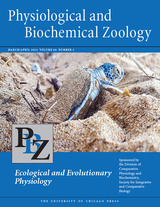 Physiological and Biochemical Zoology, volume 96 number 2 (March/April 2023)
The University of Chicago Press
University of Chicago Press Journals, 2023 This is volume 96 issue 2 of Physiological and Biochemical Zoology. Physiological and Biochemical Zoology: Ecological and Evolutionary Approaches primarily publishes original research in physiological ecology, ecophysiology, comparative physiology, and evolutionary physiology. Studies at all levels of biological organization from the molecular to the whole organism are welcome, and work that integrates across levels of organization is particularly encouraged. Studies that focus on behavior or morphology are welcome, so long as they include ties to physiology or biochemistry, in addition to having an ecological or evolutionary context. Subdisciplines of interest include nutrition and digestion, salt and water balance, epithelial and membrane transport, gas exchange and transport, acid-base balance, temperature adaptation, energetics, structure and function of macromolecules, chemical coordination and signal transduction, nitrogen metabolism and excretion, locomotion and muscle function, biomechanics, circulation, behavioral, comparative and mechanistic endocrinology, sensory physiology, neural coordination, and ecotoxicology ecoimmunology.
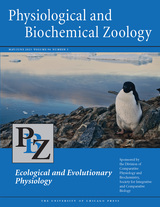 Physiological and Biochemical Zoology, volume 96 number 3 (May/June 2023)
The University of Chicago Press
University of Chicago Press Journals, 2023 This is volume 96 issue 3 of Physiological and Biochemical Zoology. Physiological and Biochemical Zoology: Ecological and Evolutionary Approaches primarily publishes original research in physiological ecology, ecophysiology, comparative physiology, and evolutionary physiology. Studies at all levels of biological organization from the molecular to the whole organism are welcome, and work that integrates across levels of organization is particularly encouraged. Studies that focus on behavior or morphology are welcome, so long as they include ties to physiology or biochemistry, in addition to having an ecological or evolutionary context. Subdisciplines of interest include nutrition and digestion, salt and water balance, epithelial and membrane transport, gas exchange and transport, acid-base balance, temperature adaptation, energetics, structure and function of macromolecules, chemical coordination and signal transduction, nitrogen metabolism and excretion, locomotion and muscle function, biomechanics, circulation, behavioral, comparative and mechanistic endocrinology, sensory physiology, neural coordination, and ecotoxicology ecoimmunology.
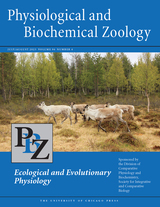 Physiological and Biochemical Zoology, volume 96 number 4 (July/August 2023)
The University of Chicago Press
University of Chicago Press Journals, 2023 This is volume 96 issue 4 of Physiological and Biochemical Zoology. Physiological and Biochemical Zoology: Ecological and Evolutionary Approaches primarily publishes original research in physiological ecology, ecophysiology, comparative physiology, and evolutionary physiology. Studies at all levels of biological organization from the molecular to the whole organism are welcome, and work that integrates across levels of organization is particularly encouraged. Studies that focus on behavior or morphology are welcome, so long as they include ties to physiology or biochemistry, in addition to having an ecological or evolutionary context. Subdisciplines of interest include nutrition and digestion, salt and water balance, epithelial and membrane transport, gas exchange and transport, acid-base balance, temperature adaptation, energetics, structure and function of macromolecules, chemical coordination and signal transduction, nitrogen metabolism and excretion, locomotion and muscle function, biomechanics, circulation, behavioral, comparative and mechanistic endocrinology, sensory physiology, neural coordination, and ecotoxicology ecoimmunology.
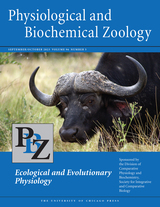 Physiological and Biochemical Zoology, volume 96 number 5 (September/October 2023)
The University of Chicago Press
University of Chicago Press Journals, 2023 This is volume 96 issue 5 of Physiological and Biochemical Zoology. Physiological and Biochemical Zoology: Ecological and Evolutionary Approaches primarily publishes original research in physiological ecology, ecophysiology, comparative physiology, and evolutionary physiology. Studies at all levels of biological organization from the molecular to the whole organism are welcome, and work that integrates across levels of organization is particularly encouraged. Studies that focus on behavior or morphology are welcome, so long as they include ties to physiology or biochemistry, in addition to having an ecological or evolutionary context. Subdisciplines of interest include nutrition and digestion, salt and water balance, epithelial and membrane transport, gas exchange and transport, acid-base balance, temperature adaptation, energetics, structure and function of macromolecules, chemical coordination and signal transduction, nitrogen metabolism and excretion, locomotion and muscle function, biomechanics, circulation, behavioral, comparative and mechanistic endocrinology, sensory physiology, neural coordination, and ecotoxicology ecoimmunology.
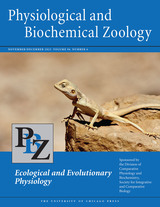 Physiological and Biochemical Zoology, volume 96 number 6 (November/December 2023)
The University of Chicago Press
University of Chicago Press Journals, 2023 This is volume 96 issue 6 of Physiological and Biochemical Zoology. Physiological and Biochemical Zoology: Ecological and Evolutionary Approaches primarily publishes original research in physiological ecology, ecophysiology, comparative physiology, and evolutionary physiology. Studies at all levels of biological organization from the molecular to the whole organism are welcome, and work that integrates across levels of organization is particularly encouraged. Studies that focus on behavior or morphology are welcome, so long as they include ties to physiology or biochemistry, in addition to having an ecological or evolutionary context. Subdisciplines of interest include nutrition and digestion, salt and water balance, epithelial and membrane transport, gas exchange and transport, acid-base balance, temperature adaptation, energetics, structure and function of macromolecules, chemical coordination and signal transduction, nitrogen metabolism and excretion, locomotion and muscle function, biomechanics, circulation, behavioral, comparative and mechanistic endocrinology, sensory physiology, neural coordination, and ecotoxicology ecoimmunology.
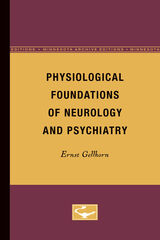 Physiological Foundations of Neurology and Psychiatry
Ernst Gellhorn
University of Minnesota Press, 1953
Physiological Foundations of Neurology and Psychiatry was first published in 1953.The findings of Dr. Gellhorn’s extensive and significant research on the physiology of the central nervous system form the basis of the discussion in this volume. Reference is frequently made to the applicability of this laboratory experience to clinical as well as other fields. An attempt has been made to integrate the clinical and experimental literature with the discussion, to give an up-to-date picture of the problems involved and to indicate the possibilities for future investigation. Topics of interest to physiologists, endocrinologists, internists, neurologists and neurosurgeons, psychiatrists, and clinical psychologists are discussed.An important aspect of the author’s work concerned certain recent tests which show an altered reactivity of autonomic centers in the psychotic condition. His interpretation of the significance of these tests for a physiologically oriented therapy of functional psychoses is published here for the first time. The physiological effects actually produced in the central nervous system by “shock” treatment and carbon dioxide therapy are analyzed.Other sections give consideration to some of the principal working mechanisms of the neuron, to the factors determining movements and convulsions, to the pathophysiology of cortical lesions, to some aspects of autonomic physiology, and to the problem of consciousness. An important section deals with integrative functions of the nervous system - those involved in emotion, the conditioning process as the basis of behavior, and homeostasis.
Physiologus: A Medieval Book of Nature Lore
Translated by Michael J. Curley
University of Chicago Press, 2009 One of the most popular and widely read books of the Middle Ages, Physiologus contains allegories of beasts, stones, and trees both real and imaginary, infused by their anonymous author with the spirit of Christian moral and mystical teaching. Accompanied by an introduction that explains the origins, history, and literary value of this curious text, this volume also reproduces twenty woodcuts from the 1587 version. Originally composed in the fourth century in Greek, and translated into dozens of versions through the centuries, Physiologus will delight readers with its ancient tales of ant-lions, centaurs, and hedgehogs—and their allegorical significance.
“An elegant little book . . . still diverting to look at today. . . . The woodcuts reproduced from the 1587 Rome edition are alone worth the price of the book.”—Raymond A. Sokolov, New York Times Book Review
 The Physiology and Pathology of the Cerebellum
Robert S. Dow and Guiseppe Moruzzi
University of Minnesota Press, 1958
The Physiology and Pathology of the Cerebellum was first published in 1958. Minnesota Archive Editions uses digital technology to make long-unavailable books once again accessible, and are published unaltered from the original University of Minnesota Press editions.
The development of electrical methods of recording activity in the nervous system has greatly augmented our knowledge of cerebellar physiology. Now, for the first time in a single volume, this new information has been related to facts derived from older methods of investigation. Previously unpublished reports of experiments conducted at the Institute of Physiology, University of Pisa, Italy, also are included.
The authors, an American clinical neurologist and an Italian neuro-physiologist, have collaborated to provide a comprehensive review of cerebellar physiology and a survey of the clinical symptomatology of cerebellar disorders and the pathology of the cerebellum.
In Part I, devoted to the physiology, the authors review the literature completely and place it in proper relation to the latest developments in this field. There are chapters on this history of cerebellar physiology, ablation experiments, stimulation experiments, electro-physiological experiments, the relations between the cerebellum and other central nervous structures, developmental physiology, and the functions of the cerebellum, considered generally.
Part II is devoted to the human cerebellum as studied in the clinic. Where anatomical and physiological observation may shed light upon obscure clinical findings, the laboratory data are related to the clinical investigations. The disorders and diseases affecting the cerebellum are systemically reviewed. The book is illustrated with 61 halftones and 124 line drawings.
 The Physiology of Hemostasis
Derek Ogston
Harvard University Press, 1983 A leading researcher provides a comprehensive review of the basic physiology of the hemostatic system, offering a solid foundation for understanding the pathological events leading up to thrombosis and abnormal bleeding. An introductory chapter, intended for the nonspecialist, outlines the whole hemostatic process and leads the reader carefully into the detailed information that follows. The first section of the book describes basic components of platelet structure and function, the coagulation system, and fibrinolytic enzyme system. The second is a unique discussion of the changes in these components induced by physiological parameters—hormones, sex, environment, nutrition, stress, and activity.
Derek Ogston performs an invaluable service in reviewing pertinent studies that show both positive and negative results and examining conflicting data and conclusions. His work will be a source of insight and data for practicing hematologists as well as researchers in this rapidly growing field.
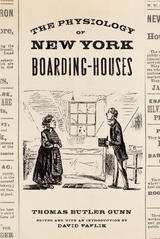 The Physiology of New York Boarding-Houses
Faflik, David
Rutgers University Press, 2008 The American boardinghouse once provided basic domestic shelter and constituted a uniquely modern world view for the first true generation of U.S. city-dwellers. Thomas Butler Gunn's classic 1857 account of urban habitation, The Physiology of New York Boarding-Houses, explores the process by which boardinghouse life was translated into a lively urban vernacular. Intimate in its confessional tone, comprehensive in its detail, disarmingly penetrating despite (or perhaps because of) its self-deprecating wit, Physiology is at once an essential introduction to a "lost" world of boarding, even as it comprises an early, engaging, and sophisticated analysis of America's "urban turn" during the decades leading up to the Civil War. In his introduction, David Faflik considers what made Gunn's book a compelling read in the past and how today it can elucidate our understanding of the formation and evolution of urban American life and letters.
The Physiology of Physical Stress: A Selective Bibliography, 1500–1964
Carleton B. Chapman, M.D. and Elinor C. Reinmiller
Harvard University Press, 1975 More than 2,800 citations indexed by author and by subject comprise this bibliography of studies on the physiology of exercise. Selected from a vast literature on physical stress, the majority of works in this listing concern basic physiology. The emphasis is on studies representing the origin and development of fundamental concepts, although some clinical studies with implications for basic physiology are included. The bibliography includes references from a period, 1500 to 1964, not available through the computerized retrieval system (MEDLARS) of the National Library of Medicine. Most entries were published in the late nineteenth and twentieth centuries and thus reflect the growth of the field.
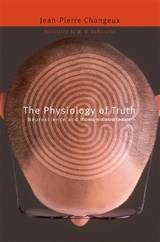 The Physiology of Truth: Neuroscience and Human Knowledge
Jean-Pierre Changeux
Harvard University Press, 2002 In this wide-ranging book, one of the boldest thinkers in modern neuroscience confronts an ancient philosophical problem: can we know the world as it really is?
Drawing on provocative new findings about the psychophysiology of perception and judgment in both human and nonhuman primates, and also on the cultural history of science, Jean-Pierre Changeux makes a powerful case for the reality of scientific progress and argues that it forms the basis for a coherent and universal theory of human rights. On this view, belief in objective knowledge is not a mere ideological slogan or a naïve confusion; it is a characteristic feature of human cognition throughout evolution, and the scientific method its most sophisticated embodiment. Seeking to reconcile science and humanism, Changeux holds that the capacity to recognize truths that are independent of subjective personal experience constitutes the foundation of a human civil society.
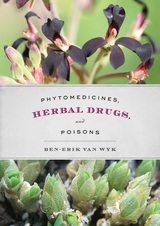 Phytomedicines, Herbal Drugs, and Poisons
Edited by Ben-Erik van Wyk and Michael Wink
University of Chicago Press, 2015 Plants have been used to treat disease throughout human history. On a clay slab that dates back approximately five thousand years, the Sumerians recorded medicinal recipes that made use of hundreds of plants, including poppy, henbane, and mandrake. During the Middle Ages, monks commonly grew and prescribed plants such as sage, anise, and mint in their monasteries. And as the market for herbal remedies and natural medicine grows, we continue to search the globe for plants and plant compounds to combat our various ailments.
In Phytomedicines, Herbal Drugs, and Poisons, Ben-Erik van Wyk offers a richly illustrated, scientific guide to medicinal and poisonous plants, including those used for their mind-altering effects. Van Wyk covers approximately 350 species—from Aloe vera and Ephedra sinica to Cannabis sativa and Coffea arabica—detailing their botanical, geographical, pharmacological, and toxicological data as well as the chemical structures of the active compounds in each. Readers learn, for example, that Acacia senegal, or gum acacia, is used primarily in Sudan and Ethiopia as a topical ointment to protect the skin and mucosa from bacterial and fungal infections, and that Aconitum napellus, more commonly known as aconite, is used in cough syrups but can be psychedelic when smoked or absorbed through the skin.
With 350 full-color photographs featuring the plants and some of their derivative products, Phytomedicines, Herbal Drugs, and Poisons will be an invaluable reference not only for those in the health care field but also for those growing their own medicinal herb gardens, as well as anyone who needs a quick answer to whether a plant is a panacea or a poison.
The Phœnix Nest, 1593
Hyder Edward Rollins
Harvard University Press A reissue of a volume published in 1931. Originally published in 1593, this book is one of the best of the many Elizabethan anthologies and includes poems of such fine writers as Thomas Lodge, Nicholas Breton, Sir Walter Raleigh, George Peele, and Robert Greene.
 Piaget before Piaget
Fernando Vidal
Harvard University Press, 1994 The great Swiss psychologist and theorist Jean Piaget (1896–1980) had much to say about the developing mind. He also had plenty to say about his own development, much of it, as Fernando Vidal shows, plainly inaccurate. In the first truly historical biography of Piaget, Vidal tells the story of the psychologist’s intellectual and personal development up to 1918. By exploring the philosophical, religious, political, and social influences on the psychologist’s early life, Vidal alters our basic assumptions about the origins of Piaget’s thinking and his later psychology.
The resulting profile is strikingly dissimilar to Piaget’s own retrospective version. In Piaget’s own account, as an adolescent he was a precocious scientist dedicated to questions of epistemology. Here we find him also—and increasingly—concerned with the foundations of religious faith and knowledge, immersed in social and political matters, and actively involved in Christian and socialist groups. Far from being devoted solely to the classification of mollusks, the young Piaget was a vocal champion of Henri Bergson’s philosophy of creative evolution, an interest that figured much more prominently in his later thinking than did his early work in natural history. We see him during World War I chastising conservatism and nationalism, espousing equality and women’s rights, and advocating the role of youth in the birth of a new Christianity.
In his detailed account of Jean Piaget’s childhood and adolescence—enriched by the intellectual and cultural landscape of turn-of-the-century Neuchâtel—Vidal reveals a little-known Piaget, a youth whose struggle to reconcile science and faith adds a new dimension to our understanding of the great psychologist’s life, thought, and work.
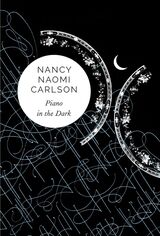 Piano in the Dark
Nancy Naomi Carlson
Seagull Books, 2023 Poetry from an especially deft magician of words.
This latest book of wonders from Nancy Naomi Carlson fixes upon one of the few defenses we have to confront the body’s betrayals—our words. Though in the end, even the world’s last word “forgets its name . . . has no word for this forgetting.” At once vulnerable and open, tempered and tempted equally by the erotic and the empathic, such dualities limn these affectingly beautiful and lyrical poems. Carlson’s lines, entreating as Scheherazade, “weave chords / into tales within tales, whirlpools within seas” to save her life. Indeed, music has no need for voice or harp, as “in anechoic chambers, you become / the only instrument of your worldly sounds,” echoing Mozart’s credo “that music lies / in the silence between notes.” In a world scarred by pandemics, wars, and violent tribalism, the givens are gone—“talismans we clung to, believing / we might be spared in some way / by marking our doors / with our own sacrificial blood.” In these unflinching free and formal verse poems, Carlson seduces us with the promise of the joy yet to be had, were we to look in the right places.
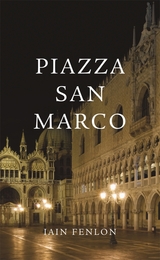 Piazza San Marco
Iain Fenlon
Harvard University Press, 2009 The Piazza San Marco, one of the most famous and instantly recognizable townscapes in the West, if not the world, has been described as a stage set, as Europe’s drawing room, as a painter’s canvas. This book traces the changing shape and function of the piazza, from its beginnings in the ninth century to its present day ubiquity in the Venetian, European, as well as global imagination.
Through its long history, the Piazza San Marco has functioned as civic space that was used for such varied activities as public meetings; animal-baiting; executions; state processions; meat and produce markets; a performance venue for rock concerts; as well as, more recently, a cafe to enjoy a leisurely Campari. Constantly alert to the question of function, this book recreates not only rituals of the past but also activities of the present, from the coronation of the doge to the legendary Pink Floyd concert of 1989, with much fanfare in between. Iain Fenlon recreates the dynamic, colorful, and noisy history of the piazza—a history that is also the history of Venice and, indeed, of Europe.
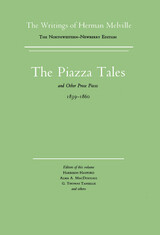 The Piazza Tales and Other Prose Pieces, 1839-1860: Volume Nine, Scholarly Edition
Herman Melville
Northwestern University Press, 1987 In this new edition of The Piazza Tales, the editors of the acclaimed Northwestern-Newberry Edition of the Writings of Herman Melville have used the original magazine versions for five of the six stories in order to present the most accurate tests of these works. Here, in such famous stories as "Bartleby, the Scrivener" and "The Encantadas, or Enchanted Isles," we find Melville's imagination and style at its best. Of the less well known tales, the humor in "The Piazza" and "The Lightning-Rod Man," and the gothic horror of "The Bell Tower," command attention as well. Whether in the exotic Galapagos or the more familiar climes of Wall Street or a Massachusetts farmhouse, Melville's power and imagination transport the reader into his unique worlds.
This scholarly edition presents texts as close to the author's intentions as surviving evidence permits. Based on surviving manuscripts, on original newspaper and magazine printings, and on collations of magazine printings with the book of editions of The Piazza Tales, the text incorporates over 800 emendations by the editors and over 200 from later printings during Melville's lifetime.
This edition is an Approved Text of the Center for Editions of American Authors (Modern Language Association of America).
 The Piazza Tales: Volume Nine
Herman Melville
Northwestern University Press, 1996 In this new edition of The Piazza Tales, the editors of the acclaimed Northwestern-Newberry Edition of the Writings of Herman Melville have used the original magazine versions for five of the six stories in order to present the most accurate tests of these works. Here, in such famous stories as "Bartleby, the Scrivener" and "The Encantadas, or Enchanted Isles," we find Melville's imagination and style at its best. Of the less well known tales, the humor in "The Piazza" and "The Lightning-Rod Man," and the gothic horror of "The Bell Tower," command attention as well. Whether in the exotic Galapagos or the more familiar climes of Wall Street or a Massachusetts farmhouse, Melville's power and imagination transport the reader into his unique worlds.
This scholarly edition presents texts as close to the author's intentions as surviving evidence permits. Based on surviving manuscripts, on original newspaper and magazine printings, and on collations of magazine printings with the book of editions of The Piazza Tales, the text incorporates over 800 emendations by the editors and over 200 from later printings during Melville's lifetime.
This edition is an Approved Text of the Center for Editions of American Authors (Modern Language Association of America).
The Picara: From Hera to Fantasy Heroine
Anne K. Kaler
University of Wisconsin Press, 1991 Courtesan and criminal, thief and trollop, warrior and wanderer—the picara embodies the continuing archetypal pattern of a woman’s autonomy. She is the sly sharpster in Defoe’s heroines such as Roxana and Moll Flanders. With an ancestress like Becky Sharp, the picara evolves into Scarlett O’Hara before finding a comfortable niche as the female hero in fantasy written by women. The Picara traces the development of this character, from an autonomous woman in a harsh patriarchal society to the female hero of the modern fantasy novel.
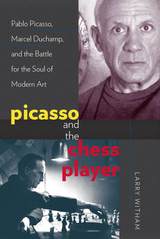 Picasso and the Chess Player: Pablo Picasso, Marcel Duchamp, and the Battle for the Soul of Modern Art
Larry Witham
University Press of New England, 2013 In the fateful year of 1913, events in New York and Paris launched a great public rivalry between the two most consequential artists of the twentieth century, Pablo Picasso and Marcel Duchamp. The New York Armory Show art exhibition unveiled Duchamp’s Nude Descending a Staircase, a “sensation of sensations” that prompted Americans to declare Duchamp the leader of cubism, the voice of modern art. In Paris, however, the cubist revolution was reaching its peak around Picasso. In retrospect, these events form a crossroads in art history, a moment when two young bohemians adopted entirely opposite views of the artist, giving birth to the two opposing agendas that would shape all of modern art. Today, the museum-going public views Pablo Picasso as the greatest figure in modern art. Over his long lifetime, Picasso pioneered several new styles as the last great painter in the Western tradition. In the rarefied world of artists, critics, and collectors, however, the most influential artist of the last century was not Picasso, but Marcel Duchamp: chess player, prankster, and a forefather of idea-driven dada, surrealism, and pop art. Picasso and the Chess Player is the story of how Picasso and Duchamp came to define the epochal debate between modern and conceptual art—a drama that features a who’s who of twentieth-century art and culture, including Henri Matisse, Gertrude Stein, André Breton, Salvador Dalí, and Andy Warhol. In telling the story, Larry Witham weaves two great art biographies into one tumultuous century.
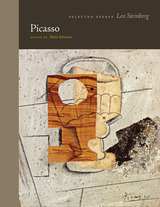 Picasso: Selected Essays
Leo Steinberg
University of Chicago Press, 2022 The fourth volume in the Essays by Leo Steinberg series, focusing on the artist Pablo Picasso.
Leo Steinberg was one of the most original art historians of the twentieth century, known for taking interpretive risks that challenged the profession by overturning reigning orthodoxies. In essays and lectures ranging from old masters to modern art, he combined scholarly erudition with eloquent prose that illuminated his subject and a credo that privileged the visual evidence of the image over the literature written about it. His writings, sometimes provocative and controversial, remain vital and influential reading. Steinberg’s perceptions evolved from long, hard looking at his objects of study. Almost everything he wrote included passages of formal analysis but always put into the service of interpretation.
This volume brings together Steinberg’s essays on Pablo Picasso, many of which have been studied and debated for decades, such as “The Philosophical Brothel,” as well as unpublished lectures, including “The Intelligence of Picasso,” a wide-ranging look at Picasso’s enduring ambition to stretch the agenda of representation, from childhood drawings to his last self-portrait. An introduction by art historian Richard Shiff contextualizes these works and illuminates Steinberg’s lifelong dedication to refining the expository, interpretive, and rhetorical features of his writing.
Picasso is the fourth volume in a series that presents Steinberg’s writings, selected and edited by his longtime associate Sheila Schwartz.
Picasso's Demoiselles: The Untold Origins of a Modern Masterpiece
Suzanne Preston Blier
Duke University Press, 2019 In Picasso's Demoiselles, eminent art historian Suzanne Preston Blier uncovers the previously unknown history of Pablo Picasso's Les Demoiselles d’Avignon, one of the twentieth century's most important, celebrated, and studied paintings. Drawing on her expertise in African art and newly discovered sources, Blier reads the painting not as a simple bordello scene but as Picasso's interpretation of the diversity of representations of women from around the world that he encountered in photographs and sculptures. These representations are central to understanding the painting's creation and help identify the demoiselles as global figures, mothers, grandmothers, lovers, and sisters, as well as part of the colonial world Picasso inhabited. Simply put, Blier fundamentally transforms what we know about this revolutionary and iconic work.
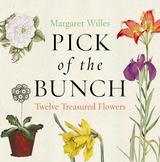 Pick of the Bunch: Twelve Treasured Flowers
Margaret Willes
Bodleian Library Publishing, 2009
In the dark, bitter days of winter, when the ground lies frozen and snow-covered, it can be hard to believe that mere months before, gardens and window boxes were bursting forth with fragrant, colorful blossoms. Today on the frosty walk home, at least we can pick up cut flowers at the store to remind us of the spring to come. But before the technological miracles of hothouses and refrigeration, flowers could only be captured for the winter months by artists and painters. Some of the finest flower-pieces ever painted were by Dutch and Flemish artists in the seventeenth century, which depict flowers in vases of metal and porcelain, sometimes with insects and butterflies nestling in petals or clinging to stalks. From these flower-pieces we can see what Europeans of the time considered desirable flowers: the rose, iris, carnation, lily, snowdrop, violet, fritillary, narcissus, tulip, daffodil, and hyacinth—many of which are still our favorites today.
Alongside lush color botanical illustrations, Pick of the Bunch presents the social history of these flora—how they arrived in our gardens; how they were bought, acquired and displayed; and who were their devotees and cultivators. The book delves into their symbolic associations in classical and Christian traditions and examines the complex language of flowers employed by the Victorians. Beautiful to behold and engagingly written, Pick of the Bunch is a wonderful gift for any garden lover and will be a warm, much needed glimpse of spring and summer throughout the cold, barren months.
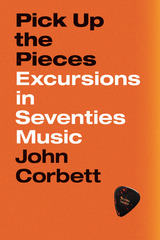 Pick Up the Pieces: Excursions in Seventies Music
John Corbett
University of Chicago Press, 2019 Unless you lived through the 1970s, it seems impossible to understand it at all. Drug delirium, groovy fashion, religious cults, mega corporations, glitzy glam, hard rock, global unrest—from our 2018 perspective, the seventies are often remembered as a bizarre blur of bohemianism and disco. With Pick Up the Pieces, John Corbett transports us back in time to this thrillingly tumultuous era through a playful exploration of its music. Song by song, album by album, he draws our imaginations back into one of the wildest decades in history.
Rock. Disco. Pop. Soul. Jazz. Folk. Funk. The music scene of the 1970s was as varied as it was exhilarating, but the decade’s diversity of sound has never been captured in one book before now. Pick Up the Pieces gives a panoramic view of the era’s music and culture through seventy-eight essays that allow readers to dip in and out of the decade at random or immerse themselves completely in Corbett’s chronological journey.
An inviting mix of skilled music criticism and cultural observation, Pick Up the Pieces is also a coming-of-age story, tracking the author’s absorption in music as he grows from age seven to seventeen. Along with entertaining personal observations and stories, Corbett includes little-known insights into musicians from Pink Floyd, Joni Mitchell, James Brown, and Fleetwood Mac to the Residents, Devo, Gal Costa, and Julius Hemphill.
A master DJ on the page, Corbett takes us through the curated playlist that is Pick Up the Pieces with captivating melody of language and powerful enthusiasm for the era. This funny, energetic book will have readers longing nostalgically for a decade long past.
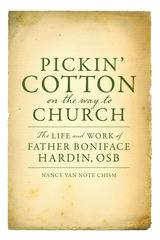 Pickin’ Cotton on the Way to Church: The Life and Work of Father Boniface Hardin, OSB
Nancy Van Note Chism
Indiana Historical Society Press, 2019 Pickin’ Cotton on the Way to Church highlights the life of Father Boniface Hardin, a Benedictine monk. James Dwight Randolph (Randy) Hardin was born on November 18, 1933, in Bardstown, Kentucky, educated in Catholic schools in Kentucky, and thirteen years old when he asked to become a priest. Excluded from the seminaries in Kentucky because of his race, he enrolled in Saint Meinrad Seminary in Spencer County, Indiana, which had just started accepting black students. After six years of study he took his vows as monk and was given the name Boniface. He was ordained a priest in 1959 and attained a graduate degree in 1963.
In 1965 Father Hardin accepted the position of associate pastor at Holy Angels Catholic Church, a predominately black parish in Indianapolis. Father Hardin was a social activist who spoke out against poverty, segregation, police brutality, and fought against the construction of an interstate highway that would adversely affect the black community. Such actions were considered inappropriate for a priest and the Archbishop of Indianapolis removed him from his position at Holy Angels.
Although reinstated due to public outcries, Father Hardin soon left Holy Angels, and, along with Sister Jane Shilling, opened the Martin Center, where they could advocate full time for the poor and disenfranchised through a series of programs and services. Realizing the correlation between education and career advancement, Father Boniface and Sister Jane founded Martin University, the only predominately African American institution of higher learning in Indiana. The university continues to play a unique role in the community, with a special focus on educational opportunities to those who have been too often discounted, discouraged, and disregarded by society.
Although Father Hardin was widely known in Indiana during his lifetime, accumulating many awards and honors, it is important to document his life and work for posterity. It is hoped that this volume will provide an overview of his story and lay the foundation for other scholarly efforts.
Picking Up the Tab: The Life and Movies of Martin Ritt
Carlton Jackson
University of Wisconsin Press, 1994 Martin Ritt has been hailed as the United States’s greatest maker of social films. From No Down Payment early in his career to Stanley and Iris, his last production, he delineated the nuances of American society. In between were other social statements such as Hud, Sounder, The Spy Who Came In From the Cold, Norma Rae, and The Great White Hope.
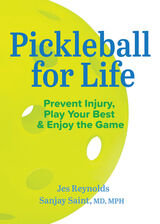 Pickleball for Life: Prevent Injury, Play Your Best, & Enjoy the Game
Jes Reynolds and Sanjay Saint
Michigan Publishing, 2022 Pickleball is the fastest-growing sport in America, in large part because it is so accessible. It seems like everyone can play it, regardless of age or athletic ability. Bursts of high-intensity effort during a game, however, can lead to injuries. Overstretching to reach a ball, taking a tumble during a point, or not adequately warming up before a game is all too common. While it is easy to pick up a paddle and learn to play, it can be challenging to know how to prevent an injury. For this reason, PICKLEBALL FOR LIFE: PREVENT INJURY, PLAY YOUR BEST & ENJOY THE GAME is an important resource for all pickleball players. Coauthored by a personal fitness trainer and a physician, this book offers needed guidance to players at all skill levels and entry points. PICKLEBALL FOR LIFE helps readers through everything from a proper nutritional plan, pickleball training activities, and a head-to-toe approach for injury prevention to a brief pre- and postgame routine. The book also points to additional helpful resources, like videos that demonstrate appropriate exercises. With its easy-to-read conversational tone, readers will feel as though a personal trainer is helping them reach their unique pickleball goals.
"Reynolds & Saint share a totally engaging, personalized, honest and insightful guide to growing any players enjoyment of and benefit from pickle ball, with tools toward avoiding injury." - Robert Hogikyan
“This short book is full of tips that will help you to improve your overall health, reduce chance of injury, and improve your game, while maximizing your enjoyment of this amazing sport!” - Larry Junck
"Pickleball for Life is a concise guide to keeping you flexible and mobile not just for a better dinking game but to keep you on the court into your 80s." - Christy Howden, Co-owner of Wolverine Pickleball
"Reynolds & Saint place personal training at your fingertips. Their instruction not only improves your game but offers a safer solution to reduce pain after you play." - Vineet Chopra
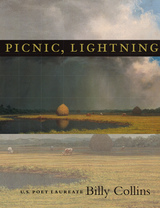 Picnic, Lightning
Billy Collins
University of Pittsburgh Press, 1998 Winner of the 1999 Paterson Poetry Prize
Over the past decade, Billy Collins has emerged as the most beloved American poet since Robert Frost, garnering critical acclaim and broad popular appeal. Annie Proulx admits, "I have never before felt possessive about a poet, but I am fiercely glad that Billy Collins is ours." John Updike proclaims his poems "consistently startling, more serious than they seem, they describe all the worlds that are and were and some others besides."
This special, limited edition celebrates Billy Collins's years as U.S. Poet Laureate. Picnic, Lightning--one of the books that helped establish and secure his reputation and popularity during the 1990s--combines humor and seriousness, wit and sublimity. His poems touch on a wide range of subjects, from jazz to death, from weather to sex, but share common ground where the mind and heart can meet. Whether reading him for the first time or the fiftieth, this collector's edition is a must-have for anyone interested in the poet the New York Times calls simply "the real thing."
 Pico della Mirandola’s Encounter with Jewish Mysticism
Chaim Wirszubski
Harvard University Press, 1989 Here is a major contribution to the history of Christian kabbalism by an eminent authority. Giovanni Pico della Mirandola, a central figure in Lorenzo de' Medici's Platonic Academy, was the first notable Christian humanist to become learned in the Kabbalah; and the two sets of kabbalistic theses he wrote started Kabbalah on its Christian career. This is a study of those theses, their meaning, and their relation to the Hebrew texts Pico studied.
Chaim Wirszubski establishes which Hebrew texts Pico used and identifies the sources for individual theses. In the process he provides special insight into Jewish Kabbalah and its several schools. Pico's goal was to use Jewish Kabbalah to confirm Christian theology. In his analysis of Conclusiones Cabalisticae, Wirszubski elucidates this Christian kabbalistic doctrine and shows how it was tied to other currents in Renaissance thought, especially platonism and magic. This study will be valued by students of mysticism and of Renaissance thought.
The Pictograph Murders
P. G. Karamasines
Signature Books, 2004 Alex McKelvey longs to fit in. She doesn’t realize that her earth-mother style—the connections she feels toward the earth and to a certain eerie pictograph panel—sets her off from the crowd. Wanting only to enjoy the beauty of the Utah desert, she packs up her gear and her Siberian husky, Kit, and joins an archaeological dig. But when the site’s owner vanishes, forces combine to sweep up Alex and Kit in a whirlwind of pot hunting, witchcraft, and murder. Who is that stranger who suddenly appears, styling himself on the folklore figure Coyote? His ability to draw the best—and the worst—from Alex leads her to the dismaying discovery that the villain she seeks is closer at hand than she had thought.
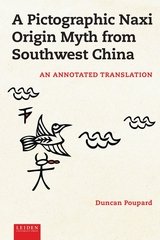 A Pictographic Naxi Origin Myth from Southwest China: An Annotated Translation
Duncan Poupard
Leiden University Press, 2023 1.This is the most comprehensive translation of a Naxi text in English to appear for over half a century. By presenting a historically important translation manuscript for both the history of missionary translation in China and for Dutch sinology, this book allows modern audiences a chance to access the unique, semi-oral ritual tradition of the Naxi via detailed annotations. 2. The Naxi source manuscript, presented in high quality images, will be complemented by digital reconstructions of each section of the text, with each graph numbered to allow readers a fuller understanding of how such semi-oral texts are read, making it the first reader of the Naxi script to be produced in English. 3. Back-translation and comparative research has allowed for the recreation of an approximation of the original early twentieth century reading given to the original translator Elise Scharten by a Naxi ritual specialist.
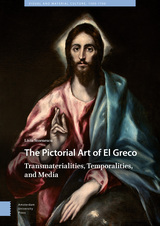 The Pictorial Art of El Greco: Transmaterialities, Temporalities, and Media
Livia Stoenescu
Amsterdam University Press, 2018 The Pictorial Art of El Greco: Transmaterialities, Temporalities, and Media investigates El Greco’s pictorial art as foundational to the globalising trends manifested in the visual culture of early modernity. It also exposes the figurative, semantic, and allegorical senses that El Greco created to challenge an Italian Renaissance-centered discourse. Even though he was guided by the unprecedented burgeoning of devotional art in the post-Tridentine decades and by the expressive possibilities of earlier religious artifacts, especially those inherited from the apostolic past, the author demonstrates that El Greco forged his own independent trajectory. While his paintings have been studied in relation to the Italian and Spanish school traditions, his pictorial art in a global Mediterranean context continues to receive scant attention. Taking a global perspective as its focus, the book sheds new light on El Greco’s highly original contribution to early Mediterranean and multi-institutional configurations of the Christian faith in Byzantium, Venice, Rome, Toledo, and Madrid.
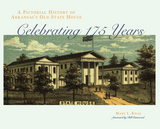 A Pictorial History of Arkansas's Old State House: Celebrating 175 Years
Mary L. Kwas
University of Arkansas Press, 2011 Arkansas's Old State House, arguably the most famous building in the state, was conceived during the territorial period and has served through statehood. A History of Arkansas's Old State House traces the history of the architecture and purposes of the remarkable building. The history begins with Gov. John Pope's ideas for a symbolic state house for Arkansas and continues through the construction years and an expansion in 1885. After years of deterioration, the building was abandoned by the state government, and the Old State House then became a medical school and office building. Kwas traces the subsequent fight for the building's preservation on to its use today as a popular museum of Arkansas history and culture. Brief biographies of secretaries of state, preservationists, caretakers, and others are included, and the book is generously illustrated with early and seldom-seen photographs, drawings, and memorabilia.
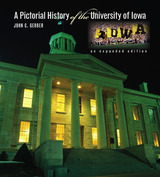 A Pictorial History of the University of Iowa: An Expanded Edition
John C. Gerber
University of Iowa Press, 1988 The founders of the new state of Iowa in 1847 waited only fifty-nine days to charter a university. Eight years later the first classes were held in a rented building, still very much on the edge of the western frontier, surrounded by prairie and pastureland. It is difficult to imagine such a scene today compared to the University of Iowa's contemporary setting, with its 26,000 students, its 250-plus buildings, huge medical complex, performing arts campus, and athletic facilities, all clustered around the grand centerpiece of the Old Capitol. First published in 1988, this gracefully written pictorial narrative deftly compresses the history of this distinguished institution into a readable and entertaining text enriched by an impressive selection of over 350 photographs gleaned from the university's archives. Photos and text capture Iowa's major research accomplishments--in space exploration, medical research, educational testing, and the ground-breaking advanced degree programs for creative work in all the arts--as well as the many great moments in Hawkeye sports. Also included is an account of the evolution of the institution itself, of the significant teachers and administrators who guided the university's progress through world wars, periods of intense social upheaval, and the more tranquil years of strength and growth.With an all-new album of fifty color photos that both celebrate and define the last twenty years of the university's history, the expanded paperback edition of this classic book is an enduring testament to the unique character of the University of Iowa, its strong commitment to education, research, and the creative arts, and its remarkable service to the state.
Pictorial Nominalism: On Marcel Duchamp’s Passage from Painting to the Readymade
Thierry De Duve
University of Minnesota Press, 2005 Beginning with the instance in 1912 when Marcel Duchamp wrote in a note to himself, "No more painting, get a job," Thierry de Duve reviews in Pictorial Nominalism the implications of the readymade for art and representation. Arguing that the readymade belongs to that moment in the history of painting when both figuration and the practice of painting become "impossible," de Duve presents a psychoanalytically informed account of the birth of abstraction.Differing considerably from such thinkers as Clement Greenberg and Peter Burger, de Duve demonstrates that the readymade is the link between painting in particular and art at large.
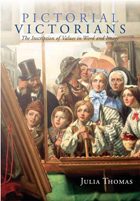 Pictorial Victorians: The Inscription of Values in Word and Image
Julia Thomas
Ohio University Press, 2005 The Victorians were image obsessed. The middle decades of the nineteenth century saw an unprecedented growth in the picture industry. Technological advances enabled the Victorians to adorn with images the pages of their books and the walls of their homes. But this was not a wholly visual culture. Pictorial Victorians focuses on two of the most popular mid-nineteenth-century genres—illustration and narrative painting—that blurred the line between the visual and textual.
Illustration negotiated text and image on the printed page, while narrative painting juxtaposed the two media in its formulation of pictorial stories. Author Julia Thomas reassesses mid-nineteenth-century values in the light of this interplay. The dialogue between word and image generates meanings that are intimately related to the Victorians' image of themselves. Illustrations in Victorian publications and the narrative scenes that lined the walls of the Royal Academy reveal the Victorians' ideas about the world in which they lived and their notions of gender, class, and race.
Pictorial Victorians surveys a range of material, from representations of the crinoline, to the illustrations that accompanied Harriet Beecher Stowe’s novel Uncle Tom's Cabin and Tennyson's poetry, to paintings of adultery. It demonstrates that the space between text and image is one in which values are both constructed and questioned.
The Picts Re-Imagined
Julianna Grigg
Arc Humanities Press, 2018 Pictish studies is undergoing significant revision and invigoration, with recent archaeological discoveries and new methodologies in archaeology, cultural geography and art history prompting a re-assessment of Pictish cultural and social development. We can now say more about the cultural and political lives of the Picts than ever before, and these new findings are enabling a fresh perspective on the wider development of Early Medieval polities across the Latin west. This short book provides an exciting and informed synthesis of our current understanding of Pictish history and material remains.
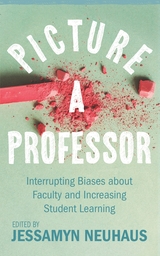 Picture a Professor: Interrupting Biases about Faculty and Increasing Student Learning
Jessamyn Neuhaus
West Virginia University Press, 2022 “Does a service to all who would prefer a different path, offering realistic strategies to engage students in undermining scholarly stereotypes.”—Science
Picture a Professor is a collection of evidence-based insights and intersectional teaching strategies crafted by and for college instructors. It aims to inspire transformative student learning while challenging stereotypes about what a professor looks like. Representing a variety of scholarly disciplines, the volume’s contributing authors offer practical advice for effectively navigating student preconceptions about embodied identity and academic expertise. Each contributor recognizes the pervasiveness of racialized, gendered, and other biases about professors and recommends specific ways to respond to and interrupt such preconceptions—helping students, teachers, and others reenvision what we think of when we picture a professor. Educators at every stage of their career will find affirming acknowledgment of the ways systemic inequities affect college teaching conditions, as well as actionable advice about facilitating student learning with innovative course design, classroom activities, assessment techniques, and more.
The Picture in Question: Mark Tansey and the Ends of Representation
Mark C. Taylor
University of Chicago Press, 1999 A rich exploration of the possibilities of representation after Modernism, Mark Taylor's new study charts the logic and continuity of Mark Tansey's painting by considering the philosophical ideas behind Tansey's art. Taylor examines how Tansey uses structuralist and poststructuralist thought as well as catastrophe, chaos, and complexity theory to create paintings that please the eye while provoking the mind. Taylor's clear accounts of thinkers ranging from Plato, Kant, and Hegel to Merleau-Ponty, Derrida, and de Man will be an invaluable contribution to students and teachers of art.
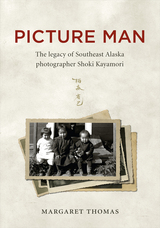 Picture Man: The Legacy of Southeast Alaska Photographer Shoki Kayamori
Margaret Thomas
University of Alaska Press, 2015 In 1912, Shoki Kayamori and his box camera arrived in a small Tlingit village in southeast Alaska. At a time when Asian immigrants were forbidden to own property and faced intense racial pressure, the Japanese-born Kayamori put down roots and became part of the Yakutat community. For three decades he photographed daily life in the village, turning his lens on locals and migrants alike, and gaining the nickname “Picture Man.” But as World War II drew near, his passion for photography turned dangerous, as government officials called out Kayamori as a potential spy. Despondent, Kayamori committed suicide, leaving behind an enigmatic photographic legacy.
In Picture Man, Margaret Thomas views Kayamori’s life through multiple lenses. Using Kayamori’s original photos, she explores the economic and political realities that sent Kayamori and thousands like him out of Japan toward opportunity and adventure in the United States, especially the Pacific Northwest. She reveals the tensions around Asian immigrants on the West Coast and the racism that sent many young men north to work in the canneries of Alaska. And she illuminates the intersecting—and at times conflicting—lives of villagers and migrants in a time of enormous change. Part history, part biography, part photographic showcase, Picture Man offers a fascinating new view of Alaska history.
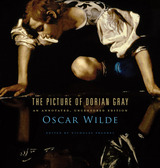 The Picture of Dorian Gray: An Annotated, Uncensored Edition
Oscar Wilde
Harvard University Press, 2011 The Picture of Dorian Gray altered the way Victorians understood the world they inhabited. It heralded the end of a repressive Victorianism, and after its publication, literature had—in the words of biographer Richard Ellmann—“a different look.” Yet the Dorian Gray that Victorians never knew was even more daring than the novel the British press condemned as “vulgar,” “unclean,” “poisonous,” “discreditable,” and “a sham.” Now, more than 120 years after Wilde handed it over to his publisher, J. B. Lippincott & Company, Wilde’s uncensored typescript is published for the first time, in an annotated, extensively illustrated edition.
The novel’s first editor, J. M. Stoddart, excised material—especially homosexual content—he thought would offend his readers’ sensibilities. When Wilde enlarged the novel for the 1891 edition, he responded to his critics by further toning down its “immoral” elements. The differences between the text Wilde submitted to Lippincott and published versions of the novel have until now been evident to only the handful of scholars who have examined Wilde's typescript.
Wilde famously said that Dorian Gray “contains much of me”: Basil Hallward is “what I think I am,” Lord Henry “what the world thinks me,” and “Dorian what I would like to be—in other ages, perhaps.” Wilde’s comment suggests a backward glance to a Greek or Dorian Age, but also a forward-looking view to a more permissive time than his own, which saw Wilde sentenced to two years’ hard labor for gross indecency. The appearance of Wilde’s uncensored text is cause for celebration.
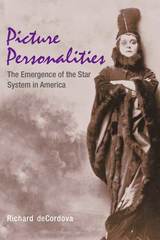 Picture Personalities: The Emergence of the Star System in America
Richard deCordova
University of Illinois Press, 1990 Moving pictures existed for over a decade before anything resembling a star system appeared. Then, within the space of a very few years, American cinema went from being completely devoid of stars to being completely dependent on them. Picture Personalities is an invaluable account of this crucial development in cinema and modern culture.
Conventional wisdom attributes the rise of the star system to the charisma of individual performers or to the public's desire to idolize an appealing star. In Picture Personalities, Richard deCordova argues that the fledgling movie industry and the press conspired to develop the star system, along with a system of discourse to support it.
How actors became stars and how they began to assume public identities distinct from their fictional roles was closely tied to the journalistic discourse of the period, produced by the trade press, newspapers, general periodicals, fan magazines, publicity stills, posters, and other material. DeCordova shows how the studios worked to fabricate moral images of the stars' marriages and personal lives and how a series of star scandals in the 1920s challenged those images and brought about changes in the conventions of representing stars. A new foreword by Corey K. Creekmur enhances this first paperback edition.
Picture Theory: Essays on Verbal and Visual Representation
W. J. T. Mitchell
University of Chicago Press, 1994 What precisely, W. J. T. Mitchell asks, are pictures (and theories of pictures) doing now, in the late twentieth century, when the power of the visual is said to be greater than ever before, and the "pictorial turn" supplants the "linguistic turn" in the study of culture? This book by one of America's leading theorists of visual representation offers a rich account of the interplay between the visible and the readable across culture, from literature to visual art to the mass media.
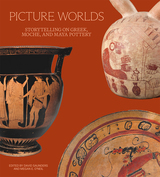 Picture Worlds: Storytelling on Greek, Moche, and Maya Pottery
David Saunders
J. Paul Getty Trust, The, 2024 This abundantly illustrated volume is the first to explore the painted pottery of the ancient Greek, Moche, and Maya cultures side by side.
Satyrs and sphinxes, violent legumes, and a dancing maize deity figure in the stories painted on the pottery produced by the ancient Greek, Moche, and Maya cultures, respectively. Picture Worlds is the first book to examine the elaborately decorated terracotta vessels of these three distinct civilizations. Although the cultures were separated by space and time, they all employed pottery as a way to tell stories, explain the world, and illustrate core myths and beliefs. Each of these painted pots is a picture world. But why did these communities reach for pottery as a primary method of visual communication? How were the vessels produced and used? In this book, experts offer introductions to the civilizations, exploring these foundational questions and examining the painted imagery. Readers will be rewarded with a better understanding of each of these ancient societies, fascinating insights into their cultural commonalities and differences, and fresh perspectives on image making and storytelling, practices that remain vibrant to this day.
This volume is published to accompany an exhibition on view at the J. Paul Getty Museum at the Getty Villa from April 10 to July 29, 2024, and at the Michael C. Carlos Museum at Emory University from September 14 to December 15, 2024.
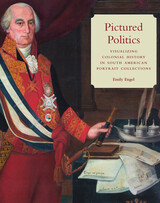 Pictured Politics: Visualizing Colonial History in South American Portrait Collections
By Emily Engel
University of Texas Press, 2020 The Spanish colonial period in South America saw artists develop the subgenre of official portraiture, or portraits of key individuals in the continent’s viceregal governments. Although these portraits appeared to illustrate a narrative of imperial splendor and absolutist governance, they instead became a visual record of the local history that emerged during the colonial occupation. Using the official portrait collections accumulated between 1542 and 1830 in Lima, Buenos Aires, and Bogotá as a lens, Pictured Politics explores how official portraiture originated and evolved to become an essential component in the construction of Ibero-American political relationships. Through the surviving portraits and archival evidence—including political treatises, travel accounts, and early periodicals—Emily Engel demonstrates that these official portraits not only belie a singular interpretation as tools of imperial domination but also visualize the continent's multilayered history of colonial occupation. The first stand alone analysis of South American portraiture, Pictured Politics brings to light the historical relevance of political portraits in crafting the history of South American colonialism.
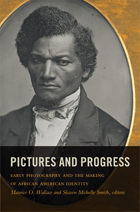 Pictures and Progress: Early Photography and the Making of African American Identity
Maurice O. Wallace and Shawn Michelle Smith, eds.
Duke University Press, 2012 Pictures and Progress explores how, during the nineteenth century and the early twentieth, prominent African American intellectuals and activists understood photography's power to shape perceptions about race and employed the new medium in their quest for social and political justice. They sought both to counter widely circulating racist imagery and to use self-representation as a means of empowerment. In this collection of essays, scholars from various disciplines consider figures including Frederick Douglass, Sojourner Truth, Ida B. Wells, Paul Laurence Dunbar, and W. E. B. Du Bois as important and innovative theorists and practitioners of photography. In addition, brief interpretive essays, or "snapshots," highlight and analyze the work of four early African American photographers. Featuring more than seventy images, Pictures and Progress brings to light the wide-ranging practices of early African American photography, as well as the effects of photography on racialized thinking. Contributors. Michael A. Chaney, Cheryl Finley, P. Gabrielle Foreman, Ginger Hill, Leigh Raiford, Augusta Rohrbach, Ray Sapirstein, Suzanne N. Schneider, Shawn Michelle Smith, Laura Wexler, Maurice O. Wallace
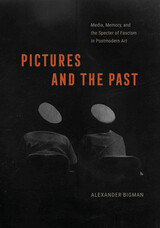 Pictures and the Past: Media, Memory, and the Specter of Fascism in Postmodern Art
Alexander Bigman
University of Chicago Press, 2024 A fresh take on the group of artists known as the Pictures Generation, reinterpreting their work as haunted by the history of fascism, the threat of its return, and the effects of its recurring representation in postwar American culture.
The artists of the Pictures Generation, converging on New York City in the late 1970s, indelibly changed the shape of American art. Rebelling against abstraction, they borrowed liberally from the aesthetics of mass media and sometimes the work of other artists. It has long been thought that the group’s main contribution was to upend received conceptions of authorial originality. In Pictures and the Past, however, art critic and historian Alexander Bigman shows that there is more to this moment than just the advent of appropriation art. He presents us with a bold new interpretation of the Pictures group’s most significant work, in particular its recurring evocations of fascist iconography.
In the wake of the original Pictures show, curated by Douglas Crimp in 1977, artists such as Sarah Charlesworth, Jack Goldstein, Troy Brauntuch, Robert Longo, and Gretchen Bender raised pressing questions about what it means to perceive the world historically in a society saturated by images. Bigman argues that their references to past cataclysms—to the violence wrought by authoritarianism and totalitarianism—represent not only a coded form of political commentary about the 1980s but also a piercing reflection on the nature of collective memory. Throughout, Bigman situates their work within a larger cultural context including parallel trends in music, fashion, cinema, and literature. Pictures and the Past probes the shifting relationships between art, popular culture, memory, and politics in the 1970s and ’80s, examining how the specter of fascism loomed for artists then—and the ways it still looms for us today.
 Pictures at an Execution
Wendy Lesser
Harvard University Press, 1993 This book is about murder—in life and in art—and about how we look at it and feel about it. At the center of Wendy Lesser’s investigation is a groundbreaking legal case in which a federal court judge was asked to decide whether a gas chamber execution would be broadcast on public television. Our grim and seemingly endless fascination with murder gets its day in court as Lesser conducts us through the proceedings, pausing along the way to reflect on the circumstances of violent death in our culture. Her book, itself a murder mystery of sorts, circling suspensefully around a central point, is also a meditation on murder in a civilized society—what we make of it in law, morality, and art.
Lesser narrates the trial with a sharp eye for detail and an absorbing sense of character. Questions that arise in the courtroom conjure other, broader ones: why are we drawn to murder, as an act and as a spectacle? Who in a murder story are we drawn to—victim, murderer, detective? Is such interest, even pleasure, morally suspect? Lesser’s reflections on these questions follow the culture in its danse macabre, from Norman Mailer’s Executioner’s Song to the Jacobean play The Changeling, from Errol Morris’s documentary The Thin Blue Line to Crime and Punishment, from Janet Malcolm’s The Journalist and the Murderer to Jim Thompson’s The Killer Inside Me, from Weegee’s photographs to television’s movie of the week. Always anchored in the courtroom, where the question of murder as theater is being settled in immediate, human terms, this circle of thought widens outward to the increasingly blurred borderline between real and fictional murder, between event and story, between murder as news and as art. As gripping as its subject, Pictures at an Execution ultimately brings us face to face with our own most disturbing cultural impulses.
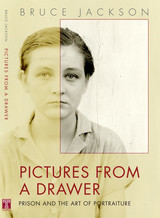 Pictures from a Drawer: Prison and the Art of Portraiture
Bruce Jackson
Temple University Press, 2009 For more than forty years, Bruce Jackson has been documenting—in books, photographs, audio recording and film—inmates' lives in American prisons. In November 1975, he acquired a collection of old ID photos while he was visiting the Cummins Unit, a state prison farm in Arkansas. They are published together for the first time in this remarkable book. The 121 images that appear here were likely taken between 1915-1940. As Jackson describes in an absorbing introduction, the function of these photos was not portraiture— their function was to "fold a person into the controlled space of a dossier." Here, freed from their prison "jackets" and printed at sizes far larger than their originals, these one-time ID photos have now become portraits. Jackson's restoration transforms what were small bureaucratic artifacts into moving images of real men and women. Pictures from a Drawer also contains an extraordinary description of everyday life at Cummins prison in the 1950s, written originally by hand and presented to Jackson in 1973 by its author, a longtime inmate.
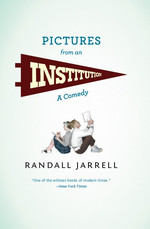 Pictures from an Institution: A Comedy
Randall Jarrell
University of Chicago Press, 2010 Beneath the unassuming surface of a progressive women’s college lurks a world of intellectual pride and pomposity awaiting devastation by the pens of two brilliant and appalling wits. Randall Jarrell’s classic novel was originally published to overwhelming critical acclaim in 1954, forging a new standard for campus satire—and instantly yielding comparisons to Dorothy Parker’s razor-sharp barbs. Like his fictional nemesis, Jarrell cuts through the earnest conversations at Benton College—mischievously, but with mischief nowhere more wicked than when crusading against the vitriolic heroine herself.
“A most literate account of a group of most literate people by a writer of power. . . . A delight of true understanding.”—Wallace Stevens
“I’m greatly impressed by the real fun, the incisive satire, the closeness of observation, and in the end by a kind of sympathy and human warmth. It’s a remarkable book.”—Robert Penn Warren
“Move over Dorothy Parker. Pictures . . . is less a novel than a series of poisonous portraits, set pieces, and endlessly quotable put-downs. Read it less for plot than sharp satire, Jarrell’s forte.”—Mary Welp
“One of the wittiest books of modern times.”—New York Times
“[T]he father of the modern campus novel, and the wittiest of them all. Extraordinary to think that ‘political correctness’ was so deliciously dissected 50 years ago.”—Noel Malcolm, Sunday Telegraph
“A sustained exhibition of wit in the great tradition. . . . Immensely and very devastatingly shrewd.”—Edmund Fuller, Saturday Review
“[A] work of fiction, and a dizzying and brilliant work of social and literary criticism. Not only ‘a unique and serious joke-book,’ as Lowell called it, but also a meditation made up of epigrams.”—Michael Wood
 Pictures of Romance: Form against Context in Painting and Literature
Wendy Steiner
University of Chicago Press, 1988 How do pictures tell stories? Why does the literary romance so often refer to paintings and other visual art objects? Beginning with these two seemingly unrelated questions, Wendy Steiner reveals an intricate exchange between the visual arts and the literary romance.
Romances violate the casual, temporal, and logical cohesiveness of realist novels, and they do so in part by depicting love as a state of suspension, a condition outside of time. Steiner argues that because Renaissance and post-Renaissance painting also represents a suspended moment of perception with "unnatural" clarity and compression of meaning, it readily serves the romance as a symbol of antirealism. Yet the atemporality of stopped-action painting was actually an attempt to achieve pictorial realism—the way things "really" look. It is this paradox that interests Steiner: to signal their departure from realism, romances evoke the symbol of "realistic" visual artwork. Steiner explores this problem through analyses of Keats, Hawthorne, Joyce, and Picasso. She then examines a return to narrative conventions in visual art in the twentieth century, in the work of Lichtenstein and Warhol, and speculates on the fate of pictorial storytelling and the romance in postmodern art. An aesthetic fantasia of sorts, this study combines theory and analysis to illuminate an unexpected interconnection between literature and the visual arts.
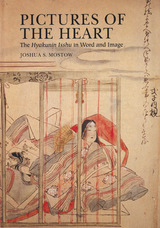 Pictures of the Heart: The Hyakunin Isshu in Word and Image
Joshua S. Mostow
University of Michigan Press, 2015
The Hyakunin Isshu, or One Hundred Poets, One Poem Each collection, is a sequence of one hundred Japanese poems in the tanka form, selected by the famous poet and scholar Fujiwara no Teika (1162-1241) and arranged, in part, to represent the history of Japanese poetry from the seventh century down to Teika's own day. The anthology is, without doubt, the most popular and widely known collection of poetry in Japan - a distinction it has maintained for hundreds of years. In this study, Joshua Mostow challenges the idea of a final or authoritative reading of the Hyakunin Isshu and presents a refreshing, persuasive case for a reception history of this seminal work.
In addition to providing a new translation of this classic text and biographical information on each poet, Mostow examines issues relating to text and image that are central to the Japanese arts from the Heian into the early modern period. By using Edo-period woodblock illustrations as pictorializations of the poems - as "pictures of the heart," or meaning, of the poems - text and image are pieced together in a holistic approach that will stand as a model for further research in the interrelationship between Japanese visual and verbal art. [A/GB]
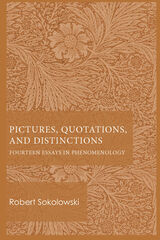 Pictures, Quotations, and Distinctions: Fourteen Essays in Phenomenology
Robert Sokolowski
Catholic University of America Press, 2022 One of the major contributions of Husserl’s phenomenology has been to show that things present themselves to us in strikingly different ways. There are various kinds of presentations and something like logical structures in them that allow the truth of things to appear. Being pictured is different from being named, and also different from being distinguished from something else. The fourteen essays in this volume provide concrete and colorful examples of strategic forms of presentation, and they also shed light on us as persons who exercise our intelligence when we let things appear in these various ways. Even our moral conduct takes place because something appears to us as to be done or to be avoided in a situation that calls for action.
When we quote what someone has said, for example, we express things as they have been expressed by someone else, and we invoke the authority of that other speaker. In measurement, we either bring external units, such as inches or yards, to determine the “how much” of things; or we engage in “internal measurement” and use one part of the object to determine the size of the whole. In moral action, the deep core of what we do involves either benevolence or malevolence, and in such conduct we shape or confirm ourselves as good or bad. Even the timing of things, the measurement of their motions and the determination of their before and after, in both clock and calendar time, cannot take place without the involvement of the person’s own interwoven perceptions, remembrances, and anticipations, all held together by the underlying flow of personal as well as worldly temporality.
The essays in this book are an attempt to blend the philosophical approaches of Aristotle and Husserl, the classical and the modern, to help us appreciate what Aristotle called “being as the true,” and to show how the human person is involved in this enterprise.
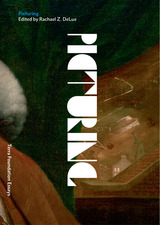 Picturing
Edited by Rachael Z. DeLue
Terra Foundation for American Art, 2016 The history of American art is a history of objects, but it is also a history of ideas about how we create and consume these objects. As Picturing convincingly shows, the critical tradition in American art has given rise to profound thinking about the nature and capacity of images and formed responses to some of most pressing problems of picturing: What is an image, and why make one? What do images do?
The first volume in a new series on critical concerns in the history of American art, Picturing brings together essays by a distinguished international group of scholars who discuss the creation and consumption of images from the early modern period through the end of the twentieth century. Some of the contributions focus on art critical texts, like Gertrude Stein’s portrait of Cézanne, while others have as their point of departure particular artworks, from a portrait of Benjamin Franklin to Eadweard Muybridge’s nineteenth-century photographs of the California Coast. Works that addressed images and image making were not confined to the academy; they spilled out into poetry, literature, theater, and philosophy, and the essays’ considerations likewise range freely, from painting to natural history illustrations, travel narratives, and popular fiction. Together, the contributions demonstrate a rich deliberation that thoroughly debunks the notion that American art is merely derivative of a European tradition.
With a wealth of new research and full-color illustrations, Picturing significantly expands the terrain of scholarship on American art.
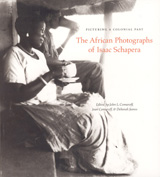 Picturing a Colonial Past: The African Photographs of Isaac Schapera
Edited by John L. Comaroff, Jean Comaroff, and Deborah James
University of Chicago Press, 2007 This volume presents for the first time the selected photographs of the renowned British anthropologist Isaac Schapera (1905–2003). Taken between 1929 and 1934, largely during his earliest work among the Kgatla peoples of Bechuanaland (now Botswana), the 136 images in this selection reveal an emotional engagement and aesthetic impulse that Schapera seldom expressed in his writings. Covering a broad spectrum of daily activities, they include depictions of everything from pot making, thatching, and cattle herding to village architecture, vernacular medicine, and rainmaking ceremonies. Visually fascinating and of exceptional quality, these images capture the uniqueness of an African people in a particular time and place. They are contexualized and their significance explained in Jean and John Comaroff’s insightful introduction, while Adam Kuper’s illuminating biographical sketch of Schapera provides new insight into the life of the photographer. Picturing a Colonial Past reveals not only a rare side of old Botswana, but also of one of the most famous anthropologist who worked there.
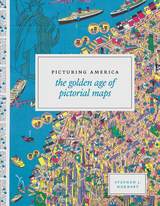 Picturing America: The Golden Age of Pictorial Maps
Stephen J. Hornsby
University of Chicago Press, 2017 Instructive, amusing, colorful—pictorial maps have been used and admired since the first medieval cartographer put pen to paper depicting mountains and trees across countries, people and objects around margins, and sea monsters in oceans. More recent generations of pictorial map artists have continued that traditional mixture of whimsy and fact, combining cartographic elements with text and images and featuring bold and arresting designs, bright and cheerful colors, and lively detail. In the United States, the art form flourished from the 1920s through the 1970s, when thousands of innovative maps were mass-produced for use as advertisements and decorative objects—the golden age of American pictorial maps.
Picturing America is the first book to showcase this vivid and popular genre of maps. Geographer Stephen J. Hornsby gathers together 158 delightful pictorial jewels, most drawn from the extensive collections of the Library of Congress. In his informative introduction, Hornsby outlines the development of the cartographic form, identifies several representative artists, describes the process of creating a pictorial map, and considers the significance of the form in the history of Western cartography. Organized into six thematic sections, Picturing America covers a vast swath of the pictorial map tradition during its golden age, ranging from “Maps to Amuse” to “Maps for War.” Hornsby has unearthed the most fascinating and visually striking maps the United States has to offer: Disney cartoon maps, college campus maps, kooky state tourism ads, World War II promotional posters, and many more. This remarkable, charming volume’s glorious full-color pictorial maps will be irresistible to any map lover or armchair traveler.
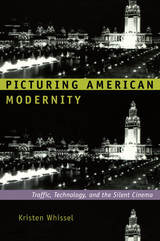 Picturing American Modernity: Traffic, Technology, and the Silent Cinema
Kristen Whissel
Duke University Press, 2008 In Picturing American Modernity, Kristen Whissel investigates the relationship between early American cinema and the experience of technological modernity. She demonstrates how between the late 1890s and the eve of the First World War moving pictures helped the U.S. public understand the possibilities and perils of new forms of “traffic” produced by industrialization and urbanization. As more efficient ways to move people, goods, and information transformed work and leisure at home and contributed to the expansion of the U.S. empire abroad, silent films presented compelling visual representations of the spaces, bodies, machines, and forms of mobility that increasingly defined modern life in the United States and its new territories. Whissel shows that by portraying key events, achievements, and anxieties, the cinema invited American audiences to participate in the rapidly changing world around them. Moving pictures provided astonishing visual dispatches from military camps prior to the outbreak of fighting in the Spanish-American War. They allowed audiences to delight in images of the Pan-American Exposition, and also to mourn the assassination of President McKinley there. One early film genre, the reenactment, presented spectators with renditions of bloody battles fought overseas during the Philippine-American War. Early features offered sensational dramatizations of the scandalous “white slave trade,” which was often linked to immigration and new forms of urban work and leisure. By bringing these frequently distant events and anxieties “near” to audiences in cities and towns across the country, the cinema helped construct an American national identity for the machine age.
Picturing Animals and Plants in Early Modern China and Japan: Innovation, Experiments, and Anxieties
Fan Lin
Amsterdam University Press, 2025 The seven articles in this edited volume address the complex meanings that visual representations of plants and animals gained in early modern China and Japan. They aim to understand animals and plants in the new contexts of empirical and epistemological concerns, political and social agendas, and cultural interests. In particular, they examine the ways in which scholars, professional painters, and publishers engendered the sociohistorical meanings of the images.
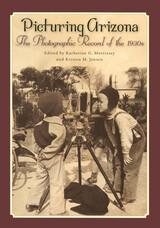 Picturing Arizona: The Photographic Record of the 1930s
Edited by Katherine G. Morrissey and Kirsten Jensen
University of Arizona Press, 2005 As cultural documents, as works of art, and as historical records, photographs of 1930s Arizona tell a remarkable story. They capture enduring visions of the Depression that linger in cultural memory: dust storms, Okies on their way to California, breadlines, and ramshackle tent cities. They also reflect a more particular experience and a unique perspective.
This book places the work of local Arizonans alongside that of federal photographers both to illuminate the impact of the Depression on the state’s distinctive racial and natural landscapes and to show the influence of differing cultural agendas on the photographic record. The more than one hundred images—by well-known photographers such as Dorothea Lange and Laura Gilpin as well as by an array of less familiar photographers—represent a variety of purposes and perspectives, from public to personal, political to promotional. Six essays and three photo-essays bring together prominent authorities in history, the arts, and other fields who provide diverse perspectives on this period in Arizona and American history. Viewed together, the words and images capture a Depression-era Arizona bustling with activity as federally funded construction projects and seasonal agricultural jobs brought migrants and newcomers to the state. They convey the celebrations and the struggles of commercial photographers, archaeologists, city folks, farmers, tourists, native peoples and others in these hard times.
As the economic strains of the decade reverberated through the state, local photographers documented the lives of Arizona residents—including those frequently overlooked by historians. As this book persuasively shows, photographs can conceal as much as they reveal. A young Mexican American girl stands in front of a backdrop that hides the outhouse behind her, a deeply moving image for what it suggests about the efforts of her family to conceal their economic circumstances. Yet this image is a perfect metaphor for all the photographs in this book: stories remain hidden, but when viewers begin to question what they cannot see, pictures resonate more loudly than ever before.
This book is a history of Arizona written from the photographic record, offering a point of view that may differ from the written record. From the images and the insights of the authors, we can gain a new appreciation of how one state—and its indomitable people—weathered our nation’s toughest times.
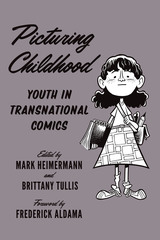 Picturing Childhood: Youth in Transnational Comics
Edited by Mark Heimermann and Brittany Tullis, Foreword by Frederick Aldama
University of Texas Press, 2017 Comics and childhood have had a richly intertwined history for nearly a century. From Richard Outcault’s Yellow Kid, Winsor McCay’s Little Nemo, and Harold Gray’s Little Orphan Annie to Hergé’s Tintin (Belgium), José Escobar’s Zipi and Zape (Spain), and Wilhelm Busch’s Max and Moritz (Germany), iconic child characters have given both kids and adults not only hours of entertainment but also an important vehicle for exploring children’s lives and the sometimes challenging realities that surround them. Bringing together comic studies and childhood studies, this pioneering collection of essays provides the first wide-ranging account of how children and childhood, as well as the larger cultural forces behind their representations, have been depicted in comics from the 1930s to the present. The authors address issues such as how comics reflect a spectrum of cultural values concerning children, sometimes even resisting dominant cultural constructions of childhood; how sensitive social issues, such as racial discrimination or the construction and enforcement of gender roles, can be explored in comics through the use of child characters; and the ways in which comics use children as metaphors for other issues or concerns. Specific topics discussed in the book include diversity and inclusiveness in Little Audrey comics of the 1950s and 1960s, the fetishization of adolescent girls in Japanese manga, the use of children to build national unity in Finnish wartime comics, and how the animal/child hybrids in Sweet Tooth act as a metaphor for commodification.
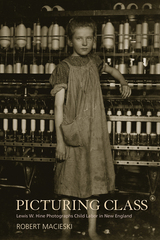 Picturing Class: Lewis W. Hine Photographs Child Labor in New England
Robert Macieski
University of Massachusetts Press, 2015 In this richly illustrated book, Robert Macieski examines Lewis W. Hine’s art and advocacy on behalf of child laborers as part of the National Child Labor Committee (NCLC) between 1909 and 1917. A “social photographer”—as he called himself—Hine created images that documented children at work throughout New England, revealing their exploitation in the North as he had for rural working children in the South. Hine staged his images, highlighting particular types of labor in specific places: the “newsies” in Connecticut cities; sardine canners in Eastport, Maine; cranberry pickers in Cape Cod bogs; industrial homeworkers in Boston and Providence; and cotton textile workers throughout the region. His association with the NCLC connected him to a network of local and national reformers, social workers, and child welfare professionals, a broad coalition he supported in their fight to end this unethical labor practice. Macieski also chronicles Hine’s efforts to mount major exhibitions that would help move public opinion against child labor. In Picturing Class, Macieski explores the historical context of Hine’s photographs and the social worlds of his subjects. He offers a detailed analysis of many of the images, unearthing the stories behind the creation of these photographs and the lives of their subjects. In telling the story of these photographs, their creation, and their reception, Macieski demonstrates how Hine worked to advance an unvarnished picture of a rapidly changing region and the young workers at the center of this important shift.
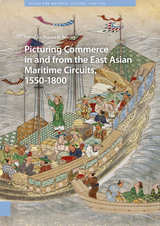 Picturing Commerce in and from the East Asian Maritime Circuits, 1550-1800
Edited by Tamara H. Bentley
Amsterdam University Press, 2019 Combining strikingly new scholarship by art historians, historians, and ethnomusicologists, this interdisciplinary volume illuminates trade ties within East Asia, and from East Asia outwards, in the years 1550 to 1800. While not encyclopedic, the selected topics greatly advance our sense of this trade picture. Throughout the book, multi-part trade structures are excavated; the presence of European powers within the Asian trade nexus features as part of this narrative. Visual goods are highlighted, including lacquerwares, paintings, prints, musical instruments, textiles, ivory sculptures, unfired ceramic portrait figurines, and Chinese, Japanese, Korean, and Southeast Asian ceramic vessels. These essays underscore the significance of Asian industries producing multiples, and the rhetorical charge of these goods, shifting in meaning as they move. Everyday commodities are treated as well; for example, the trans-Pacific trade in contraband mercury, used in silver refinement, is spelled out in detail. Building reverberations between merchant networks, trade goods, and the look of the objects themselves, this richly-illustrated book brings to light the Asian trade engine powering the early modern visual cultures of East and Southeast Asia, the American colonies, and Europe.
 Picturing Culture: Explorations of Film and Anthropology
Jay Ruby
University of Chicago Press, 2000 Here, Jay Ruby—a founder of visual anthropology—distills his thirty-year exploration of the relationship of film and anthropology. Spurred by a conviction that the ideal of an anthropological cinema has not even remotely begun to be realized, Ruby argues that ethnographic filmmakers should generate a set of critical standards analogous to those for written ethnographies. Cinematic artistry and the desire to entertain, he argues, can eclipse the original intention, which is to provide an anthropological representation of the subjects.
The book begins with analyses of key filmmakers (Robert Flaherty, Robert Garner, and Tim Asch) who have striven to generate profound statements about human behavior on film. Ruby then discusses the idea of research film, Eric Michaels and indigenous media, the ethics of representation, the nature of ethnography, anthropological knowledge, and film and lays the groundwork for a critical approach to the field that borrows selectively from film, communication, media, and cultural studies. Witty and original, yet intensely theoretical, this collection is a major contribution to the field of visual anthropology.
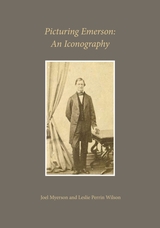 Picturing Emerson: An Iconography
Joel Myerson and Leslie Perrin Wilson
Harvard University Press Picturing Emerson reproduces and explores the background of all known images of Ralph Waldo Emerson created from life, including drawings, paintings, silhouettes, sculptures, and photographs. The book provides dates for these images; information about their makers and Emerson’s sittings; as well as commentary by family members and contemporaries. The resulting work makes it possible for the first time to trace Emerson’s visage over seven decades.
Dating and correctly identifying images of Emerson has long challenged scholars, collectors, and the general public. By examining over fifty years of archival and published research—including web resources, library catalogs, and correspondence with international collections—the authors have been able to locate nearly 140 images dating from 1829 to immediately before Emerson’s death in 1882.
Joel Myerson has written or edited over sixty books on Emerson and the Transcendentalists, most recently Ralph Waldo Emerson: The Major Prose with Ronald A. Bosco. They have jointly received the Julian P. Boyd Award, the highest award presented by the Association for Documentary Editing. Leslie Perrin Wilson is a curator at the Concord Free Public Library, a repository known for significant holdings of Emerson portraiture. She has written extensively on local historical and literary topics.
 Picturing Empire: Photography and the Visualization of the British Empire
James R. Ryan
University of Chicago Press, 1997 Coinciding with the extraordinary expansion of Britain's overseas empire under Queen Victoria, the invention of photography allowed millions to see what they thought were realistic and unbiased pictures of distant peoples and places. This supposed accuracy also helped to legitimate Victorian geography's illuminations of the "darkest" recesses of the globe with the "light" of scientific mapping techniques.
But as James R. Ryan argues in Picturing Empire, Victorian photographs reveal as much about the imaginative landscapes of imperial culture as they do about the "real" subjects captured within their frames. Ryan considers the role of photography in the exploration and domestication of foreign landscapes, in imperial warfare, in the survey and classification of "racial types," in "hunting with the camera," and in teaching imperial geography to British schoolchildren.
Ryan's careful exposure of the reciprocal relation between photographic image and imperial imagination will interest all those concerned with the cultural history of the British Empire.
 Picturing German Antiquity in the Age of Print: Art, Archaeology, and the Style All’Antica in Early Modern Augsburg
Rachel Carlisle
Amsterdam University Press, 2025 Picturing German Antiquity in the Age of Print: Art, Archaeology, and the Style All’antica in Early Modern Augsburg examines the central role of print to local antiquarian pursuits and generation of a style all’antica in early sixteenth-century Augsburg, Germany. Working in the shadow of Holy Roman Emperor Maximilian I, Augsburg’s leading patrons, including humanist Konrad Peutinger and the mercantile Fugger family, documented local antiquities and commissioned new works of classicizing art and architecture, visually asserting a genuine, unbroken lineage to the city’s past.
This study challenges earlier narratives by arguing that Augsburg’s artists and printers did not directly copy Italian Renaissance models but instead manipulated the imported visual vocabulary according to local concerns. The book brings together scholarly discourses on transalpine exchange, scientific advancements in printmaking, and reception of antiquity north of the Alps to offer a new understanding of art in early modern Augsburg and northern Europe at large.
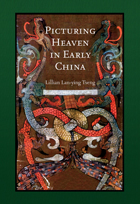 Picturing Heaven in Early China
Lillian Lan-ying Tseng
Harvard University Press, 2011 Tian, or Heaven, had multiple meanings in early China. It had been used since the Western Zhou to indicate both the sky and the highest god, and later came to be regarded as a force driving the movement of the cosmos and as a home to deities and imaginary animals. By the Han dynasty, which saw an outpouring of visual materials depicting Heaven, the concept of Heaven encompassed an immortal realm to which humans could ascend after death.
Using excavated materials, Lillian Tseng shows how Han artisans transformed various notions of Heaven—as the mandate, the fantasy, and the sky—into pictorial entities. The Han Heaven was not indicated by what the artisans looked at, but rather was suggested by what they looked into. Artisans attained the visibility of Heaven by appropriating and modifying related knowledge of cosmology, mythology, astronomy. Thus the depiction of Heaven in Han China reflected an interface of image and knowledge.
By examining Heaven as depicted in ritual buildings, on household utensils, and in the embellishments of funerary settings, Tseng maintains that visibility can hold up a mirror to visuality; Heaven was culturally constructed and should be culturally reconstructed.
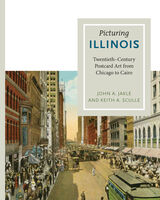 Picturing Illinois: Twentieth-Century Postcard Art from Chicago to Cairo
John A. Jakle and Keith A. Sculle
University of Illinois Press, 2012 The American picture postcard debuted around the start of the twentieth century, creating an enthusiasm for sending and collecting postcard art that continued for decades. As a form of popular culture, scenic postcards strongly influenced how Americans conceptualized both faraway and nearby places through portrayals of landscapes, buildings, and historic sites. In this gloriously illustrated history of the picture postcard in Illinois, John A. Jakle and Keith A. Sculle study a rich and diverse set of images that chronicle what Illinoisans considered attractive, intriguing, and memorable. They also discuss how messages written on postcards reveal the sender's personal interpretation of local geography and scenery. The most popularly depicted destination was Chicago, America's great boomtown.Its portraits are especially varied, showing off its high-rise architecture, its teeming avenues, and the vitality of its marketplaces and even slaughterhouses. Postcards featuring downstate locales, however, elaborated and reinforced stereotypes that divided the state, portraying the rest of Illinois as the counterpoint to Chicago's urban bustle. Scores of cards from Springfield, Peoria, Bloomington-Normal, Urbana-Champaign, Quincy, and Vandalia emphasize wide-open prairies, modest civic edifices, and folksy charm. The sense of dichotomy between Chicago and the rest of Illinois was, of course, a substantial fallacy, since the city's very prosperity depended upon the entire state's fertile farmlands, natural resources, and small industries. Jakle and Sculle follow this dialogue between urban Chicago and rural downstate as it is illustrated on two hundred vintage postcards, observing both their common conventions and their variety. They also discuss the advances in printing technology in the early 1900s that made mass appeal possible. Providing rich historical and geographical context, Picturing Illinois: Twentieth-Century Postcard Art from Chicago to Cairo illustrates the picture postcard's significance in American popular culture and the unique ways in which Illinoisans pictured their world.
Picturing Immigration: Photojournalistic Representation of Immigrants in Greek and Spanish Press
Athanasia Batziou
Intellect Books, 2011 In recent years Greece and Spain have seen an influx of immigrants from nearby developing nations. And as their foreign populations grew, both countries' national medias documented the change and, in the process, shaped perceptions of the immigrant groups by their new countries and the world. Picturing Immigration offers a comparative study of the photojournalistic framing of immigrants in these two southern European nations. Going beyond traditional media analysis, it focuses on images rather than text to explore a host of hot topics, including media representation of minorities, immigration, and stereotypes.
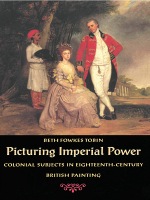 Picturing Imperial Power: Colonial Subjects in Eighteenth-Century British Painting
Beth Fowkes Tobin
Duke University Press, 1999 This study of colonialism and art examines the intersection of visual culture and political power in late-eighteenth-century British painting. Focusing on paintings from British America, the West Indies, and India, Beth Fowkes Tobin investigates the role of art in creating and maintaining imperial ideologies and practices—as well as in resisting and complicating them.
Informed by the varied perspectives of postcolonial theory, Tobin explores through close readings of colonial artwork the dynamic middle ground in which cultures meet. Linking specific colonial sites with larger patterns of imperial practice and policy, she examines paintings by William Hogarth, Benjamin West, Gilbert Stuart, Arthur William Devis, and Agostino Brunias, among others. These works include portraits of colonial officials, conversation pieces of British families and their servants, portraits of Native Americans and Anglo-Indians, and botanical illustrations produced by Calcutta artists for officials of the British Botanic Gardens. In addition to examining the strategies that colonizers employed to dominate and define their subjects, Tobin uncovers the tactics of negotiation, accommodation, and resistance that make up the colonized’s response to imperial authority. By focusing on the paintings’ cultural and political engagement with imperialism, she accounts for their ideological power and visual effect while arguing for their significance as agents in the colonial project.
Pointing to the complexity, variety, and contradiction within colonial art, Picturing Imperial Power contributes to an understanding of colonialism as a collection of social, economic, political, and epistemological practices that were not monolithic and inevitable, but contradictory and contingent on various historical forces. It will interest students and scholars of colonialism, imperial history, postcolonial history, art history and theory, and cultural studies.
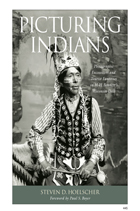 Picturing Indians: Photographic Encounters and Tourist Fantasies in H. H. Bennett's Wisconsin Dells
Steven D. Hoelscher
University of Wisconsin Press, 2008 Today a tourist mecca, the area now known as the Wisconsin Dells was once wilderness—and a gathering place for the region’s Native peoples, the Ho-Chunk, who for centuries migrated to this part of the Wisconsin River for both sustenance and spiritual renewal. By the late 1800s their numbers had dwindled through displacement or forcible removal, and it was this smaller band that caught the attention of photographer Henry Hamilton Bennett. Having built his reputation on his photographs of the Dells’ steep gorges and fantastic rock formations, H. H. Bennett now turned his camera upon the Ho-Chunk themselves, and thus began the many-layered relationship unfolded by Steven D. Hoelscher in Picturing Indians: Photographic Encounters and Tourist Fantasies in H. H. Bennett’s Wisconsin Dells. The interactions between Indian and white man, photographer and photographed, suggested a relationship in which commercial motives and friendly feelings mixed, though not necessarily in equal measure. The Ho-Chunk resourcefully sought new ways to survive in the increasingly tourist-driven economy of the Dells. Bennett, struggling to keep his photography business alive, capitalized on America’s comfortably nostalgic image of Native peoples as a vanishing race, no longer threatening and now safe for white consumption. Hoelscher traces these developments through letters, diaries, financial records, guidebooks, and periodicals of the day. He places Bennett within the context of contemporary artists and photographers of American Indians and examines the receptions of this legacy by the Ho-Chunk today. In the final chapter, he juxtaposes Bennett’s depictions of Native Americans with the work of present-day Ho-Chunk photographer Tom Jones, who documents the lives of his own people with a subtlety and depth foreshadowed, a century ago, in the flickers of irony, injury, humor, and pride conveyed by his Ho-Chunk ancestors as they posed before the lens of a white photographer.
Winner, Book Award of Merit, Wisconsin Historical Society, Best Books for General Audiences, selected by the American Association of School Librarians, and Best Books for Regional Interests, selected by the Public Library Association
 Picturing Landscape in an Age of Extraction: Europe and Its Colonial Networks, 1780–1850
Stephanie O'Rourke
University of Chicago Press, 2025 O’Rourke argues that artistic representations played a pivotal role in shaping how people thought about the natural world during the Industrial Revolution.
In the late eighteenth and early nineteenth centuries, European artists confronted the emergence of a new way of thinking about and treating the Earth and its resources. Centered on extraction, this new paradigm was characterized by large-scale efforts to transform and monetize the physical environment across the globe. With this book, Stephanie O’Rourke considers such practices, looking at what was at stake in visual representations of the natural world during the first decades of Europe’s industrial revolutions.
O’Rourke argues that key developments in the European landscape painting tradition were profoundly shaped by industries including mining and timber harvesting, as well as by interlinked ideas about race, climate, and waste. Focusing on developments in Britain, France, Germany, and across Europe’s colonial networks, she explores how artworks and technical illustrations portrayed landscapes in ways that promoted—or pushed against—the logic of resource extraction.
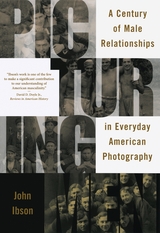 Picturing Men: A Century of Male Relationships in Everyday American Photography
John Ibson
University of Chicago Press, 2006 There was a time in America when two men pictured with their arms wrapped around each other, or perhaps holding hands, weren’t necessarily seen as sexually involved—a time when such gestures could be seen simply as those of intimate friendship rather than homoeroticism.
Such is the time John Ibson evokes in Picturing Men, a striking visual record of changes in attitudes about relationships between gentlemen, soldiers, cowboys, students, lumberjacks, sailors, and practical jokers. Spanning from 1850 to 1950, the 142 everyday photographs that richly illustrate Picturing Men radiate playfulness, humor, and warmth. They portray a lost world for American men: a time when their relationships with each other were more intimate than they commonly are today, regardless of sexual orientation. Picturing Men starkly contrasts the calm affection displayed in earlier photographs with the absence of intimacy in photos from the mid-1950s on. In doing so, this lively, accessible book makes a significant contribution to American history and cultural studies, gender studies, and the history of photography.
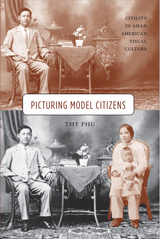 Picturing Model Citizens: Civility in Asian American Visual Culture
Thy Phu
Temple University Press, 2012 At the heart of the model minority myth—often associated with Asian Americans—is the concept of civility. In this groundbreaking book, Picturing Model Citizens, Thy Phu exposes the complex links between civility and citizenship, and argues that civility plays a crucial role in constructing Asian American citizenship.
Featuring works by Arnold Genthe, Carl Iwasaki, Toyo Miyatake, Nick Ut, and others, Picturing Model Citizens traces the trope of civility from the nineteenth to the twenty-first centuries. Through an examination of photographs of Chinese immigrants, Japanese internment camps, the Hiroshima Maidens project, napalm victims, and the SARS epidemic, Phu explores civility's unexpected appearance in images that draw on discourses of intimacy, cultivation, apology, and hygiene. She reveals how Asian American visual culture illustrates not only cultural ideas of civility, but also contests the contradictions of state-defined citizenship.
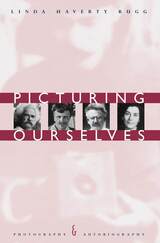 Picturing Ourselves: Photography and Autobiography
Linda Haverty Rugg
University of Chicago Press, 1997 Photography has transformed the way we picture ourselves. Although photographs seem to "prove" our existence at a given point in time, they also demonstrate the impossibility of framing our multiple and fragmented selves. As Linda Haverty Rugg convincingly shows, photography's double take on self-image mirrors the concerns of autobiographers, who see the self as simultaneously divided (in observing/being) and unified by the autobiographical act.
Rugg tracks photography's impact on the formation of self-image through the study of four literary autobiographers concerned with the transformative power of photography. Obsessed with self-image, Mark Twain and August Strindberg both attempted (unsuccessfully) to integrate photographs into their autobiographies. While Twain encouraged photographers, he was wary of fakery and kept a fierce watch on the distribution of his photographic image. Strindberg, believing that photographs had occult power, preferred to photograph himself.
Because of their experiences under National Socialism, Walter Benjamin and Christa Wolf feared the dangerously objectifying power of photographs and omitted them from their autobiographical writings. Yet Benjamin used them in his photographic conception of history, which had its testing ground in his often-ignored Berliner Kindheit um 1900. And Christa Wolf's narrator in Patterns of Childhood attempts to reclaim her childhood from the Nazis by reconstructing mental images of lost family photographs.
Confronted with multiple and conflicting images of themselves, all four of these writers are torn between the knowledge that texts, photographs, and indeed selves are haunted by undecidability and the desire for the returned glance of a single self.
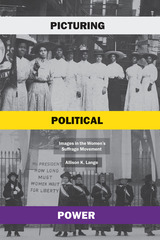 Picturing Political Power: Images in the Women’s Suffrage Movement
Allison K. Lange
University of Chicago Press, 2020 Lange's examination of the fights that led to the ratification of the Nineteenth Amendment in 1920 reveals the power of images to change history.
For as long as women have battled for equitable political representation in America, those battles have been defined by images—whether illustrations, engravings, photographs, or colorful chromolithograph posters. Some of these pictures have been flattering, many have been condescending, and others downright incendiary. They have drawn upon prevailing cultural ideas of women’s perceived roles and abilities and often have been circulated with pointedly political objectives.
Picturing Political Power offers perhaps the most comprehensive analysis yet of the connection between images, gender, and power. In this examination of the fights that led to the ratification of the Nineteenth Amendment in 1920, Allison K. Lange explores how suffragists pioneered one of the first extensive visual campaigns in modern American history. She shows how pictures, from early engravings and photographs to colorful posters, proved central to suffragists’ efforts to change expectations for women, fighting back against the accepted norms of their times. In seeking to transform notions of womanhood and win the right to vote, white suffragists emphasized the compatibility of voting and motherhood, while Sojourner Truth and other leading suffragists of color employed pictures to secure respect and authority. Picturing Political Power demonstrates the centrality of visual politics to American women’s campaigns throughout the nineteenth and early twentieth centuries, revealing the power of images to change history.
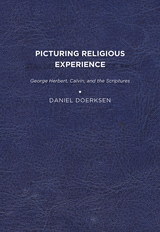 Picturing Religious Experience: George Herbert, Calvin, and the Scriptures
Daniel Doerksen
University of Delaware Press, 2012 Little has been said about the relationship of Herbert’s writings to those of John Calvin, yet the latter were abundant and influential in Herbert’s Church of England. Accordingly Picturing Religious Experience studies Herbert’s poetry in relation to those writings, particularly regarding “spiritual conflicts,” which the poet himself said would be found depicted in his book of poems. Much more than is generally realized, Calvin wrote about the experience of living the Christian life—which is also Herbert’s subject in many of his poems. Altogether, this study maintains that Herbert owes to his religious orientation not just themes or details, but an impulse to observe and depict the inner life, and scriptural patterns which significantly contribute to the substance and literary excellence of The Temple.
Published by University of Delaware Press. Distributed worldwide by Rutgers University Press.
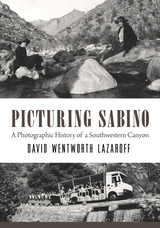 Picturing Sabino: A Photographic History of a Southwestern Canyon
David Wentworth Lazaroff
University of Arizona Press, 2023 Sabino Canyon, a desert canyon in the American Southwest near Tucson, Arizona, is enjoyed yearly by thousands of city residents as well as visitors from around the world. Picturing Sabino tells the story of the canyon’s transformation from a barely known oasis, miles from a small nineteenth-century town, into an immensely popular recreation area on the edge of a modern metropolis. Covering a century of change, from 1885 to 1985, this work rejoices in the canyon’s natural beauty and also relates the ups and downs of its protection and enjoyment.
The story is vividly told through numerous historical photographs, lively anecdotes, and an engaging text, informed by decades of research by David Wentworth Lazaroff. Along the way the reader makes the acquaintance of ordinary picnickers as well as influential citizens who helped to reshape the canyon, while witnessing the canyon’s evolving relationship with its growing urban neighbor. The book will fascinate readers who are already familiar with Sabino Canyon, as well as anyone with an interest in local or regional history, or in historical photography.
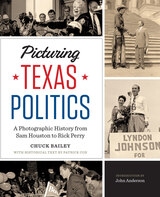 Picturing Texas Politics: A Photographic History from Sam Houston to Rick Perry
By Chuck Bailey; with historical text by Patrick Cox; introduction by John Anderson
University of Texas Press, 2015 With rare, previously unpublished photographs and iconic images of politicians from the state’s founders to Ann Richards, George W. Bush, and Rick Perry, here is the first-ever photographic album of Texas politicians and political campaigns. The Republic of Texas was founded in 1839, around the time that photography was being invented. So while there were no photographers at the Alamo or San Jacinto, they arrived soon after to immortalize, on film, Sam Houston, David Burnett, Mirabeau Lamar, and many other founding fathers of the Lone Star State. Over the following nearly two centuries, Texas politics and politicians have provided reliable, often dramatic, and sometimes larger-than-life subjects for photographers to capture in the moment and add to the historical record. Picturing Texas Politics presents the first photographic album of Texas politicians and political campaigns ever assembled. Chuck Bailey has searched archives, museums, libraries, and private collections to find photographs that have never been published, as well as iconic images, such as Russell Lee’s pictures of one of Ralph Yarborough’s campaigns. These photographs are arranged into four chronological sections, each one introduced by historian Patrick Cox, who also provides informative photo captions. The photographs display power and political savvy from the early Republic to Lyndon Johnson and Bob Bullock; unmatched dedication to Texas in the Hobby and Bush families; and the growing influence of women in politics, from Miriam “Ma” Ferguson to Barbara Jordan, Ann Richards, and Kay Bailey Hutchison. With Sam Houston’s jaguar vest, W. Lee “Pappy” O’Daniel’s hillbilly band, a famous governor with an ostrich, and prominent Texans eating watermelons, shooting guns, and riding horses, this is Texas politics at its liveliest and best.
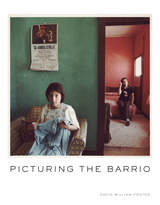 Picturing the Barrio: Ten Chicano Photographers
David William Foster
University of Pittsburgh Press, 2017 Mexican-American life, like that of nearly every contemporary community, has been extensively photographed. Yet there is surprisingly little scholarship on Chicano photography. Picturing the Barrio presents the first book-length examination on the topic. David William Foster analyzes the imagery of ten distinctive artists who offer a range of approaches to portraying Chicano life. The production of each artist is examined as an ideological interpretation of how Chicano experience is constructed and interpreted through the medium of photography, in sites ranging from the traditional barrio to large metropolitan societies. These photographers present artistic as well as documentary images of the socially invisible. They and their subjects grapple with definitions of identity, as well as ethnicity and gender. As such, this study deepens our understanding of the many interpretations of the “Chicano experience.”
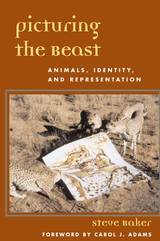 Picturing the Beast: Animals, Identity, and Representation
Steve Baker
University of Illinois Press, 1993 From Mickey Mouse to the teddy bear, from the Republican elephant to the use of "jackass" as an all-purpose insult, images of animals play a central role in politics, entertainment, and social interactions. In this penetrating look at how Western culture pictures the beast, Steve Baker examines how such images--sometimes affectionate, sometimes derogatory, always distorting--affect how real animals are perceived and treated.
Baker provides an animated discussion of how animals enter into the iconography of power through wartime depictions of the enemy, political cartoons, and sports symbolism. He examines a phenomenon he calls the "disnification" of animals, meaning a reduction of the animal to the trivial and stupid, and shows how books featuring talking animals underscore human superiority. He also discusses how his findings might inform the strategies of animal rights advocates seeking to call public attention to animal suffering and abuse. Until animals are extricated from the baggage of imposed images, Baker maintains, neither they nor their predicaments can be clearly seen.
For this edition, Baker provides a new introduction, specifically addressing an American audience, that touches on such topics as the Cow Parade, animal imagery in the presidential race, and animatronic animals in recent films.
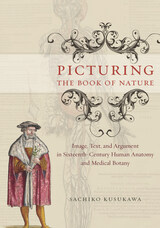 Picturing the Book of Nature: Image, Text, and Argument in Sixteenth-Century Human Anatomy and Medical Botany
Sachiko Kusukawa
University of Chicago Press, 2012 Because of their spectacular, naturalistic pictures of plants and the human body, Leonhart Fuchs’s De historia stirpium and Andreas Vesalius’s De humani corporis fabrica are landmark publications in the history of the printed book. But as Picturing the Book of Nature makes clear, they do more than bear witness to the development of book publishing during the Renaissance and to the prominence attained by the fields of medical botany and anatomy in European medicine. Sachiko Kusukawa examines these texts, as well as Conrad Gessner’s unpublished Historia plantarum, and demonstrates how their illustrations were integral to the emergence of a new type of argument during this period—a visual argument for the scientific study of nature. To set the stage, Kusukawa begins with a survey of the technical, financial, artistic, and political conditions that governed the production of printed books during the Renaissance. It was during the first half of the sixteenth century that learned authors began using images in their research and writing, but because the technology was so new, there was a great deal of variety of thought—and often disagreement—about exactly what images could do: how they should be used, what degree of authority should be attributed to them, which graphic elements were bearers of that authority, and what sorts of truths images could and did encode. Kusukawa investigates the works of Fuchs, Gessner, and Vesalius in light of these debates, scrutinizing the scientists’ treatment of illustrations and tracing their motivation for including them in their works. What results is a fascinating and original study of the visual dimension of scientific knowledge in the sixteenth century.
 Picturing the Cosmos: A Visual History of Early Soviet Space Endeavor
Iina Kohonen
Intellect Books, 2017 Space is the ultimate canvas for the imagination, and in the 1950s and ’60s, as part of the space race with the United States, the solar system was the blank page upon which the Soviet Union etched a narrative of exploration and conquest. In Picturing the Cosmos, drawing on a comprehensive corpus of rarely seen photographs and other visual phenomena, Iina Kohonen maps the complex relationship between visual propaganda and censorship during the Cold War.
Kohonen ably examines each image, elucidating how visual media helped to anchor otherwise abstract political and intellectual concepts of the future and modernization within the Soviet Union. The USSR mapped and named the cosmos, using new media to stake a claim to this new territory and incorporating it into the daily lives of its citizens. Soviet cosmonauts, meanwhile, were depicted as prototypes of the perfect Communist man, representing modernity, good taste, and the aesthetics of the everyday. Across five heavily illustrated chapters, Picturing the Cosmos navigates and critically examines these utopian narratives, highlighting the rhetorical tension between propaganda, censorship, art, and politics.
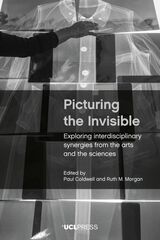 Picturing the Invisible: Exploring Interdisciplinary Synergies from the Arts and the Sciences
Edited by Paul Coldwell and Ruth M. Morgan
University College London, 2022 An interdisciplinary approach to invisibility through the lens of the arts and sciences.
Picturing the Invisible presents different disciplinary approaches to articulating the invisible, that which is not known or not provable. The challenge is how to articulate these concepts, not only to those within a particular academic field but beyond, to other disciplines and society at large. As our understanding of the complexity of the world grows incrementally, so does our realization that issues and problems can rarely be resolved within neat demarcations. Therefore, the authors argue, the importance of finding means of communicating across disciplines and fields must become a priority. This book brings together insights from leading academics from a wide range of disciplines, including art and design, curatorial practice, literature, forensic science, medical science, psychoanalysis and psychotherapy, philosophy, astrophysics, and architecture, who share an interest in exploring how in each discipline we strive to find expression for the invisible or unknown and to draw out and articulate some of the explicit and tacit ways of communicating those concepts that transcend traditional disciplinary boundaries.
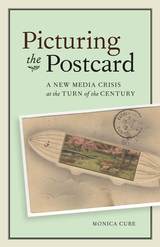 Picturing the Postcard: A New Media Crisis at the Turn of the Century
Monica Cure
University of Minnesota Press, 2018 The first full-length study of a once revolutionary visual and linguistic medium
Literature has “died” many times—this book tells the story of its death by postcard. Picturing the Postcard looks to this unlikely source to shed light on our collective, modern-day obsession with new media. The postcard, almost unimaginably now, produced at the end of the nineteenth century the same anxieties and hopes that many people think are unique to twenty-first-century social media such as Facebook or Twitter. It promised a newly connected social world accessible to all and threatened the breakdown of authentic social relations and even of language. Arguing that “new media” is as much a discursive object as a material one, and that it is always in dialogue with the media that came before it, Monica Cure reconstructs the postcard’s history through journals, legal documents, and sources from popular culture, analyzing the postcard’s representation in fiction by well-known writers such as E. M. Forster and Edith Wharton and by more obscure writers like Anne Sedgwick and Herbert Flowerdew. Writers deployed uproar over the new medium of the postcard by Anglo-American cultural critics to mirror anxieties about the changing nature of the literary marketplace, which included the new role of women in public life, the appeal of celebrity and the loss of privacy, an increasing dependence on new technologies, and the rise of mass media. Literature kept open the postcard’s possibilities and in the process reimagined what literature could be.
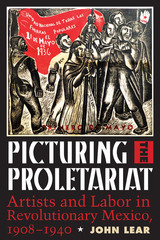 Picturing the Proletariat: Artists and Labor in Revolutionary Mexico, 1908–1940
By John Lear
University of Texas Press, 2017 Thomas McGann Memorial Prize, Rocky Mountain Council on Latin American Studies, 2017
Runner-up, Humanities Book Prize, Mexico Section of the Latin American Studies Association, 2018 In the wake of Mexico’s revolution, artists played a fundamental role in constructing a national identity centered on working people and were hailed for their contributions to modern art. Picturing the Proletariat examines three aspects of this artistic legacy: the parallel paths of organized labor and artists’ collectives, the relations among these groups and the state, and visual narratives of the worker. Showcasing forgotten works and neglected media, John Lear explores how artists and labor unions participated in a cycle of revolutionary transformation from 1908 through the presidency of Lázaro Cárdenas (1934–1940). Lear shows how middle-class artists, radicalized by the revolution and the Communist Party, fortified the legacy of the prerevolutionary print artisan José Guadalupe Posada by incorporating modernist, avant-garde, and nationalist elements in ways that supported and challenged unions and the state. By 1940, the state undermined the autonomy of radical artists and unions, while preserving the image of both as partners of the “institutionalized revolution.” This interdisciplinary book explores the gendered representations of workers; the interplay of prints, photographs, and murals in journals, in posters, and on walls; the role of labor leaders; and the discursive impact of the Spanish Civil War. It considers “los tres grandes”—Rivera, Siquieros, and Orozco—while featuring lesser-known artists and their collectives, including Saturnino Herrán, Leopoldo Méndez, Santos Balmori, and the League of Revolutionary Writers and Artists (LEAR). The result is a new perspective on the art and politics of the revolution.
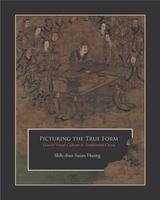 Picturing the True Form: Daoist Visual Culture in Traditional China
Shih-shan Susan Huang
Harvard University Press, 2012 Picturing the True Form investigates the long-neglected visual culture of Daoism, China’s primary indigenous religion, from the tenth through thirteenth centuries with references to both earlier and later times. In this richly illustrated book, Shih-Shan Susan Huang provides a comprehensive mapping of Daoist images in various media, including Dunhuang manuscripts, funerary artifacts, and paintings, as well as other charts, illustrations, and talismans preserved in the fifteenth-century Daoist Canon. True form (zhenxing), the key concept behind Daoist visuality, is not static, but entails an active journey of seeing underlying and secret phenomena.
This book’s structure mirrors the two-part Daoist journey from inner to outer. Part I focuses on inner images associated with meditation and visualization practices for self-cultivation and longevity. Part II investigates the visual and material dimensions of Daoist ritual. Interwoven through these discussions is the idea that the inner and outer mirror each other and the boundary demarcating the two is fluid. Huang also reveals three central modes of Daoist symbolism—aniconic, immaterial, and ephemeral—and shows how Daoist image-making goes beyond the traditional dichotomy of text and image to incorporate writings in image design. It is these particular features that distinguish Daoist visual culture from its Buddhist counterpart.
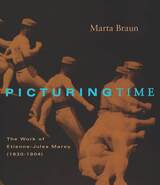 Picturing Time: The Work of Etienne-Jules Marey (1830-1904)
Marta Braun
University of Chicago Press, 1992 Etienne-Jules Marey was an inventor whose methods of recording movement revolutionized our way of visualizing time and motion. Best remembered for his chronophotography, Marey constructed a single-camera system that led the way to cinematography. Picturing Time, the first complete survey of Marey's work, investigates the far reaching effects of Marey's inventions on stream-of-consciousness literature, psychoanalysis, Bergsonian philosophy, and the art of cubists and futurists.
Braun offers a fascinating look at how Marey's chronophotography was used to express the profound transformation in understanding and experiencing time that occurred in the late nineteenth century. Featuring 335 illustrations, Picturing Time includes many unpublished examples of Marey's chronophotographs and cinematic work. It also contains a complete bibliography of his writings and the first catalog of his films, photographic prints, and recently discovered negatives.
 Picturing Utopia: Bertha Shambaugh and the Amana Photographers
Abigail Foerstner
University of Iowa Press, 2005 More than a hundred years ago, Bertha Shambaugh set out to photograph the Amana Colonies, the utopian religious community twenty miles northwest of Iowa City. Following her example, several Amana members ignored their community's prohibition against photography and took up cameras to record the people and events around them. Picturing Utopia celebrates their artistic vision and offers a rare glimpse into a 19th-century religious utopia, providing an unbroken photographic record beginning with Shambaugh's work in the 1890s and continuing through the Colonies' transition to mainstream American life with the Great Change in 1932.Abigail Foerstner, whose great uncle was one of the Amana photographers included in this book, brings together this stunning collection of photographs along with the stories of the photographers who took them. Together the pictures and text fill in an untold chapter in American photographic history and provide an insider's view of life in Amana.
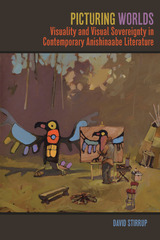 Picturing Worlds: Visuality and Visual Sovereignty in Contemporary Anishinaabe Literature
David Stirrup
Michigan State University Press, 2020 Paying attention to the uses that Anishinaabe authors make of visual images and marks made on surfaces such as rock, bark, paper, and canvas, David Stirrup argues that such marks—whether ancient pictographs or contemporary paintings—intervene in artificial divisions like that separating precolonial/oral from postcontact/alphabetically literate societies. Examining the ways that writers including George Copway, Jane Johnston Schoolcraft, Gordon Henry, Louise Erdrich, Gerald Vizenor, and others deploy the visual establishes frameworks for continuity, resistance, and sovereignty in that space where conventional narratives of settlement read rupture. This book is a significant contribution to studies of the ways traditional forms of inscription support and amplify the oral tradition and in turn how both the method and aesthetic of inscription contribute to contemporary literary aesthetics and the politics of representation.
Pidgins and Creoles: Current Trends and Prospects
David DeCamp and Ian F. Hancock, Editors
Georgetown University Press A collection of work on pidgins and creoles that includes discussions of the English-derived creole of San Andres Island and the French-derived creole of Cayenne, the theoretical contributions of creolistics to general linguistic theory, decreolization, generative phonological treatment of a hypothesized English-derived proto-creole, and the little-known Shelta language.
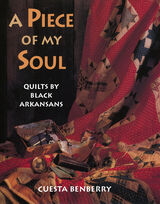 A Piece of My Soul: Quilts by Black Arkansans
Cuesta Benberry
University of Arkansas Press, 2000 Arkansas is well known for its rich tradition of upland folk arts. Little, however, has been reported from the lowland areas, particulary on African American contributions to the state's cultural heritage. A Piece of My Soul: Quilts by Black Arkansans seeks to rectify that oversight by drawing attention to the extensive, important collection of African American quilts in the Old State House Museum in Little Rock. Over seventy-five individual pieces of patchwork art are presented in this publication in full-color plates, each with a commentary by the exhibit's guest curator, Cuesta Benberry. The book details the importance of quilting to black Arkansans; the quilts' uses, materials and construction; and what each piece says about the artist and her beliefs. We are granted a glimpse into the living conditions and cultural mores of the quilters' lives. Regionalisms, such as the unusual custom of renaming traditional quilt patterns for things seen in the farmyard, such as Rooster Tail or Chicken Feet, and of piecing patchwork funerary cloths to decorate coffins are discussed. This impressive collection of cultural artifacts is placed in the larger context of the African American experience through an introduction by noted scholar Raymond Dobard (art history, Howard University), co-author, with Jacqueline Tobin, of the highly acclaimed book, Hidden in Plain View: The Secret Story of Quilts and the Underground Railroad (1999, Doubleday). All those interested in American folk art, the quilting craft, and black history will find this beautiful book fascinating and rewarding.
A Piece Of Work: Five Writers Discuss Their Revisions
Jay Woodruff
University of Iowa Press, 1993 Books on writing generally offer prescriptions and proscriptions about this "craft so hard to learn" instead of evidence. But in A Piece of Work Woodruff's incisive questions guide five writers—Tobias Wolff, Tess Gallagher, Robert Coles, Joyce Carol Oates, and Donald Hall—through specific examples that enable the reader to see how good writing becomes better. From the first draft through various revisions and finally to the printed version of a single piece of each author's work, Woodruff traces the full course of the revision process.
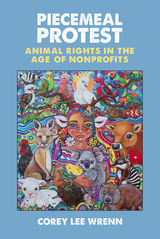 Piecemeal Protest: Animal Rights in the Age of Nonprofits
Corey Lee Wrenn
University of Michigan Press, 2019 Given their tendency to splinter over tactics and goals, social movements are rarely unified. Following the modern Western animal rights movement over thirty years, Corey Lee Wrennapplies the sociological theory of Bourdieu, Goffman, Weber, and contemporary social movement researchers to examine structural conditions in the animal rights movement, facilitating factionalism in today’s era of professionalized advocacy. Modern social movements are dominated by bureaucratically oriented nonprofits, a special arrangement that creates tension between activists and movement elites who compete for success in a corporate political arena. Piecemeal Protest examines the impact of nonprofitization on factionalism and a movement’s ability to mobilize, resonate, and succeed. Wrenn’sexhaustive analysis of archival movement literature and exclusive interviews with movement leaders illustrate how entities with greater symbolic capital are positioned to monopolize claims-making, disempower competitors, and replicate hegemonic power, eroding democratic access to dialogue and decision-making essential for movement health. Piecemeal Protest examines social movement behavior shaped by capitalist ideologies and state interests. As power concentrates to the disadvantage of marginalized factions in the modern social movement arena, Piecemeal Protest shines light on processes of factionalism and considers how, in the age of nonprofits, intra-movement inequality could stifle social progress.
 Pieces of Sound: German Experimental Radio
Daniel Gilfillan
University of Minnesota Press, 2009 A cultural history of German radio broadcasting from the 1920s to today Since the rise of film and television, radio has continued to evolve, with satellite radio and podcasts as its latest incarnations. Any understanding of the development of radio, like its visual counterparts, depends on closely examining the artistic ventures that preceded commercial acceptance. In Pieces of Sound, Daniel Gilfillan offers a cultural history that explores these major aspects of the medium by focusing on German radio broadcasting, providing a context that sees beyond programming to consider regulations, cultural politics, and social standardization. Gilfillan showcases the work of radio pioneers and artists over the past century, including Brecht’s work with the form, and how radio was employed before and after World War II. He traces how German radio broadcasters experimented with networked media not only to expand the artistic and communicative possibilities of radio, but also to inform perceptions about the advantages and direction of newer telecommunications media like Internet broadcasting and pirate radio, which artists are using today to engage with a medium that is increasingly under corporate control. Gilfillan astutely observes how claims made for the Internet today echo those made for radio in its infancy and puts forth a broad and incisive historical analysis of German cultural broadcasting.
The Pied Piper
Viktor Dyk
Karolinum Press, 2018 For The Pied Piper, Czech writer Viktor Dyk found his muse in the much retold medieval Saxon legend of the villainous, pipe-playing rat-catcher. Dyk uses the tale as a loose frame for his story of a mysterious wanderer, outcast, and would-be revolutionary—a dreamer typical of fin de siècle Czech literature who serves Dyk as a timely expression of the conflict between the petty concerns of bourgeois nineteenth-century society and the coming artistic generation. Impeccably rendered into English by Mark Corner, The Pied Piper retains the beautiful style of Dyk’s original Czech. The inspiration for several theatrical and film adaptations, including a noted animated work from critically acclaimed director Jiří Barta, Dyk’s classical novella is given new life by Corner’s translation, proving that the piper is open to new interpretations still.
 Piedmont Farmer: David Golightly Harris 1855-1870
Philip N. Racine
University of Tennessee Press, 1990
The journals of David Golightly Harris are a unique daily record of a fifteen-year span in the life of a Piedmont South Carolina farm family that owned ten slaves and cultivated one hundred acres. Documents from small slaveholders are few, making these journals an invaluable source of information about the agricultural routines of a small antebellum farm as well as a revealing commentary on regional and national affairs, slavery, education, religion, family relationships, and community life.
An especially compelling feature of this book is its inclusion of writings by Harris's wife, Emily, who took over the journal when he went to war for the Confederacy in 1862. Recounting the trials of managing the farm and raising seven children in her husband's absence, Emily's words offer poignant insights into the daily struggles of those who tended the home front during the Civil War.
"Piedmont Farmer is one of those rare books that deserves a place alongside The Cotton Kingdom, My Bondage and My Freedom, The Children of Pride, Mary Chesnut's Civil War, and the recent Freedom volumes as an indispensable source for historians of the nineteenth-century South."—David C. Rankin, The Journal of Southern History
"Harris's journals are important because they span the years before, during, and after the Civil War. . . . Philip N. Racine's annotations are extensive and extraordinarily rich in detail and insight. Enhanced with photographs, maps, and a comprehensive index, the Harris journals are not only a major contribution to southern history, but also they are a poignant view of agriculture and an explicit confirmation of slavery's burden."—David E. Schob, Illinois Historical Journal
The Editor: Philip N. Racine is Kenan Professor of History at Wofford College in Spartanburg, South Carolina. He edited "Unspoiled Heart": The Journal of Charles Mattocks of the 17th Maine in the Voices of the Civil War series published by the University of Tennessee Press.
 Piercing the Clouds: Lectio Divina and the Preparation for Ministry
Kevin Zilverberg
Saint Paul Seminary Press , 2021 This book’s six essays pertain to the “piercing of the clouds,” or the experience of heavenly mysteries, which characterizes lectio divina practiced well. Moreover, these peer-reviewed essays give special attention to the practice of lectio divina during preparation for ministry, especially the ministry of Catholic priests. That being said, any current or prospective Bible-reader may profit from this book; most of its content applies to Catholic seminarians and literate Christians alike.
Here follow brief descriptions of each chapter. Laurence Kriegshauser, OSB, begins the book with a chapter on the Western monastic tradition of lectio divina and seminary formation, including an historical survey of lectio divina, a description of its characteristics, and reflections on its practice in seminaries. Michael Magee reflects upon the implications of exegetical method for lectio divina, with a comparison and critique of three commentaries’ treatments of John 6. Konrad Schaefer, OSB, advocates for fostering growth and formation through lectio divina, beginning his chapter with a description of its theological underpinnings and then taking up some practical considerations for students. Marcin Kowalski focuses on meditatio of lectio divina following upon exegesis-informed lectio, with an examination of Romans 7:7–25 as a test case. Daniel Keating examines oratio and contemplatio (and actio) of lectio divina, giving attention to theologians from twelfth-century Carthusian Prior Guigo II to Pope Benedict XVI. Anthony Giambrone, OP, contributes the final essay, on searching the Scriptures and the mystery of preaching. For him, exquisitio (intellectual engagement) leads to supplicatio (prayerful supplication), which culminates in praedicatio (preaching).
Piero Della Francesca: The Flagellation
Marilyn Aronberg Lavin
University of Chicago Press, 1990 "Lavin's study of the Pierro della Francesca "Flagellation" at Urbino, as befits this exquisite masterpiece, is a model of lucid and precise exposition as well as being an exciting exercise of scholarship. Informed with the intellectual rigour of Scholastic exegesis, it deserves to be placed with the classic readings of fifteenth and sixteenth century works by Erwin Panofsky and Edgar Wind."—Spectator
"[Lavin] leaves the picture more wondrous than before, a simultaneous triumph of the theological and biographical, as well as pictorial, imagination."—Rackstraw Downes, New York Times Book Review
 Pierre Boulez
Dominique Jameux
Harvard University Press, 1990 This first thorough biography of the gifted Pierre Boulez interrelates four major aspects of his professional life: as composer, as conductor, as polemicist for new music, and as musico-political entrepreneur. Lively, intimate, and knowledgeable, it will fascinate concertgoers and students of contemporary music, and will be an especially valuable handbook for those who own recordings of the music. Dominique Jameux develops a comprehensive life history of Boulez, marking all the milestones. We observe the composer at study and at work: the relationship—personal and intellectual—between Boulez and Messiaen; the organization of the Domaine Musical concerts for performance of avant-garde music as well as the launching of IRCAM, an institute for experiments with new musical techniques; Boulez’s teaching experiences, particularly at Darmstadt and Harvard; his discussions with other composers; and his seasons as conductor of the New York Philharmonic, of the BBC Symphony, and of Wagner at Bayreuth.
Many major artistic names figure in this story—Messiaen, Cage, Stockhausen, Maderna, the conductor Rene Leibowitz, the actor Jean-Louis Barrault, as well as several great performers. In Part II, Jameux discusses in detail twelve representative compositions, ranging from the flute sonatina of 1946 to Répons. Throughout the preparation of this book, Jameux had the advantage of interviews with Boulez, along with many informal meetings; the result of the author’s direct contact with his subject is a lucid and reliable introduction to the music, ideas, and activities of one of the leading musical thinkers and doers of our day.
Pierre Bourdieu and Literary History, Volume 58
Marshall Brown
Duke University Press The recent publication in English of The Rules of Art has consolidated the work of the great French sociologist Pierre Bourdieu on literary history. In this special issue MLQ explores the development of Bourdieu’s thought, its philosophical and institutional implications, and a range of applications to the history of English literature. Essays included in this collection discuss the hesitant response of the American academy to Bourdieu; Bourdieu on Derrida on Kant; “pure poetry,” cultural capital, and the rejection of classicism; and the insight Bourdieu’s work lends to our understanding of the position of eighteenth-century women writers. Contributors. Marilyn Butler, John Guillory, Elizabeth W. Harries, Jonathan Joesberg, Toril Moi, William Paulson, Trevor Ross
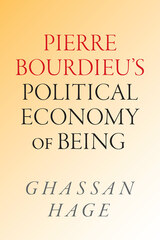 Pierre Bourdieu's Political Economy of Being
Ghassan Hage
Duke University Press, 2025 In Pierre Bourdieu’s Political Economy of Being, Ghassan Hage explores the great French social theorist’s work and revitalizes conventional and undertheorized aspects of his thinking. Hage focuses on Bourdieu’s concern with social being and what constitutes a worthwhile and fulfilling life. Such a life is not something that one either has or does not have; rather, society distributes and assigns values to ways of living. These values are structured by relations of power and domination and are subject to the outcome of political conflicts. Hage elucidates this political economy of being by reworking Bourdieu’s key concepts of habitus, illusio, symbolic capital, and field. In this political economy, people enjoy a worthwhile life to the degree that they are able to orient and deploy themselves practically in the world that surrounds them, have a sense of purpose, and achieve a level of social recognition. For Hage, the project of theorizing and understanding how people struggle to define, legitimize, and live a viable life in the face of symbolic domination permeates all of Bourdieu’s work.
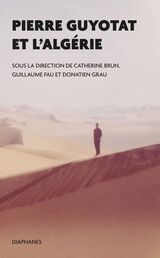 Pierre Guyotat et l’Algérie
Edited by Catherine Brun, Guillaume Fau, and Donatien Grau
Diaphanes, 2024 Pierre Guyotat est une figure majeure, avant même Tombeau pour cinq cent mille soldats et bien au-delà, de la mémoire de la guerre d’indépendance algérienne. Idiotie est l’une des œuvres récentes les plus importantes sur ce sujet. C’est le fait de la guerre, vécue en appelé jugé récalcitrant et mis au cachot, mais aussi des voyages post-indépendance, de la rencontre avec la langue, la géologie, la faune et la flore algériennes, de la défense publique de Mohamed Laïd Moussa. Les fictions, les carnets sont marqués par l’empreinte de la terre, des langues, des corps algériens. Guyotat contribua aussi à établir, dans la création et l’action publique, des relations nouvelles avec l'Algérie, ses auteurs, comme avec celles et ceux qui, en France, venaient de ce pays. Cet ouvrage offre la parole à des figures de la recherche et de la création issues d’Algérie, de France et d’ailleurs. Il permet de découvrir un regard unique sur l’Algérie, affectueux et savant, celui d’un des plus grands auteurs de langue française. Contributions de Ferroudja Allouache, Amina Azza Bekkat, Catherine Brun, Donatien Grau, Denis Hollier, Karima Lazali, Gérard Nguyen Van Khan, Philippe Roger, Tiphaine Samoyault, Nadia Sebkhi, Todd Shepard, Noura Wedell.
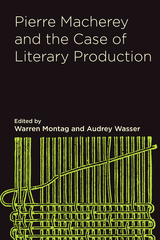 Pierre Macherey and the Case of Literary Production
Edited by Warren Montag and Audrey Wasser
Northwestern University Press, 2022 This collection revisits A Theory of Literary Production (1966) to show how Pierre Macherey’s remarkable—and still provocative—early work can contribute to contemporary discussions about the act of reading and the politics of formal analysis. Across a series of historically and philosophically contextualized readings, the volume’s contributors interrogate Macherey’s work on a range of pressing issues, including the development of a theory of reading and criticism, the relationship between the spoken and the unspoken, the labor of poetic determination and of literature’s resistance to ideological context, the literary relevance of a Spinozist materialism, the process of racial subjectification and the ontology of Blackness, and a theorization of the textual surface. Pierre Macherey and the Case of Literary Production also includes three new texts by Macherey, presented here in English for the first time: his postface to the revised French edition of A Theory of Literary Production; “Reading Althusser,” in which Macherey analyzes the concept of symptomatic reading; and a comprehensive interview in which Macherey reflects on the historical conditions of his early work, the long arc of his career at the intersection of philosophy and literature, and the ongoing importance of Louis Althusser’s thought.
Recent translations of Macherey’s work into English have introduced new readers to the critic’s enduring power and originality. Timely in its questions and teeming with fresh insights, Pierre Macherey and the Case of Literary Production demonstrates the depths to which his work resonates, now more than ever.
Pierre, or The Ambiguities: Volume Seven
Herman Melville
Northwestern University Press, 1995 Initially dismissed as "a dead failure" and "a bad book," and declined by Melville's British publisher, Pierre has since struck critics as modern in its psychological probings and literary technique--fit, as Carl Van Vechten said in 1922, to be ranked with The Golden Bowl, Women in Love, and Ulysses. None of Melville's other "secondary" works has so regularly been acknowledged by its most thorough critics as a work of genuine grandeur, however flawed.
When Pierre Glendinning's lifelong desire for a sister is seemingly realized on the eve of his marriage, his world is suddenly turned upside down, for he must choose between acknowledging his illegitimate half-sister or perpetuating his unsullied family legacy. Melville unfolds the story of an idealistic young man whose steadfast beliefs lead him to destroy his world and himself.
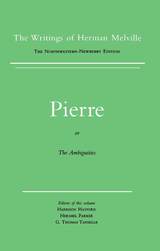 Pierre, or The Ambiguities: Volume Seven, Scholarly Edition
Herman Melville
Northwestern University Press, 1971 Initially dismissed as "a dead failure" and "a bad book," and declined by Melville's British publisher, Pierre, or The Ambiguities has since struck critics as modern in its psychological probings and literary technique--fit, as Carl Van Vechten said in 1922, to be ranked with The Golden Bowl, Women in Love, and Ulysses. None of Melville's other "secondary" works has so regularly been acknowledged by its most thorough critics as a work of genuine grandeur, however flawed.
This scholarly edition aims to present a text as close to the author's intention as the surviving evidence permits. Based on collations of the two issues and the two impressions of the single edition publishing in Melville's lifetime, it incorporates necessary emendations made by the series editors. This text of Pierre is an Approved Text of the Center for Editions of American Authors (Modern Language Association of America).
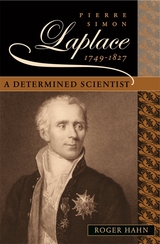 Pierre Simon Laplace, 1749–1827: A Determined Scientist
Roger Hahn
Harvard University Press, 2005 Often referred to as the Newton of France, Pierre Simon Laplace has been called the greatest scientist of the late eighteenth and early nineteenth centuries. He affirmed the stability of the solar system and offered a powerful hypothesis about its origins. A skillful mathematician and popular philosopher, Laplace also did pioneering work on probability theory, in devising a method of inverse probabilities associated with his classic formulation of physical determinism in the universe. With Lavoisier and several younger disciples, he also made decisive advances in chemistry and mathematical physics.
Roger Hahn, who has devoted years to researching Laplace's life, has compiled a rich archive of his scientific correspondence. In this compact biography, also based in part on unpublished private papers, Hahn follows Laplace's journey from would-be priest in the provinces to Parisian academician, popularizer of science during the French Revolution, religious skeptic, and supporter of Napoleon. By the end of his life, Laplace had become a well-rewarded dean of French science.
In this first full-length biography, Hahn illuminates the man in his historical setting. Elegantly written, Pierre Simon Laplace reflects a lifetime of thinking and research by a distinguished historian of science on the fortunes of a singularly important figure in the annals of Enlightenment science.
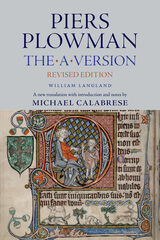 Piers Plowan: The A Version, Revised Edition
William Langland
Catholic University of America Press, 2023 Passionate about trying to create social justice in a time of crisis after the Black Plague, William Langland spent his entire life working on Piers Plowman, an epic study of the human quest for truth, justice, and community. The "A Version," the first and shortest of the three versions he crafted, is wonderfully relatable and completely teachable to a modern student audience. Piers Plowman is becoming ever more relevant to students and scholars in English studies. Perhaps because the poem involves culture, religion, community, and work and engages explicitly with the histories of government and popular revolt, this allegorical tale of a wandering Christian named "Will," searching for truth with the aid of a humble plowman named Piers, has found new critical and pedagogic life in the last 20 years. Currently there are no translations of the A-version of Piers Plowman in print, so readers, scholars and teachers have been longing for an affordable, student-centered translation. The apparatus includes a 30-page historical and critical introduction, footnotes, a bibliography, a note on translation theory and practice, and samplings of the original text in Middle English, with a guide to pronunciation of that language.
Piers Plowman is an extraordinary important document about the issues dramatically relevant to this day. It confronts poverty and inequity in 14th-century England and explores the need for virtue and social justice, encouraging its readers to create equality with open access for people of all classes and abilities. Though a Christian poem, Piers addresses issues of inclusivity, social responsibility and communal duty, as the poem’s protagonist wanders about the world, facing injustice and persecution as he looks for truth and salvation. Michael Calabrese, author of An Introduction to Piers Plowman and director of the Chaucer Studio’s Middle English recording of the poem, brings Piers Plowman to life for 21st-century students and for all readers interested in the history of society, virtue, faith and salvation.
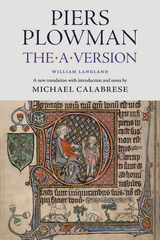 Piers Plowman: The A Version
William Langland
Catholic University of America Press, 2020 Passionate about trying to create social justice in a time of crisis after the Black Plague, William Langland spent his entire life working on Piers Plowman, an epic study of the human quest for truth, justice, and community. The “A Version,” the first and shortest of the three versions he crafted, is wonderfully relatable and completely teachable to a modern student audience. Piers Plowman is becoming ever more relevant to students and scholars in English studies. Perhaps because the poem involves culture, religion, community, and work and engages explicitly with the histories of government and popular revolt, this allegorical tale of a wandering Christian named “Will,” searching for truth with the aid of a humble plowman named Piers, has found new critical and pedagogic life in the last 20 years. Currently there are no translations of the A-version of Piers Plowman in print, so readers, scholars and teachers have been longing for an affordable, student-centered translation. The apparatus includes a 30-page historical and critical introduction, footnotes, a bibliography, a note on translation theory and practice, and samplings of the original text in Middle English, with a guide to pronunciation of that language.
Piers Plowman is an extraordinary important document about the issues dramatically relevant to this day. It confronts poverty and inequity in 14th-century England and explores the need for virtue and social justice, encouraging its readers to create equality with open access for people of all classes and abilities. Though a Christian poem, Piers addresses issues of inclusivity, social responsibility and communal duty, as the poem’s protagonist wanders about the world, facing injustice and persecution as he looks for truth and salvation. Michael Calabrese, author of An Introduction to Piers Plowman and director of the Chaucer Studio’s Middle English recording of the poem, brings Piers Plowman to life for 21st-century students and for all readers interested in the history of society, virtue, faith and salvation.
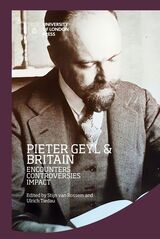 Pieter Geyl and Britain: Encounters, Controversies, Impact
Edited by Stijn van Rossem and Ulrich Tiedau
University of London Press, 2022 An examination of the work and influence of historian Pieter Geyl.
Pieter Geyl (1887—1966) was undoubtedly one of the most internationally renowned Dutch historians of the twentieth century, but also one of the most controversial. Having come to the United Kingdom as a journalist, he started his academic career at the University of London in the aftermath of World War I and played an important role in the early days of the Institute of Historical Research. Known in this time for his reinterpretation of the sixteenth-century Dutch Revolt against the Habsburgs that challenged existing historiographies of both Belgium and the Netherlands but was also linked to his political activism in favor of the Flemish movement in Belgium, Geyl left his stamp on the British perception of Low Countries history before moving back to his country of origin in 1935. Having spent World War II in German hostage camps, he famously coined the adage of history being “a discussion without end” and reengaged in public debates with British historians after the war, partly conducted on the airwaves of the BBC. A prolific writer and an early example of a public intellectual, Geyl remains one of the most influential thinkers on history of his time. The present volume reexamines Geyl’s relationship with Britain (and the Anglophone world at large) and sheds new light on his multifaceted work as a historian, journalist, homme de lettres, and political activist.
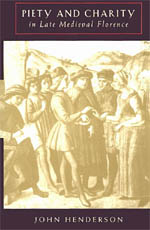 Piety and Charity in Late Medieval Florence
John Henderson
University of Chicago Press, 1997 John Henderson examines the relationship between religion and society in late medieval Florence through the vehicle of the religious confraternity, one of the most ubiquitous and popular forms of lay association throughout Europe. This book provides a fascinating account of the development of confraternities in relation to other communal and ecclesiastical institutions in Florence. It is one of the most detailed analyses of charity in late medieval Europe.
"[A] long-awaited book. . . . [It is] the most complete survey of confraternities and charity, not only for Florence, but for any Italian city state to date. . . . This book recovers more vividly than other recent works what it meant to be a member of a confraternity in the late middle ages."—Samuel K. Cohn, Jr., Economic History Review
"Henderson offers new and fascinating information. . . . A stimulating and suggestive book that deserves a wide readership." —Gervase Rosser, Times Higher Education Supplement
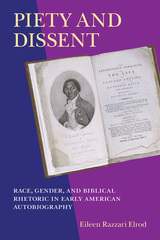 Piety and Dissent: Race, Gender, and Biblical Rhetoric in Early American Autobiography
Eileen R. Elrod
University of Massachusetts Press, 2008 For pious converts to Christianity in late eighteenth- and early nineteenth-century New England, all reality was shaped by religious devotion and biblical text. It is therefore not surprising that earnest believers who found themselves marginalized by their race or sex relied on their faith to reconcile the tension between the spiritual experience of rebirth and the social ordeal of exclusion and injustice. In Piety and Dissent, Eileen Razzari Elrod examines the religious autobiographies of six early Americans who represented various sorts of marginality: John Marrant, Olaudah Equiano, and Jarena Lee, all of African or African American heritage; Samson Occom (Mohegan) and William Apess (Pequot); and Abigail Abbott Bailey, a white woman who was subjected to extreme domestic violence. Through close readings of these personal narratives, Elrod uncovers the complex rhetorical strategies employed by pious outsiders to challenge the particular kinds of oppression each experienced. She identifies recurrent ideals and images drawn from Scripture and Protestant tradition—parables of liberation, rage, justice, and opposition to authority—that allowed them to see resistance as a religious act and, more than that, imbued them with a sense of agency. What the life stories of these six individuals reveal, according to Elrod, is that conventional Christianity in early America was not the hegemonic force that church leaders at the time imagined, and that many people since have believed it to be. Nor was there a clear distinction between personal piety and religious, social, and political resistance. To understand fully the role of religion in the early period of American letters, we must rethink some of our most fundamental assumptions about the function of Christian faith in the context of individual lives.
|
|

